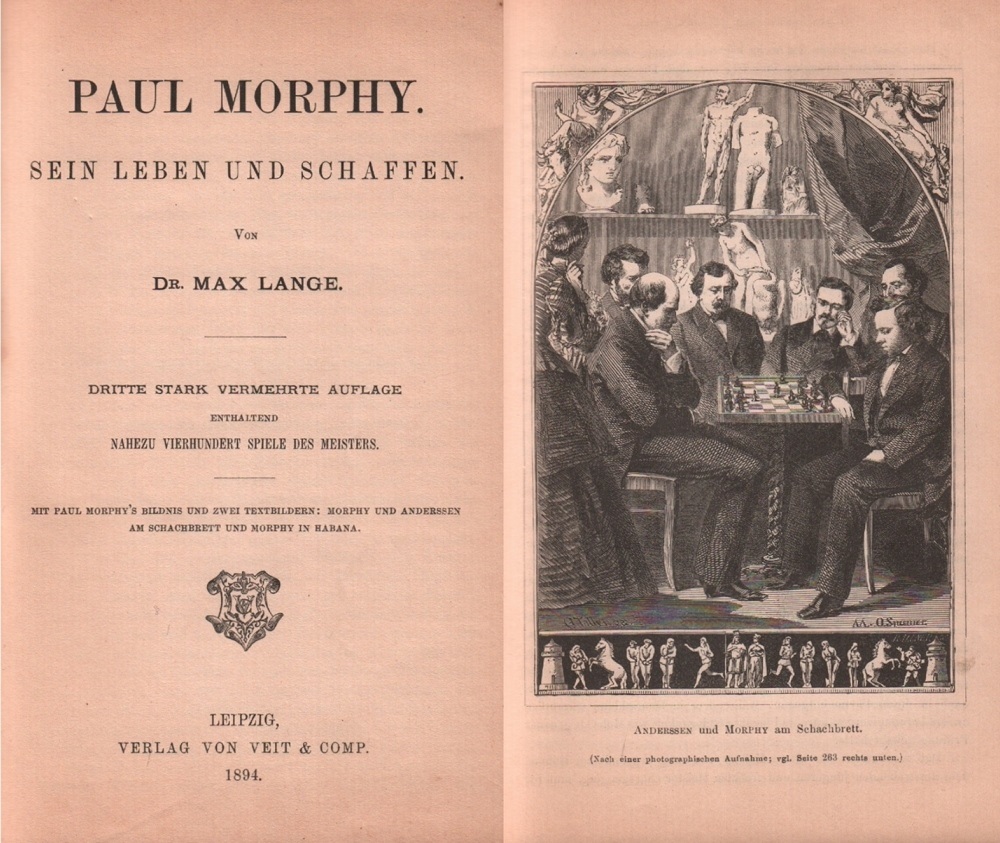
Edward Winter

The present general article on Paul Charles Morphy does not repeat material in our other articles on him, i.e.:
The Staunton v Morphy controversy
Paulsen v Morphy, New York, 1857
Morphy v the Duke and Count
Why ‘Morphy’s Defence’?
The Pride and Sorrow of Chess
Paul Morphy and Chess Politics
A Problem by Paul Morphy
The Caissa-Morphy Puzzle
Early Uses of ‘World Chess Champion’
***
From James J. Barrett (Buffalo, NY, USA):
‘In D.J. Morgan’s BCM “Quotes and Queries” for July 1953 we find Q&Q 47, a query from Bruce Hayden, who asks two questions about Paul Morphy, the second being: “Is there in existence a book of the First American Chess Congress, 1857 (won by Morphy)?” To this Morgan adds, “Any help readers, please?” How could the erudite Morgan and Hayden not know this? It is quite incomprehensible, especially when the answer is so easily found in bibliographies, textual references to it in Morphy articles, etc., etc. No less personages than H.J.R. Murray and K. Whyld responded to the query, in the September issue.’
A curious double oversight, indeed, though surely one that could not occur today – thanks to Olms. Mr Barrett also points out that the list of references in P.W. Sergeant’s Morphy games collection does not include Fiske’s New York, 1857 book.
(1326)
With reference to the ‘forgotten’ New York, 1857 tournament book, Bob Meadley (Narromine, NSW, Australia) mentions that few chess bibliographies were available in 1953. The Hague Catalogue appeared in 1955 and the Cleveland Catalogues in 1964, while van der Linde’s books were rather rare:
‘Personally I like the style of involving readers in doing research rather than the editor always offering answers. Morgan’s Q&Q was very pleasant reading. ... I guess it boils down to column deadlines, research already carried out on other items in the column and a wish to ask questions.’
We have a question of our own regarding the New York, 1857 book. On page 235 of Paul Morphy The Pride and Sorrow of Chess David Lawson reports that it was published ‘at long last’ on 10 September 1859, and adds: ‘At this point, games of the Congress, including Morphy’s, were made public for the first time, released from the restrictions of the Congress rules.’ Yet games from the event seem to have been freely published in the press during the intervening two years. What, then, were the exact circumstances of the embargo?
(1353)
In March 1993 Caissa Editions brought out Paul Morphy and the Evolution of Chess Theory by Macon Shibut. In a sense, it complements David Lawson’s extensive biography of 1976, which paid little attention to Morphy’s games. An underlying argument in Macon Shibut’s book is that they have seldom been accorded sufficient analytical attention, and he puts his case well (page 8):
‘Annotators who want to educate or entertain are not interested in tearing apart an instructive Morphy combination. Rather, they want to find characteristic errors in the opponents’ play, and they want the hero’s consequent victory to seem a matter of course (and the more elegantly achieved, the better). The effect of such presentations in countless beginner’s texts has been to reduce Morphy’s games to a collection of fables.’
The writings on Morphy of Steinitz and Réti are reviewed critically, and there is much original analysis. The author goes badly astray in the misnamed ‘Complete Games’ section, overlooking that Lawson gave more than 60 neglected Morphy games in the BCM of August 1978 and September 1979.
One matter of detail: Shibut’s game 368 (Morphy v Maurian at queen’s knight odds) is labelled New Orleans, 1866 and said to have been drawn shortly after move 41. However, Lawson (BCM, September 1979, page 414) asserted that the game was played in New Orleans on 9 May 1864 and that Morphy resigned after Black’s 30th move. The absence of game sources in both the Shibut book and the Lawson articles makes it hard to investigate the discrepancy.
(1966)
Reproducing the above C.N. item on pages 351-352 of Kings, Commoners and Knaves, we added a footnote with regard to the penultimate paragraph:
Alerted to this omission, the publisher brought out a 15-page addendum later in 1993.
Charles Maurian (American Chess Bulletin, September 1911, page 197)
The final paragraph of C.N. 1966 (see above) referred to contradictory versions of a game between Morphy and Maurian. We have now found the score in a nineteenth-century source: it was the first of three Morphy games ‘recently published for the first time in the New Orleans Times-Democrat’ which appeared on pages 90-91 of the 15 March 1887 issue of the Brooklyn Chess Chronicle. The date indicated (9 May 1864) corresponds to Lawson’s, and the conclusion is given as 30...Bxf2+ ‘and Black wins’.
The third of these games is relevant to a matter raised by John T. Campbell (Arlington, VA, USA), who asks us about the accuracy of the following passage on page 76 of Blackmar-Diemer Gambit by Eric Schiller (Coraopolis, 1986):
‘In an article “Paul Morphy – Spiritual Father of the Blackmar-Diemer Gambit” Diemer makes reference to the game Morphy-Blackmar, New Orleans 1866, which saw [1 d4 d5 2 e4 e6] 3 Nh3!?. Now this is a move in true gambit style. After 3...dxe4 4 Bc4 Nf6 5 O-O b6 7 6 f3 e3 7 Bxe3 Be7 White has reestablished material equilibrium.’
We have no knowledge of Morphy playing Blackmar, but page 91 of the Brooklyn Chess Chronicle of 15 March 1887 has a queen’s knight odds game between Morphy and C.A. Maurian, played at New Orleans in 1866, which followed the same line as far as 7 Bxe3 Be7. At move six a note says: ‘As the New Orleans Times-Democrat remarks, the position is now very similar to one that occurs in the Blackmar Gambit.’ The Chronicle gives the opening moves as 1 e4 d5 2 d4 e6, but 1 e4 e6 2 d4 d5 3 Nh3 is the order in later sources.
(2044)
Tom V. Purser (Headland, AL, USA) reports that on pages 14-15 of issue 31 of his periodical Blackmar-Diemer Gambit World (May 1988) he and Anders Tejler discussed the question raised in C.N. 2044, concluding that the erroneous idea of a game between Morphy and Blackmar arose from a faulty reading by Eric Schiller of page 164 of E.J. Diemer’s (reprinted) book Das moderne Blackmar-Diemer Gambit (Heidelberg, 1976).
From pages 30-31 of Life of Paul Morphy in the Vieux Carré of New-Orleans and Abroad by Mrs Regina Morphy-Voitier (New Orleans, 1926):
‘Another mania which lasted a while, was walking up and down the long verandah of his home, his hands behind his back and muttering these words in a low voice: “Il plantera la bannière de Castille sur les murs de Madrid au cri de Ville gagnée, et le petit Roi s’en ira tout penaud.” (“He will plant the banner of Castile upon the walls of Madrid to the cry of victorious [sic – gagnée means ‘won’] city, and the little King will go away looking very sheepish.”) He did not know that he was being overheard, nor was it ever known what he meant by these words.’
(2026)
C.N. 2026 quoted faithfully from the book by Morphy’s niece (including the mistranslation of ‘victorious city’ for ‘Ville gagnée’), but it is worth noting that slightly different English versions of Morphy’s words appeared on page 30 of Morphy Gleanings by P.W. Sergeant and on page 299 of David Lawson’s Paul Morphy The Pride and Sorrow of Chess.
(2030)
John Townsend (Wokingham, England) writes:
‘Has anyone tried to relate these words to events in Spanish history? Presumably, there are only a limited number of occasions when Madrid could be referred to as ville gagnée, captured by Castilians. One instance is its conquest by Alfonso VI of León and Castile in 1085. The Moorish king at that time, Boabdil, was nicknamed el rey chico, which calls to mind the words attributed to Morphy (“le petit roi”). If Morphy was alluding to this event, then why? He had Castilian ancestry on his father’s side.’
(11972)
See too C.N. 5559.
Did Paul Morphy take more than an hour to solve this problem, to the incredulity of Alekhine, who solved it almost instantly?
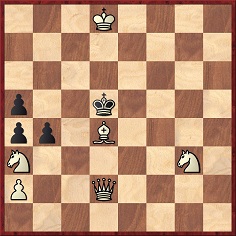
Mate in three
See A Chess Washout.
Ignacio Vidau Cabal (Gijón, Spain) asks how many games Morphy and Löwenthal contested in New Orleans in 1850. Some sources state two, others three.
C.N. 1015 pointed out that extensive research by David Lawson on pages 24-35 of his 1976 biography of Morphy had demonstrated that there were three games. On the other hand, although Paul Morphy, partidas completas (Madrid, 1993) by the error-prone Rogelio Caparrós purports to give the scores of three games, two of them (the draw on page 19 and the Morphy win on page 20) are virtually identical. The score of the third game has never been found.
(2081)
The June [1985] BCM correspondence column has a contribution from Raymond Keene which we recommend all C.N. readers to study with close attention. This is not the place for disproof of his letter, but we cannot resist quoting its conclusion:
‘... what annoys me about E.G. Winter’s criticism is that he wields the accusation “error” rather too often against other writers, instead of accepting that they may have weighed up the available evidence and come to their own conclusion!’
An intriguing comment from the person who (forgive us for mentioning it again) accused us in the October 1984 CHESS of ‘factual inaccuracies’ without a scrap of justification.
It seems an appropriate moment to raise some further issues:
a) How many games were played in the 1927 world championship match? The obvious reply is 34, but on page 14 of his 1978 Karpov-Korchnoi book Mr Keene claims 35. As he does again on page 124 ... and yet again on page 138. A triple error? Perhaps, but let us suspend judgement until Mr Keene submits his evidence, ideally a 35th game-score.
b) His article ‘Reflections on Montreal’ (BCM August 1979, page 358) has a ‘Table V’ with an ‘Age of Winner’ column for certain major tournaments. Mr Keene appears to have made seven errors out of ten references – but has he? It could be that he has discovered that the world champions were not born when we all thought they were. Jeremy Gaige should stand by.
c) Batsford’s two classic reprints are superbly produced but cheapened by bad introductions by Mr Keene. For the prestigious Staunton Handbook he has more or less just lifted two chunks out of the BCM Staunton book (pages v and 15 – written by him or by R.N. Coles?). However, it is the introduction to Löwenthal’s Morphy collection that is relevant here, and above all Mr Keene’s treatment of M.’s games with L. himself. R.D.K. states that Morphy was 13 (instead of 12, as given correctly in the book itself, page 350) and says only two games were played. That is what used to be believed but David Lawson’s biography went into the matter in enormous depth to show that there were three games (pages 24-35). Then Raymond Keene claims this Löwenthal collection was ‘endorsed by Morphy himself’. Headlong into another trap. In fact, the preface thought to be by Morphy was not written by him (Lawson, page 30) and ‘Morphy knew nothing about the Bohn edition’ (same page). Instead of getting everything wrong, Mr Keene might have given attention to the fact that the ‘drawn’ Petroff Defence game (Löwenthal, pages 352-355) was actually a win for Morphy, as demonstrated by Lawson. We would hardly dare suggest that Mr Keene was unaware of all this research when penning his introduction, so we look forward to seeing the counter-evidence that convinced him – after tireless weighing-up – that Lawson is not to be believed.
(1015)
Referring to the 1858 match between Morphy and Anderssen, Frank Skoff (Chess Life & Review, October 1979, page 570) described it as ‘the only important match in chess history played for honor alone’.
(2324)
Page 379 of the December 1887 International Chess Magazine had this position, taken from the Irish Chess Chronicle:
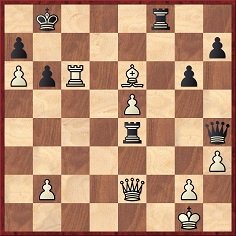
J. Morphy-P. Rynd, Dublin, 1887 (?)
White to move
1 Qf3 Re1+ (1…Qf4 is noted as leading to a probable draw.) 2 Kh2 Qe7 3 Rc7 Re5 and White announced mate in four, beginning with 4 Rb7+.
‘The play of Mr Morphy in this fine ending would be worthy of his great namesake’, declared Steinitz.
(2325)
Readers will be familiar with the brevity (queen’s rook odds, New Orleans, 1858) in which Morphy gave mate by castling. In all the sources that we have consulted the loser is an anonymous amateur, but when the game appeared on page 174 of the October 1878 American Chess Journal it was introduced as follows:
‘The following short game, given as an unpublished one by the great Paul Morphy, we extract from a recent Globe Democrat, to where it was contributed by Judge Ballard, of Louisville, who is supposed to be the amateur; we do not remember ever to have seen a similar termination occur in actual play.’
(2731)
Alfred Wallace (St Louis, MO, USA) kindly provides Benjamin R. Foster’s introductory text from the 29 September 1878 Sunday Supplemental Sheet of the Globe Democrat:
‘The following game, which has never been published, was kindly forwarded to us by one of our constant contributors, to whom it was sent by Judge Ballard, of Louisville, who is supposed to be the amateur. It is very remarkable in its termination, Paul Morphy actually mating by castling. We take great pleasure in giving to the public this game, as it is another evidence of the wonderful intellect of the world’s chess champion.’
(2739)
From an article on Morphy by J.A. Galbreath (American Chess Bulletin, October 1909, pages 219-224):
‘It has been truly said that Morphy was at once the Caesar and the Napoleon of chess. He revolutionized chess. He brought life and dash and beauty into the game at a time when an age of dulness was about to set in and he did this at a stroke. Then he quit forever. Only two years from the beginning to the end. The negotiations for some modern matches have taken that long!’
Louis Blair (Keyser, WV, USA) asks whether any pre-Buck references exist for the following statement from Buck’s Paul Morphy. His Later Life (page 20) which was quoted on page 24 of Morphy’s Games of Chess by P.W. Sergeant:
‘Shortly after reaching New Orleans Morphy issued a final challenge, offering to give the odds of pawn and move to any player in the world …’
The Buck passage (which referred to late 1859) continued by claiming: ‘… and receiving no response thereto he declared his career as a chessplayer finally and definitely closed, a declaration to which he held with unbroken resolution during the whole remainder of his life.’
(2890)
Louis Blair submits two further texts regarding Morphy. The first is from the column entitled ‘The Chess Board’ in the Philadelphia Sunday Times of 1 June 1890, where E.L. Townsend was quoted as follows: ‘In November 1858 ... I asked Mr Morphy how he regarded Harrwitz as a chess expert. He replied: “Mr Harrwitz plays chess as well as myself, but I think my advantage lies in the fact that I can see eight moves ahead when he only sees seven moves”.’
The second quotation is from page 59 of the Chess World, 1866 (a magazine edited by Staunton):
‘This contest [between G.H. Mackenzie and G. Reichhelm] promises to be of itself the most interesting that has taken place in this country for years, and will derive additional importance from the fact that it may be looked upon as a trial of arms for the championship of the United States; for, as Mr Morphy no longer considers himself a chessplayer, there is no reason why others should do so. He has withdrawn himself from the chess world as something too good for contact with it. Chessplayers, in self-respect, are returning the compliment by leaving the pseudo-champion severely alone.’
It is worth recalling here the words of G.H. Diggle on pages 635-636 of the December 1980 BCM:
‘… [in 1865] Staunton (over a decade after his retirement from the Chess Player’s Chronicle and a quarter of a century after launching the magazine) suddenly reappeared as Editor of a new periodical – the Chess World. But both the actual “Chess World” and Staunton himself had aged since he brought out his first number of the Chronicle. Then he was a young and adventurous pioneer, the hero of adventurous followers – now, a long deposed and ailing monarch. Though actually only 55 years old, his heart trouble frequently forced him to lay aside his pen; and the frustration caused by his physical state being no longer able to cope with the demands of his vigorous intellect had turned him into something very like Henry VIII in his last phase. While he could still comment on occasion with shrewdness and penetration on the chess affairs of the day (in particular the Steinitz-Anderssen match of 1866) he became more and more caustic and unfair to the younger generation, both in the Chess World and his weekly Illustrated London News column.’
(2891)
From an article by G.H.D. on pages 184-187 of the July 1958 BCM:
‘Though himself the last of the romantic world champions, Morphy by his victories swept away for ever many of the romantic myths and obsolete beliefs that had long obsessed a chess world which was always living in the past. Prior to his advent, it had always been held that no chess generation could ever be as good as the previous one – no champion as strong as his predecessor of 20 years back. Staunton might be “worthy to succeed McDonnell”; McDonnell “might have almost aspired to play with Mr Lewis”; Labourdonnais might have “become too strong to receive the ‘pawn and two’ from his chess-master Deschapelles” – but it never seemed to occur to anyone that the younger player could really have knocked the old one’s head off. Had “grandmasters” been invented in those days, they would have qualified for that elephantine title only by having been dead for at least 25 years, or by having successfully evaded all challenges after negotiations dragged out for a similar period. Morphy finally disposed of this cult, and it was at long last realized by writers like Walker that a champion had arisen who might possibly be superior to Philidor.’
(2896)
Below is a miniature won by Paul Morphy’s uncle which has been disregarded by various writers on the Evans Gambit:
Ernest Morphy – E.A. Dudley
Occasion?
Evans Gambit Accepted
1 e4 e5 2 Nf3 Nc6 3 Bc4 Bc5 4 b4 Bxb4 5 c3 Ba5 6 d4 exd4 7 O-O Bb6 8 cxd4 d6 9 Nc3 Na5
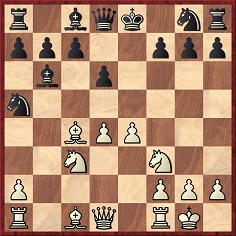
10 Bxf7+ (‘This move – invented by me – is no doubt risky but it prevents Black from castling and brings all White’s pieces into play. I am often successful with it, and the defence is very critical.’ – E. Morphy) 10…Kxf7 11 Ng5+ Ke8 12 e5 d5 13 e6 Qf6 14 Nxd5 Qxd4 15 Nxc7+ Kf8 16 Ba3+ Ne7 17 Qf3+ Qf6 18 Bxe7+ Resigns.
Source: La Stratégie, 15 May 1867, pages 112-113.
(2897)
We are convalescing satisfactorily after an overdose of Chris Ward’s cheerfully unfledged prose in the April 2003 CHESS, and our masochism has even extended to re-reading the first page of his 1997 book The Genius of Paul Morphy: ‘Once upon a time there was a man who won a lot of games of chess ...’, … ‘even if I say so myself, it’s a pretty good selection …’, ‘… I have never really been a historian …’, etc. etc. Yet it is only proper to acknowledge that Ward’s is not the worst-written book on Morphy. That distinction has to go to Paul Morphy partidas completas by Rogelio Caparrós (Ediciones Eseuve, Madrid, 1993).
The back cover calls it ‘una extraordinaria tarea de investigación’, yet there is no sign that Caparrós himself found a single ‘unknown’ Morphy game. He writes: ‘We used only four main sources for the games, thought [sic] we examined a large number of books on Morphy, but they do not contain any new material.’
The book is supposedly bilingual (‘we translated most of the text to two languages: Spanish and English’), and here we refer only to its introductory pages. The title of David Lawson’s book comes out various ways, including Morphy: The Pride and “Ssorrow” of Chess. Other Morphy games are taken by Caparrós from articles by Lawson in the ‘Brtish’ Chess Magazine. Caparrós refers to the ‘ganes’ of Morphy and ‘blinfolded’ games.
Philip W. Sergeant wrote Morphy’s Games of Chess, but in various places Caparrós gives ‘Phillip’, ‘Sargeant’ and ‘Morphy’s Best Games’. In a passage where P.W.S.’s name, at least, is correct, Caparrós writes: ‘The games of this collection have been rearranged in a way somewhat different as in the most common book, Morphy’s Best Games, of Sergeant.’ That volume, we are told, ‘fails [sic] short because the number of games was limited to 300, allowing the prejudices of the notable British author, to excise the games of Morphy of dubious quality’. The next paragraph calls another book by Sergeant, Morphy Gleanings, ‘Morphy’s Gleanings’. Elsewhere it comes out as ‘Morphy Gleaningas’.
(2902)
The various Morphy monographs consulted by us give the second match-game between Morphy and Harrwitz (Paris, 1858) as follows:
1 e4 e5 2 Nf3 d6 3 d4 exd4 4 Qxd4 Nc6 5 Bb5 Bd7 6 Bxc6 Bxc6 7 Bg5 Nf6 8 Nc3 Be7 9 O-O-O O-O 10 Rhe1 h6 11 Bh4 Ne8 12 Bxe7 Qxe7 13 e5 Bxf3 14 gxf3 Qg5+ 15 Kb1 dxe5 16 Rxe5 Qg2 17 Nd5 Qxh2 18 Ree1 Qd6 19 Rg1 Kh7 20 Qe3 f5 21 Nf4 Qb6 22 Qe2 Rf7 23 Qc4 Qf6 24 Nh5 Qe7 25 Rde1 Qd7 26 a3 Nd6 27 Qd4 Rg8 28 Rg2
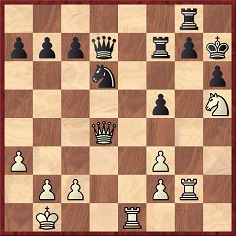
28…Ne8 29 Qc3 f4 30 Rh1 g6 31 Rhg1 Qd5 32 Qe1 Qxh5 33 Rg5 Qxf3 34 Qe6 Rf6 35 Qe7+ Rg7 36 Qxe8 hxg5 37 Qe1 Qc6 and wins.
However, we note that Harrwitz himself stated that from the above diagram the game went:
28…b6 29 Reg1 Ne8 30 Qc3 f4 31 Rh1 g6 32 Rhg1 Qd5 33 Qe1 Qxh5 34 Rg5 Qxf3 35 Qe6 Rf6 36 Qe7+ Rg7 37 Qxe8 hxg5 38 Qe1 Qc6 39 f3 Re6 40 Qf2 Rge7 and wins.
Source: Lehrbuch des Schachspiels by D. Harrwitz (Berlin, 1862), page 107.
Staunton also gave this latter version of the game-score in his Illustrated London News column of 2 October 1858.
(3113)
Morten Hansen (Frederiksberg, Denmark) has pointed out to us the following paragraph about Morphy on page 105 of G. Ståhlberg’s book Strövtåg i schackvärlden (Skara, 1965):
‘The first signs of mental illness, which was probably the result of syphilis contracted in Paris, could be observed in the following years. During the Civil War he lived in Havana and Paris. He later returned to New Orleans. His mental illness grew worse, but when his family once tried to have him committed to an institution he gave such sensible and lucid answers to all the questions that he was not accepted as a patient.’
Ståhlberg’s grounds, if any, for the suggestion about syphilis are unknown to us, but some documentary evidence does exist to corroborate his other remarks. Pages 293-294 of Paul Morphy The Pride and Sorrow of Chess by David Lawson quoted from Charles Maurian’s letter about Morphy in the Watertown, New York Re-Union of December 1875:
‘Outside of the persecution question, he remains what his friends and acquaintances have always known him to be, the same highly educated and pleasing conversationalist.
An attempt was made to induce him to remain in the “Louisiana Retreat”, an institution for the treatment of insane persons, but he objected and expounded to all concerned the law that governed his case and drew certain conclusions with such irrefutable logic that his mother thought, and in my opinion very properly, that his case did not demand such extreme measures as depriving him of his liberty, and took him home.’
As regards Morphy’s demise, the following account was given on pages 309-310 of Lawson’s book:
‘On Thursday morning, 10 July 1884, Paul Morphy dressed meticulously as always for his noonday walk but, meeting friends, returned a little later than usual. The weather was very warm, and he went immediately to his bath, which he ordinarily took at one o’clock, and lingered over. But this day his mother thought he was a very long time and finally knocked at the door to inquire. When she received no answer, she opened the door to see his head resting on the side of the bathtub, to which his hands were clinging. He was apparently unconscious.
His mother called out for help, and Dr Meux, who happened to be passing by the house at the moment, came in and tried in vain to restore him to consciousness. Paul Morphy was pronounced dead at 2.30 p.m., 10 July 1884, from congestion of the brain brought on by entering the cold water while very warm after his walk.
The funeral took place the following day at 5 p.m. …’
Although extensive quotation from newspapers and other publications was a feature of Lawson’s book, in the case of Morphy’s death he cited no sources at all. If a reader is able to consult the New Orleans press of the time, we shall be most grateful.
Information will also be welcomed on affirmations (by whom, where and why?) that Morphy committed suicide. In this connection we note a remark by P.W. Sergeant on page 33 of Morphy Gleanings (London, 1932):
‘I see no reason for the suggestion of some writers, including G.C. Reichhelm, that it was a case of suicide – by opening a vein, Reichhelm says.’
(3384)
C.N. 3384 quoted from page 33 of Morphy Gleanings by P.W. Sergeant:
‘I see no reason for the suggestion of some writers, including G.C. Reichhelm, that it was a case of suicide – by opening a vein, Reichhelm says.’
We are still seeking information on where Reichhelm, or any other writers, claimed that Morphy killed himself.
(5101)
David Lawson’s account of Morphy’s death relied heavily on the report in the New Orleans Times-Democrat of 11 July 1884.
Addition on 5 December 2022:
John Townsend informs us that in the 1880 census for New Orleans he has found an entry for John Meux, aged 39, a doctor and a boarder at 280 Franklin Street, born in Louisiana.
For a discussion about yarns concerning Morphy and shoes, see ‘Fun’ and Chess and Insanity.
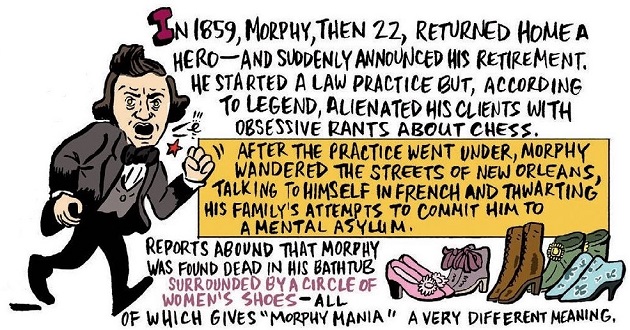
Page 185 of La Stratégie, June 1879 reported that a number of other Parisian publications had mistakenly announced the death of Morphy. On page 345 of its 15 November 1882 issue La Stratégie noted another report involving Morphy, and the consequence was a stinging attack on the press by Alphonse Delannoy on page 8 of La Stratégie, 15 January 1883. (See also page 370 of the December 1882 Deutsche Schachzeitung.)
Moreover, the Pioneer, Allahabad of 25 December 1882 contained a ‘remarkable statement’, i.e. an invention about Morphy being defeated in a match played in India on a board of gold and silver, with pieces composed of precious stones. The quoted report began, ‘Morphy, the celebrated American chess-player, recently deceased, is said to have detested the very name of India, for here he met his match’. This was reported on page 168 of the February 1883 Chess Monthly. Morphy died the following year.
See Chess and Untimely Death Notices.
James J. Barrett (New York, NY, USA) writes:
‘P.W. Sergeant died in 1952. An almost insultingly brief “obituary” appeared in the BCM for November of that year (page 324). No mention of his long connection with the BCM. No mention of Morphy’s Games of Chess. Half a sentence skirts the subject of his considerable non‑chess publications. No mention of his date of birth or death. The only book mentioned is his A Century of British Chess– and, oh yes, “helping R.C. Griffith with two editions of Modern Chess Openings”. The whole tone of this small paragraph that serves as an obituary is cold and unfeeling, and there was no follow-up. There must be a story here. Did he have a falling‑out with the BCM? And I could not find even a mention in CHESS.’
The worst case of brevity must surely be the BCM’s obituary of Réti (July 1929 issue, page 258): seven lines.
(1268)
Capablanca’s obituary in Deutsche Schachblätter (7/8 1942, page 60) was three lines. As far as we can see, the same magazine had made no mention at all of Lasker’s death the previous year.
(1718)
The index to the 1946 volume of the BCM listed 40 obituaries. Fifty years on, in 1996, there were five. What conclusions should be drawn about the present-day health of chessplayers and/or of the BCM?
(Kingpin, 1997)
Most readers will know the following game:
1 e4 e5 2 Nf3 Nc6 3 d4 exd4 4 Bc4 Bb4+ 5 c3 dxc3 6 O-O cxb2 7 Bxb2 Bf8 8 e5 d6 9 Re1 dxe5 10 Nxe5 Qxd1 11 Bxf7+ Ke7 12 Ng6+ Kxf7
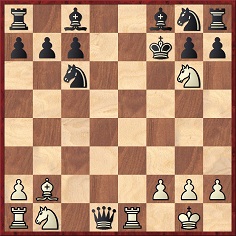
13 Nxh8 mate.
It was published in, for instance, Chernev’s 1000 Best Short Games of Chess (pages 88-89) and Richter’s 666 Kurzpartien (page 91). Both compilers indicated that it was a queen’s knight’s odds game won by Dorasil (opponent, venue and date unknown). Yet at least some of the gaps are fairly easy to fill in: the game-score (C. Dorasil v F. Keitel, played in Troppau ‘some time ago’) was published on page 114 of the April 1899 Deutsche Schachzeitung.
On page 359 of the August 1978 BCM the same game (although with White lacking his queen’s rook) was presented by David Lawson as an unknown Morphy victory against C. Le Carpentier in New Orleans, 1849. Unfortunately Lawson gave no source.
One curiosity we can add here is that the win has also been attributed to an occasional opponent of Morphy’s, Den[n]is Julien (1806-68), with no mention of odds or any other details, except that Black was ‘one of the strongest players in New York’. We are referring to pages 74-75 of Beadle’s Dime Chess Instructor by Miron J. Hazeltine (New York, 1860).
(2859)
The young Morphy’s well-known ‘devilish bad games’ disparagement of Staunton did untold harm to the Englishman’s reputation in the twentieth century. As G.H. Diggle pointed out in C.N. 1932, P.W. Sergeant gave currency to the gibe in three of his books (Morphy’s Games of Chess, Morphy Gleanings and A Century of British Chess).
The remark was subsequently seized upon by various anti-Staunton writers. Here, for example, is a paragraph from page 3 of Al Horowitz’s book from the early 1970s, The World Chess Championship A History:
‘About Staunton as a player it is perhaps impossible to be strictly objective: it is just too incredible that anyone seemingly so weak as he could have achieved such success and exerted such influence for so long. When the book of the tournament at London in 1851 came into the hands of the then 15-year-old Morphy, the lad felt moved to scribble on the title page, under the legend declaring it to be “By H. Staunton, Esq., author of the ‘Handbook of Chess’, ‘Chess-player’s Companion’, etc.” the irreverent parenthesis “(and some devilish bad games)”. Devilish bad they certainly are, and share with their author’s prose style a turgidity that is truly exasperating. The real secret of Staunton’s success was that he picked his opponents carefully – how carefully will soon become apparent. Only once in his life did he fail to be careful enough.’
In Morphy’s Games of Chess (page 5) Sergeant quoted C.A. Buck as the source of the ‘devilish bad games’ story. For the record, we cite below what appeared on pages 7-9 of Buck’s book, Paul Morphy. His Later Life (published in Newport, Kentucky in 1902):
‘As a matter of fact, Morphy did not at any time have the benefit of chess books in the sense of keeping a number of them at hand for study and reference. What few books he made use of he went through quickly [sic] as possible, and after having mastered the contents he gave them away. James McConnel [sic], the elder, of New Orleans, has a book of the tournrment [sic] of 1851 which Morphy gave him when 15 years old. The book had been issued but a short time when Morphy secured this copy. He soon played over all the games and then gave it to his friend. The volume is especially interesting on account of numerous marginal notes in Moprhy’s [sic] own handwriting by which he expressed his opinion of the games and certain moves. As is well known, this book was edited by Staunton, and young Morphy, like a child of genius, made a captious comment on Staunton’s chess play by writing on the title page to make the authorship read like this: “By H. Staunton, Esq., author of the Hand-book of Chess, Chess-Player’s Companion, etc. (and some devilish bad games)”.’
The Buck booklet (30 small pages) was brought out by Will H. Lyons, who wrote in the ‘Publishers Prface’ [sic]:
‘C.A. Buck of Toronto, Kansas is the author of this interesting and comprehensive biography of Paul Morphy. Mr Buck has gathered from authentic sources facts and data in the later life of Morphy that have never been published. Several years were devoted to securing information; a month was then spent in New Orleans verifying and adding to his store of facts; Morphy’s relatives and friends giving him great assistance. The matter first appeared in a prominent Western newspaper. With Mr Buck’s consent, I now offer it in its present form …’
Paul Morphy The Pride and Sorrow of Chess by David Lawson (pages 213-215) gave further particulars of the genesis of Buck’s work and commented that it ‘appears to be responsible for a number of erroneous statements that have been widely accepted’. Lawson listed many examples, but had not mentioned Buck earlier (i.e. on page 42) when (unquestioningly) relating the ‘devilish bad games’ matter.
On page 54 of The Human Side of Chess Fred Reinfeld asserted that Buck was ‘a subsequent owner of Morphy’s copy’ of the Staunton tournament book, but we recall no other claim that the volume owned by James McConnell (1829-1914) passed into Buck’s possession. Nor do we know what happened to McConnell’s books when he died (in New Orleans on 21 November 1914). Perhaps C.N. has a reader in New Orleans who could investigate further.
(2885)
C.N. 2885 included a passage from pages 7-9 of Paul Morphy. His Later Life by C.A. Buck (Newport, 1902):
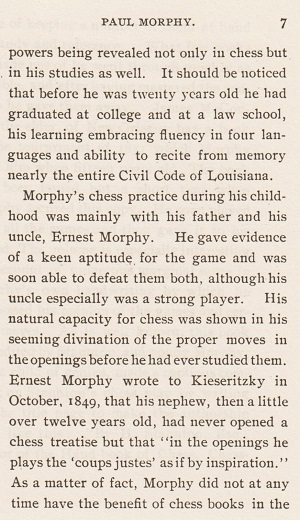
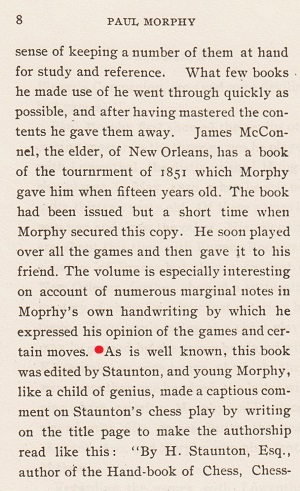
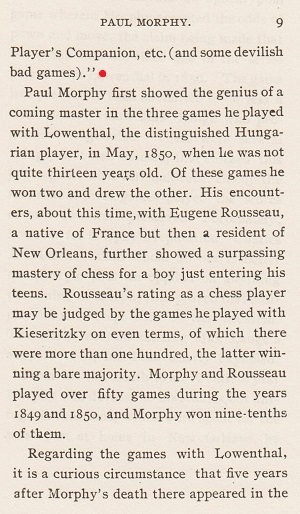
Buck’s text on Morphy had been published on pages 1-7 of the American Chess World, January 1901, introduced as follows:
‘We reprint from the Evening Gazette of Cedar Rapids, Iowa, a biographical sketch of the life of the immortal Morphy, by Mr C.A. Buck, of Toronto, Kansas, who is one of the most enthusiastic and best known chess experts in the Middle West.’
On page 214 of his 1976 biography of Morphy, David Lawson gave 29 December 1900 as the date of the article’s appearance in the Evening Gazette. Can any reader provide a copy?
(10293)
The Cleveland Public Library has provided the article referred to in C.N. 10293 (Evening Gazette of Cedar Rapids, Iowa, 29 December 1900, page 9):
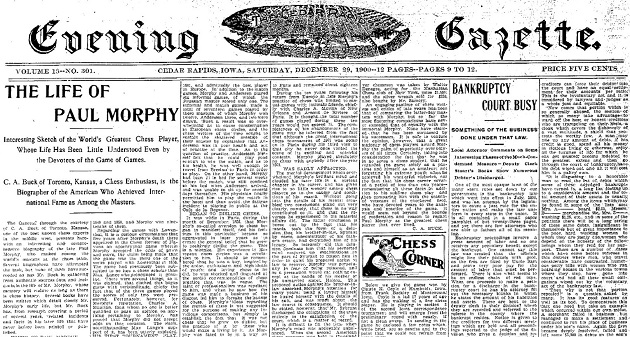
(10353)
Although James Mortimer was well acquainted with Morphy, David Lawson’s book Paul Morphy The Pride and Sorrow of Chess barely mentioned him. Firstly here, we quote a passage about Mortimer on page 66 of the November 1892 issue of Leopold Hoffer’s Chess Monthly:
‘In 1853 he was appointed attaché of the United States Legation in Paris, where he had an opportunity of renewing his acquaintance with Paul Morphy. The two countrymen thus became intimate friends. Both being passionately fond of chess, many hundreds of games were played by the master and pupil – needless to mention who was the master – and to this day Mortimer retains a strong tinge of the dashing and brilliant style of his prototype.’
It is not easy to reconcile Hoffer’s claims that Mortimer knew Morphy prior to the latter’s arrival in Paris and that the two played much chess against each other with Mortimer’s own reminiscences of Morphy on pages 174-175 of the May 1905 BCM:
‘My real introduction to the chess world and most of its modern celebrities dates from 1858, when I was an attaché of the American Legation in Paris.
It was at this period that I first met Paul Morphy, the young American chess genius, whose extraordinary talents had already astonished English lovers of chess and were then causing amazement and admiration amongst the habitués of the Café de la Régence, the famous chess resort of the Parisians and of all professional and amateur votaries of the game visiting the French capital at that brilliant and prosperous period of the Second Empire, following the termination of the Crimean War.
In my hours of leisure, I went almost every day to the Régence, to do a little “woodshifting” with some mazette (duffer) of about my own feebleness, or occasionally to pay half a franc for the privilege of being beaten at the odds of rook or knight by any professional “artist” or strong amateur who would graciously condescend (for fivepence a lesson) to show me “how it was done”. I was Morphy’s fellow countryman, and four years his senior. He had arranged to make Paris his headquarters for a considerable time, and it was not long before we became intimate friends. Paul was a native of New Orleans and, like all scions of the best Louisiana families, spoke French and English perfectly. The son of a judge of the Supreme Court of Louisiana, he was in every respect a gentleman by birth, breeding and education. A lawyer by profession, he never regarded chess otherwise than as a pastime, and rarely played for any pecuniary stake whatever, unless at the express wish of his opponents. In physique he was of diminutive stature and almost effeminate build, except the head, which was large and well developed. His face was that of a boy of 15, with as yet no single vestige of either beard or moustache. As his age was a few months over 21 at the time to which I refer, it is probable that at no period of his life was he destined to become “bearded like the Pard” or, indeed, ever to apply a razor to his boyish face. I remember his gloves were ladies’ fives, and his shoes a child’s size, into which not one woman in a hundred thousand could have squeezed her feet. From this brief description of Paul Morphy’s outer man, when he quietly and modestly appeared among the throng of accomplished chessplayers who then congregated daily and nightly at the Café de la Régence some idea may be formed of the interest and excitement created by his victories over all who challenged him to single combat, and playing blindfold simultaneously against eight of the best players in Paris. I was an eye witness of these various exploits and enjoyed Paul’s triumphs far more than he did himself.
… A match of seven games (draws not counting) was arranged between the young American and Mr Harrwitz, an expert of European reputation. Mr Harrwitz was a deformed little man whose manners were by no means refined and who, after winning the first two games of the match, took no pains to conceal his contempt for Morphy’s abilities as a chessplayer. This want of appreciation, however, turned out to be rather “previous”. Harrwitz scored no more games after the first two and lost five in succession [there was one draw in the sequence], when he resigned the match on the plea of illness. I saw this match from beginning to end and have never forgotten the grotesque contrast between Harrwitz exultant and Harrwitz crestfallen.’
(3366)
See James Mortimer: Chessplayer and Playwright.
Below is our translation of part of an article by J.R. Capablanca published on pages 1-4 of the Uruguayan chess magazine Mundial, May 1927:
Morphy was a great stylist. In the opening he aimed to develop all his pieces rapidly. Developing them and quickly bringing them into action was his idea. In this sense, from the point of view of style, he was completely correct. In his time the question of Position was not properly understood, except by himself. This brought him enormous advantages, and he deserves nothing but praise. It could be said of him that he was the forerunner of developments in this extremely important part of the game. He made a special study of the openings, with such success that in many games his opponents had an inferior position after six moves. This is also praiseworthy since in those days he had little to guide him. Players of the time thought that violent attacks against the king and other combinations of this kind were the only things worthy of consideration. It may be said that they began by making combinations from the first move, without paying sufficient attention to the question of development, about which Morphy was extremely careful. His games show that he had an outstanding playing style. It was simple and direct, without affectation; he did not seek complications but nor did he avoid them, which is the real way to play. He was a good endgame player and proved himself a clever defender of difficult positions. His combinative power was wholly sufficient for what he undertook, but it was not, as most players of today think, the most important aspect of his talent. That was his style, which, as far as could be judged, was perfect.
It is often said that Morphy is the strongest player there has ever been. In our judgment such assertions are absurd, since not only do they lack any basis but it is in any case impossible to prove them. All that would be possible is to make comparisons on the basis of his matches, and according to the strength of his opponents. If we made such comparisons, the result would be disastrous for the assertions of the admirers of the great master of the past.
But Morphy was not only doubtless the strongest player of his period; he was also a creator in chess and the prototype of what could be called the perfect style. Regarding the results of his battles, there are various points to consider. There is one, above all, that is hardly known at all. We refer to the fact that the great American master never played isolated games for amusement; every time he played, he put all his knowledge into the game. In other words, for him any game he played immediately assumed, so to term it, the proportions of a match game. We do not believe that any other player has done this. Consequently, he should be judged only on his great matches, especially those against Anderssen and Harrwitz. Simply playing through the games of those two matches will show that they hardly contain any so-called brilliant combinations.
Contrary to the general belief, which is the result of ignorance, Morphy’s main strength was not his combinative power but his positional play and his general style. The truth is that combinations can be made only when the position permits it. The majority of the games in these two matches were won by Morphy in direct and simple fashion and it is this simple and logical procedure which is the basis of true beauty in chess, from the point of view of the great masters.
Concerning an oft-repeated declaration by a large number of admirers, who believe that Morphy would beat all today’s players, as we have already said, this has no foundation. On the other hand, if Morphy were resurrected and were to play immediately only with the knowledge of his time, he would most certainly be defeated by many present-day masters. Nevertheless, it is logical to suppose that he would soon be at the necessary level to compete against the best, but there is no way of knowing exactly how successful he would be.
For the remainder of the article, see Capablanca on his Predecessors.
Fischer’s view of Morphy was given in the article ‘The Ten Greatest Masters in History’ (on pages 56-61 of Chessworld, January-February 1964):

John Hilbert (Amherst, NY, USA) quotes the following from Frank Leslie’s Illustrated Newspaper, 24 October 1857:
‘The Editor (Black) – Paul Morphy (White)
Game XCVIII – (Evans Gambit). A rattling skirmish of 15 minutes’ duration, played at the National Chess Congress while in session. 1 e4 e5 2 Nf3 Nc6 3 Bc4 Bc5 4 b4 Bxb4 5 c3 Ba5 6 d4 exd4 7 e5 d5 8 exd6 Qxd6 9 O-O Nge7 10 Ng5 O-O 11 Bd3 Bf5 12 Bxf5 Nxf5 13 Ba3 Qg6 14 Bxf8 Qxg5 15 Ba3 dxc3 16 Bc1 Qg6 17 Bf4 Rd8 18 Qc2 Ncd4 19 Qe4. If White had moved 19 Qa4, Mr Morphy suggested the following beautiful variation: 19 Qa4 b5 20 Qxa5 Ne2+ 21 Kh1 Nxf4 22 Rg1 Rd1 23 g3 queen mates in two moves. 19…Ng3. Let the student ponder well upon this most beautiful and decisive coup, forcing mate or the loss of queen instantero. It has seldom been our lot to witness such ingenious chess endings. Reader, Paul Morphy is truly a great master. 20 Qxg6 Nde2 mate.’
This is the famous offhand game given by Lawson on page 349 of Paul Morphy The Pride and Sorrow of Chess as won by Morphy against Napoleon Marache in New York on 11 October 1857. It was also published in many contemporary sources, such as the Chess Monthly, February 1858, page 52, the New York, 1857 tournament book, page 509, Morphy’s Games of Chess by T. Frère (New York, 1859), pages 73-74, and Morphy’s Games of Chess by J. Löwenthal (London, 1860), pages 355-357. Of these books, only Lawson’s states that the 20th moves occurred over the board.
Our correspondent throws in a complication by referring to Chess Columns A List by K. Whyld (Olomouc, 2002):
‘Page 149 suggests that it was W.W. Montgomery, not Marache, who was the chess editor of Frank Leslie’s Illustrated Newspaper as of 10 January 1857, and apparently until W. Frere undertook that position on 6 April 1858. Whyld reports that Marache was editor from 1 November 1856 until 29 August 1857 and hence would not have been editor at the time this game was published. Thus, at least according to the book Chess Columns, W.W. Montgomery would have been “The Editor” in the game heading who had the first move. I doubt that this was the case, but what are the facts?’
Chess Columns A List gave editorship of the chess column in Frank Leslie’s Illustrated Newspaper as follows:
‘Fuller 55-56; 22/11/56-; Marache 1/11/56-; 29/8/57-; Montgomery, W.W. 10/1/57-; Frere, W. 6/4/58-61.’
In fact, this is merely a repetition, although in confusing form (and with an apparent mistake over the starting-date of Frère’s tenure), of the information given by H.J.R. Murray on page 77 of his (unpublished) ‘List of chess columns’, which specified that the column existed from 15 December 1855 to 14 September 1861 with the following sequence of chess editors:
1855-56: W.J.A. Fuller
From 1 November 1856: N. Marache
From 22 November 1856: W.J.A. Fuller
From 10 January 1857: W.W. Montgomery
From 29 August 1857: N. Marache
From 10 July 1858 until 1861: T. Frère.
Thus Marache was indeed ‘The Editor’ at the time of the game against Morphy.
Chess Columns A List was, furthermore, in error when stating that the last of the columnists was W. Frere. Walter Frere (1874-1943) belonged to a later period. We possess many 1858 columns from Frank Leslie’s Illustrated Newspaper, and the chess editor was specified in the heading as being ‘T[homas] Frère’, who lived from 1820 to 1900.
(3409)
With regard to Morphy’s origins, C.N. 3015 asked what was known about the connection between Morphy, Murphy and beer. It was recalled that H.R. Sadeghi (Lausanne, Switzerland) had sent us a beer-mat which bore a coat-of-arms identical to that of Morphy’s family:
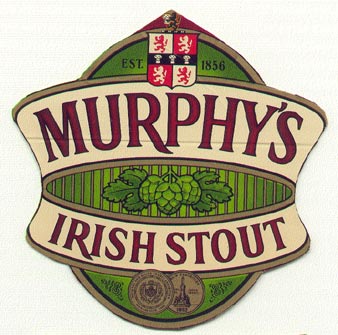
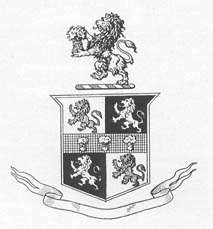
The black and white illustration comes from page 2 of the 1926 booklet Life of Paul Morphy in the Vieux Carré of New-Orleans and Abroad by Regina Morphy-Voitier, where the coat-of-arms was described as follows:
‘Morphy, alias Murphy. Quarterly argent and gules; four lions rampant interchanged, over all on a Fesse Sable three garbs or, Crest; a lion rampant holding a garb. (No Motto.)’
(3516)
Niall Woodger (Sandweiler, Luxembourg) writes:
‘Murphy and Morphy are derivations of the same name, both being Gaelic in origin, derived from “Murchadh”, meaning “sea warrior”. The Murphy brewery website states:
“The Murphy name is in fact the most popular name in Ireland and the Murphy family ... started the brewery back in 1856 as a noble family of the Cork region.”
The Brewery’s founder was James J. Murphy. An excellent website shows the Morphy coat-of-arms to be the same as the one you have displayed. There are six separate Murphy coats-of-arms given, of which four are almost identical to the Morphy one. Thus the Morphy and Murphy family histories are shown to be inextricably linked.’
(5068)
Jerry Spinrad (Nashville, TN, USA) sends a copy of an item entitled ‘A Great Game of Chess’ in Liberator, 27 June 1851. It consists of two quotes, and the first, from the Cincinnati Nonpareil, stated that Löwenthal was about to participate in the London, 1851 tournament. It concluded:
‘The man who comes off victorious in the game receives the purse and is crowned the King Player of the world. Mr Löwenthal has gone to try for the crown and – the purse.’
We are always glad to receive such early references, whether or not a specific term like ‘world championship’ is used.
The second quotation in the Liberator column comes from the New Orleans Bee and concerns the early meetings between Löwenthal and Morphy. It will be noted that asterisks were used to disguise the name of the American:
‘Mr Löwenthal is a very great chessplayer. He was in New Orleans about a year ago, and wrested the laurels from some of the finest masters of the game. But, strange to say, he was beaten by a youth of 12 years who, but a few months previous, had never played a game. The youth in question – Master M***** – is the son of a highly respectable citizen of New Orleans, himself an enthusiastic amateur of the noble game of chess. The boy was accustomed to look over the board while his father was playing. As soon as he comprehended the moves, he began to play. He first beat his father, then his uncle – a player of remarkable force – then, in a contest with Rosseau [sic – Rousseau], the chess champion of the South, he gained a signal advantage; and finally he amazed Löwenthal himself, by winning from him a majority in a given series of games. He has perhaps the most wonderful genius for chess ever witnessed. At his tender age he may be considered a first-rate player. His movements are prompt, astonishingly accurate, and the result of close and vigilant combination. He solves problems with amazing facility. None of the mysterious intricacies of these enigmas, however involved and numerous the moves, baffle his concentrated and patient attention. If he continues advancing in force as he grows older, he will become the wonder of the age ere he attains manhood.’
(3684)
Opposite the title page of The Human Side of Chess by F. Reinfeld (New York, 1952) was a list of four other books by him, including ‘Paul Morphy, King of Chess (in preparation)’. No such volume ever appeared, although in 1974 Collier Books, New York brought out Morphy Chess Masterpieces by F. Reinfeld and A. Soltis. (The back cover stated that Reinfeld had ‘died in 1973’, instead of 1964.) We know nothing of the genesis of the Reinfeld/Soltis book, i.e. to what extent it may have been based on Paul Morphy, King of Chess.
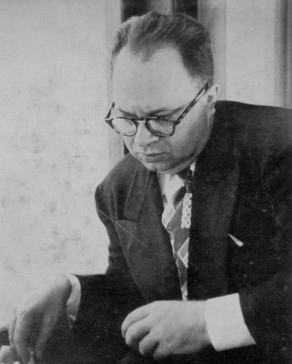
Fred Reinfeld
(3827)
Calle Erlandsson (Lund, Sweden) has sent us this postcard:
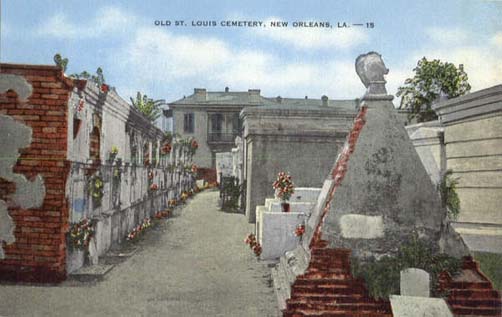
Caption on the reverse side: ‘The most interesting of New Orleans’ historic burial places, the St Louis Cemetery No. 1 – there are three – has been in use for 175 years, with some of the inscriptions still decipherable dated 1800. Here lie the bodies of Paul Morphy, the famous chessplayer; Gayarre, the historian; Etienne de Boré, who first made granulated sugar; Charles LaSalle, brother of the famous explorer.’
The card belongs to the same series (‘New Orleans – America’s Most Interesting City’) as the two we presented in C.N. 3014:

‘Famed patio and garden located at 417 Royal Street to which thousands of tourists are attracted annually. The building which once housed the Louisiana Bank established in 1804, and which later became the home of Paul Morphy, world-famous chess champion, is now used as a restaurant.’

‘This building located at 417 Royal Street, first housed the Louisiana Bank, established in 1804 through the influence of Thomas Jefferson, later it became the home of Paul Morphy, world-famous chess champion. It is now a fashionable restaurant. Your host, Col. Ad Given Davis.’
Below is a photograph of the house which was published on page 34 of the 1926 booklet Life of Paul Morphy in the Vieux Carré of New-Orleans and Abroad by Regina Morphy-Voitier:
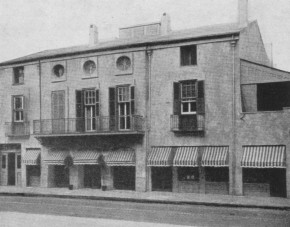
We have received from Gordon W. Gribble (Hanover, NH, USA) a number of photographs taken by him in New Orleans in August 2002 (the Royal Street premises having become Brennan’s restaurant):
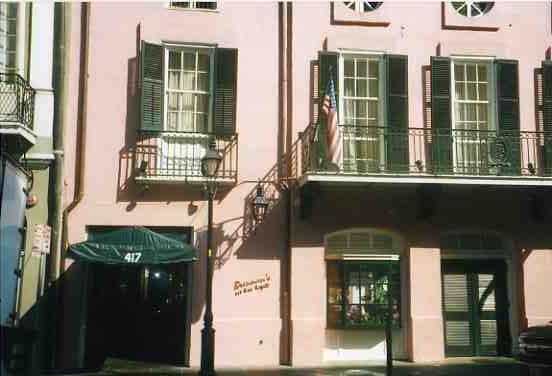

Dr Gribble has also kindly sent us shots of the Morphy tomb in New Orleans:
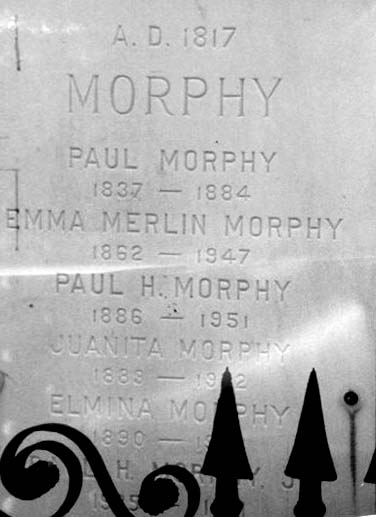
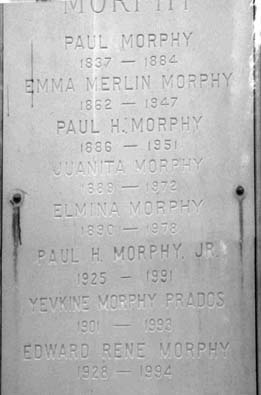
(3849)
In C.N. 3849 Gordon W. Gribble offered two photographs of the house in New Orleans where Morphy died. He also photographed the residence, a few blocks to the east, where Morphy was born:
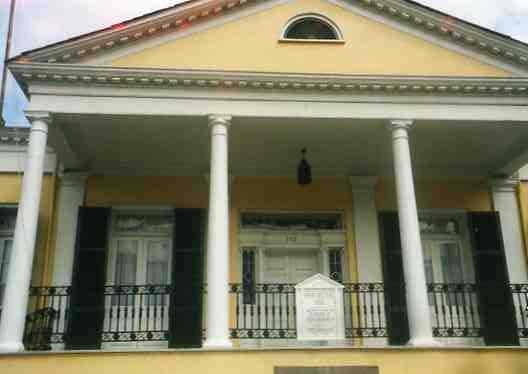
This is the Beauregard-Keyes House, 1113 Chartres Street. The second photograph appeared on page 10 of Regina Morphy-Voitier’s 1926 booklet Life of Paul Morphy in the Vieux Carré of New-Orleans and Abroad:
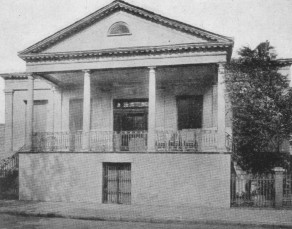
(3865)
C.N. 3590 gave Samuel Loyd’s ‘photographic chessboard’ (dated 1868). It included a small photograph of Morphy which we do not recall seeing elsewhere, and below is our best effort to present it in enlarged form:
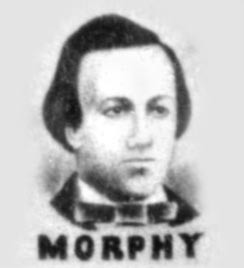
It would seem a relatively late picture and, for purposes of comparison, below are two photographs from page 332 of David Lawson’s book Paul Morphy The Pride and Sorrow of Chess:
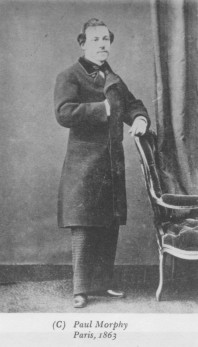
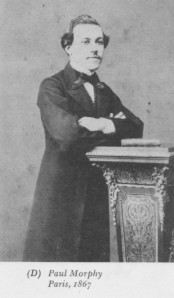
It may be wondered whether both dates (1863 and 1867) in Lawson’s captions are correct, since the photographs appear to have been taken around the same time.
On page 53 of Chessworld January-February 1964 Lawson published what he described as ‘the last photo of Morphy ever taken’, a shot which, on page 333 of his book, was labelled ‘New Orleans, 1870’:
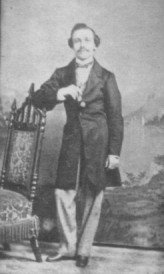
(3890)
C.N. 3890 gave a seldom-seen picture of Paul Morphy. Here is another one, from page 182 of “Our Folder” (the Good Companion Chess Problem Club), 1 May 1921:
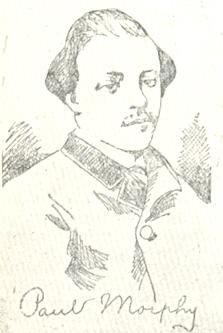
(4137)
It is not easy to reconcile the captions to the following two illustrations, which appeared respectively on page 159 of David Lawson’s biography of Morphy and on page 173 of “Our Folder” (the Good Companion Chess Problem Club), 1 May 1921:
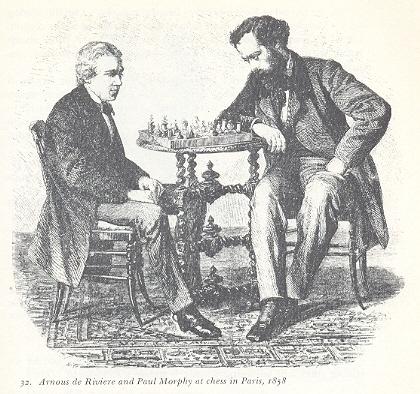
‘Arnous de Rivière and Paul Morphy at chess in Paris, 1858’
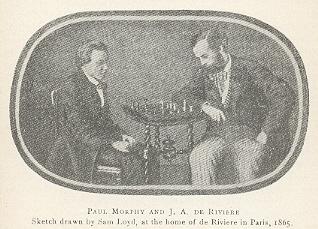
‘Paul Morphy and J.A. de Rivière.
Sketch drawn by Sam Loyd, at the home of de Rivière in Paris,
1865’
One extra complication is the question of whether ‘1865’ was a misprint for 1863.
(4165)
Luc Winants (Boirs, Belgium) has recently acquired this publication of the Morphy v de Rivière picture (‘d’après une photographie de M. Thompson’), on page 208 of L’Illustration, journal universel:
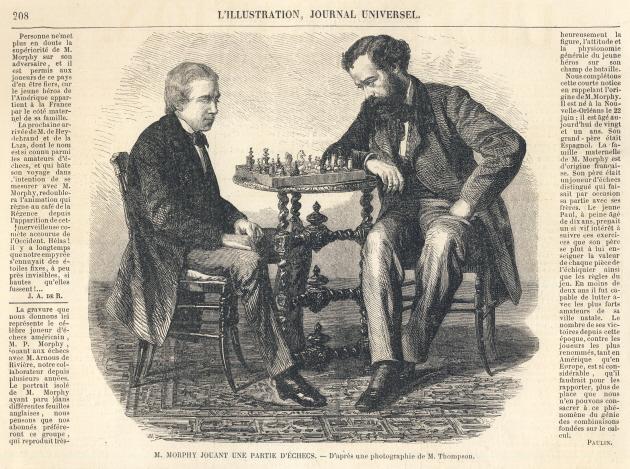
The exact date of the publication appears to be 25 September 1858.
(7604)
Further to a discussion of the publication in C.N. 5149, we add that Worlds of Chess Champions has a good portrait of Paul Morphy, although presented in reverse. It is reproduced correctly here:
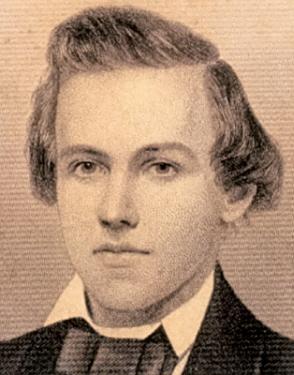
(5150)
As shown by numerous pictures, Morphy parted his hair on the left. Another mistake occurred on page 53 of Chessworld, January-February 1964, in a lengthy, richly illustrated article on Morphy by David Lawson:


Left: published mirror image – Right: corrected
New in Chess has announced the forthcoming publication of The Real Paul Morphy by Charles Hertan:

(12018)
Addition on 28 August 2024:
C.N. 12018 was posted on 25 August 2024. As shown on the above-mentioned New in Chess webpage, the front cover has now been changed:
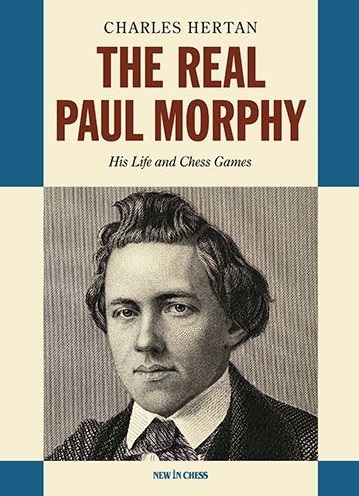
Gene Gnandt (Houston, TX, USA) asks when the well-known Anderssen-Morphy engraving was first published. He also comments that when it was the frontispiece to Die Schachpartie by F. Gutmayer (Berlin and Leipzig, 1920) one of the four individuals mentioned in the caption was, surprisingly, Saint-Amant.
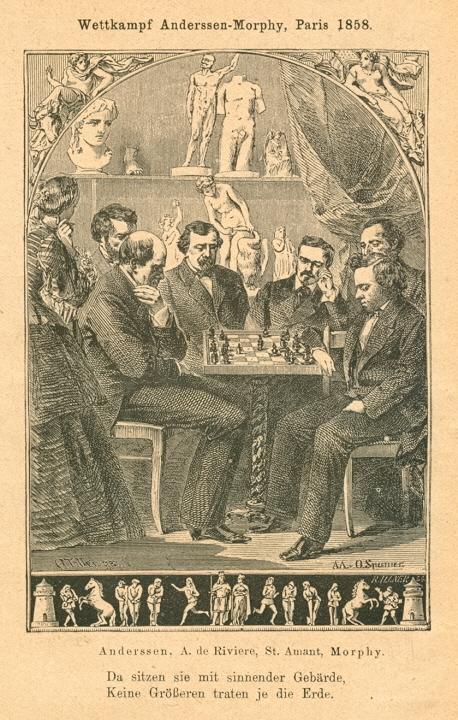
We note that the illustration appeared in Paul Morphy Skizze aus der Schachwelt (Leipzig, 1859). See too page 176 of Paul Morphy The Pride and Sorrow of Chess by D. Lawson; or page 175 of the inexpensive paperback version edited by Thomas Aiello which has been published recently by University of Louisiana at Lafayette Press.
(6811)
Ross Jackson (Raumati South, New Zealand) points out that pages 621-624 of Harper’s New Monthly Magazine, March 1888 had an article ‘Chess in America’ by Henry Sedley, with this picture of Morphy on page 621:
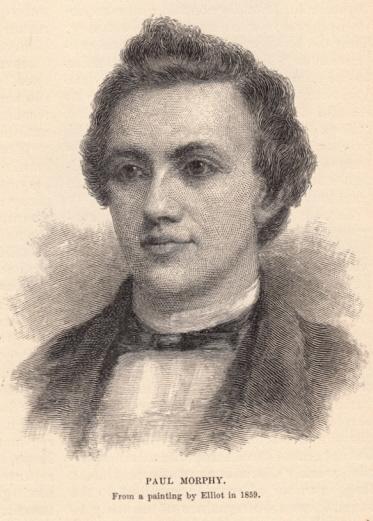
For the original oil painting, see page 233 of Paul Morphy The Pride and Sorrow of Chess by David Lawson.
(7415)
See also Chess Statues and Sculpture.
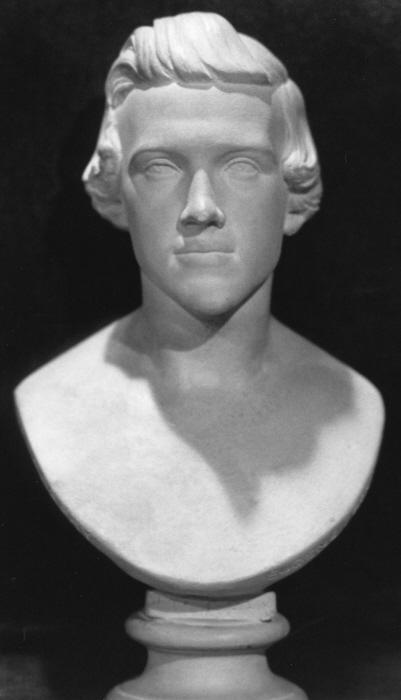
The following is the start of a letter from Morphy to D.W. Fiske dated 25 January 1858 which was reproduced on pages 26-28 of “Our Folder” (the Good Companion Chess Problem Club), 1 November 1920:
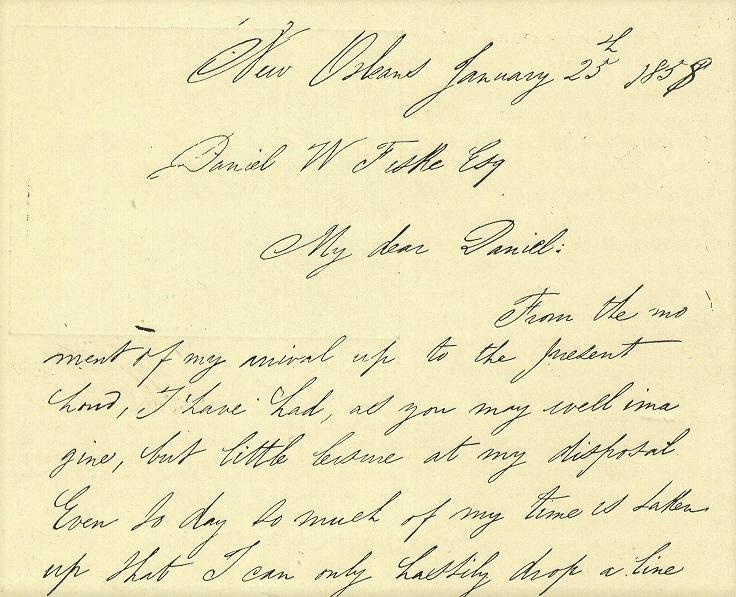
For a transcript of the full letter, see page 89 of David Lawson’s book on Morphy.
(4025)
Two letters from pages 166-167 of Paul Morphy The Pride and Sorrow of Chess by David Lawson:
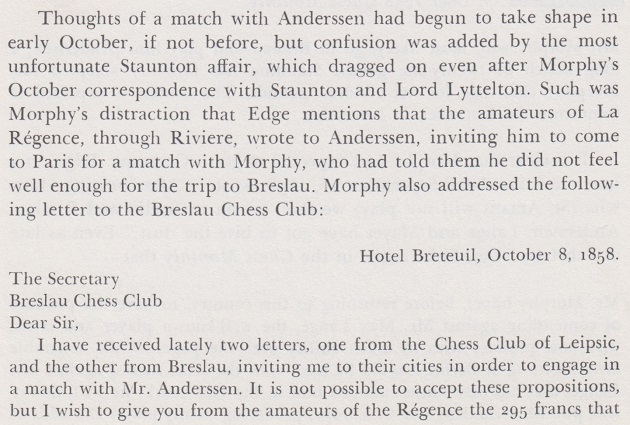
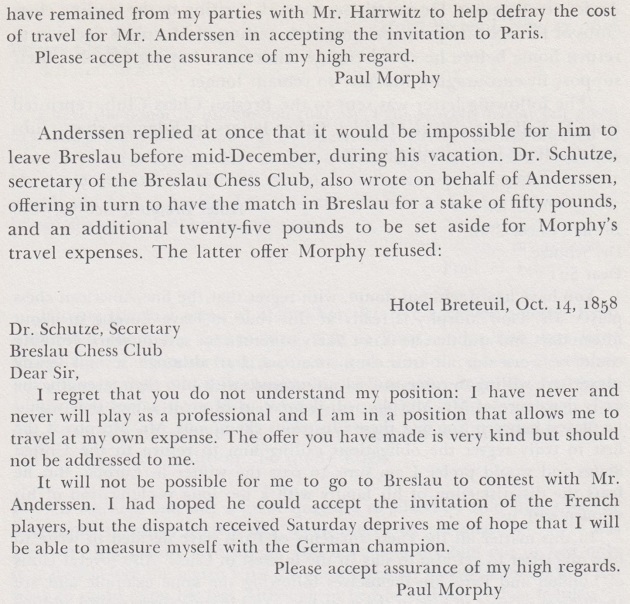
Concerning the first letter, we add the frontispiece to the 15 August 1884 issue of La Stratégie:

The English and French do not fully correspond. For instance, the passage beginning ‘... mais j’en ai une à vous faire, qui ...’ is absent from the English version.
Frank Skoff’s ‘list of letters (plus some other items)’ in Lawson’s biography of Morphy was shown in C.N. 10294 (see below).
(11325)
Page 388 of A Chess Omnibus gave a Morphy acrostic by C.V. Grinfield from page 334 of the Chess Player’s Chronicle, 1861:
Mightiest of masters of the chequer’d board,
Of early genius high its boasted lord!
Rising in youth’s bright morn to loftiest fame,
Princeliest of players held with one acclaim;
Host in thyself – all-conquering in fight: –
Yankees exult! – in your great champion’s might.
As mentioned in Chess and Poetry, Poems and Chess Problems by J.A. Miles (Fakenham, 1882) had acrostical compositions based on ‘Miron and Phania’ (page 53), ‘Anderssen’ (page 57) and ‘Wilhelm Steinitz’ (page 110). The last of these was published too on page 285 of the September 1882 BCM. Pages 347 and 348 of the magazine’s October 1882 issue had poems on ‘Paul Morphy’ and ‘Howard Staunton’, by Frideswide F. Beechey and Robert Bennett respectively.
Page 141 of Chess Fruits (Dublin, 1884) had the following acrostic composition by Mrs T.B. Rowland:
Paled e’er that light once bright,
A pleiad passed away
Unrivalled star, afar,
Lost to our sight for aye.Midst wondering gaze, thy blaze
Of glory charmed our eyes,
Rest, Morphy rest – now blest,
Peace o’er thy spirit lies.
Hushed every grief – each care has fled,
Yet still for thee fond tears are shed.
(4066)
A different version was published in the New Orleans Times-Democrat, 27 July 1884, page 10:
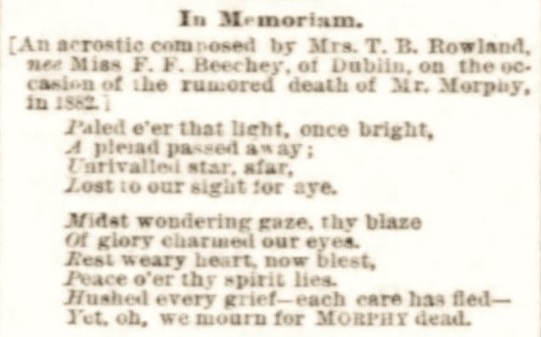
Here we mention the work of James Russell Lowell. Page 220 of David Lawson’s Paul Morphy The Pride and Sorrow of Chess noted that he ‘composed a poem of some one hundred lines’ for a ceremony in honour of Morphy in 1859. On page 93 of Grandmasters of Chess (Philadelphia and New York, 1973) Harold Schonberg quoted eight lines from what ‘could easily lay claim to being the worst poem in the English language’.
Rival claims are welcome.
(4961)
From page ix of The Games of the St Petersburg Tournament 1895-96 by J. Mason and W.H.K. Pollock (Leeds, 1896):
‘Steinitz himself, in the Figaro, so far back as 1878 – when he was contemplating retiring from chess – claims that his record was then better than Morphy’s, but left the question of genius an open one.’
This quote is of interest on two fronts. What more is known about Steinitz’s contemplation of retirement in 1878, and what exactly did he write that year about Morphy?
(4160)
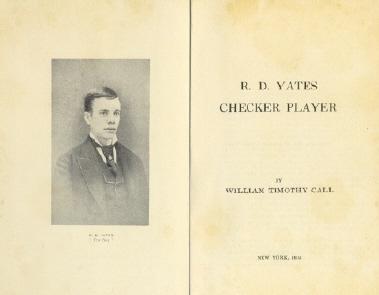
From page 14 of R.D. Yates Checker Player by W.T. Call (New York, 1905):
‘Paul Morphy, the chess genius, sought to obtain a glimpse into the scientific depths of checkers without too much trouble, but never succeeded in getting within sight of anything under the surface of the game. When he went to England he asked Thomas Lear, who played both checkers and chess, to explain to him “wherein the beauty of draughts playing lay”. On another occasion, half in jest, half in earnest, the great chess master said to a New York player, “Checkers is for tramps”.
W.J.A. Fuller, chess editor of Leslie’s Illustrated Newspaper, declared that checkers is “all bosh”, although he was what the checker editor of the New York Clipper called “a bold, dashing and original draughts player”. Hodges, the Buffalo expert, was beating Fuller at checkers repeatedly, to the great satisfaction of the bystanders, when the author of the “all bosh” remark claimed he had an easy draw, and his offer to make a bet and give odds on it was quickly taken. Fuller won the bet by gently drawing his knees apart and allowing the board and men to fall to the floor. This, by the way, is the origin of “Fuller’s draw”, a phrase sometimes used to describe the only thing an inferior player might expect to get from an adept.’
Wanted: substantiation of the foregoing, and particularly the material about Morphy.
(4425)
In 1959 whom did Harry Golombek call ‘perhaps the greatest chessplayer that ever lived’?
(4611)
It was Paul Morphy whom Golombek described as ‘perhaps the greatest chessplayer that ever lived’.
Source: page 51 of his book Modern Opening Chess Strategy (London, 1959).
(4620)
Under the heading ‘Amazing facts’ the following appeared on page 17 of Playing Chess Step-by-Step by Gary Lane (New York, 2004):
‘The slowest chessplayer ever was Louis Paulsen, who once thought for 11 hours over one move.’
This ‘fact’ of the ‘once’ variety would appear to be based on a misunderstanding. The figure of 11 hours was given, regarding the New York, 1857 tournament, on page 67 of Paul Morphy The Pride and Sorrow of Chess by David Lawson (New York, 1976) but in a different context:
‘Undoubtedly, slow playing on the part of Paulsen was the reason for time records being kept during his games with Morphy. Moves over five minutes during the second game and portions of others were recorded. During the entire second game, Morphy’s total time for moves over five minutes was only 25 minutes, while Paulsen consumed 11 hours for the same.’
The breakdown for that second Paulsen v Morphy game was given on page 246 of the tournament book:
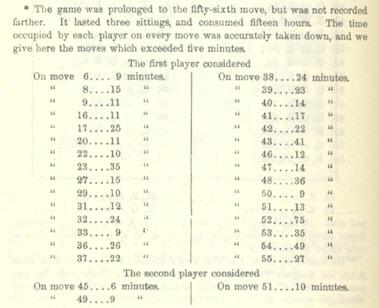
As shown below, page 248 of the tournament book indicated that the total duration of the third game between Paulsen and Morphy was 11 hours, most of it consumed by the former:
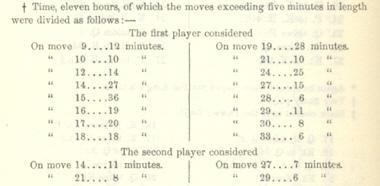
There is also the well-known anecdote about Paulsen, in play against Morphy, sitting motionless at the board and suddenly asking whether it was his move. Steinitz related it on page 46 of the February 1885 International Chess Magazine, on the authority of Thomas Frère.
(4680)
Joost van Winsen (Silvolde, the Netherlands) quotes a passage from pages 120-121 of The Principles of Chess in Theory and Practice by James Mason (London, 1894):
‘Formerly there was no time-limit. In those days, not so very long ago, a player finding himself in difficulties, real or imaginary, might rest and be thankful. Had he a bad or doubtful game? Well, if it could not be mended it need not be ended. A failing position afforded excellent food for thought. Not necessarily profound thought, but prolonged, and excellently calculated to discomfort, if not discomfit, the adversary. A comparatively short game (as to moves) in the American Chess Congress, New York, 1857, occupied 15 hours. This was between Morphy and Paulsen, the first and second prize-winners in that historic event. Paulsen was a slow player. Revelling in speculations – probable, possible, and perhaps impossible – he was wont to do his best, regardless of time, but not with the slightest or any idea of wearying his adversary by undue deliberation. Nevertheless, Morphy must have been sorely put to it when tears of impatience stood in his eyes – his opponent moved so very slowly.’
(4691)
C.N. 2806 (see page 69 of Chess Facts and Fables) referred to Paul Morphy’s agreement in 1859 to write a chess column for one year in the New York Ledger for $3,000, and we charily suggested a modern-day equivalent of $63,500.
Morphy’s column was discussed by W.J.A. Fuller in a letter to Thomas Frère published in the programme for the 1886 world championship match between Steinitz and Zukertort and reproduced on pages 282-285 of the July 1886 BCM. Below is the complete text of Fuller’s remarks on the subject:
‘Robert Bonner, at that time, was in the first flush of success with his N.Y. Ledger. He paid the highest prices for the best work – ten thousand dollars to Edward Everett for one column a week for a year – some fabulous sum to Charles Dickens for an original story, etc., etc. With his keenness, wide awake to everything that was on the topmost wave of popular favour and universally known, and with his intention to have the best that money could secure for his paper in every department, he thought he saw an advantage, at least in the way of advertising, in having a chess column for the Ledger, edited by Morphy.
Accordingly he engaged Morphy to edit his chess column for a year. The negotiation was made through me. Mr Bonner paid him in advance, with his usual unparalleled liberality, and for one year the Ledger had a chess column. Morphy was incorrigibly lazy, and Mr Bonner would not continue his services at any price for another year. Moreover, his readers were not particularly interested in chess. They cared more for Sylvanus Cobb’s stories, like “The Gun-Maker of Moscow”, than they would for Shakespeare’s Hamlet. There were some things connected with this chess column that were curious, and would greatly interest chessplayers, but it would be contrary to the lex plumae to reveal them without Mr Bonner’s consent. It is more than a quarter of a century since I used to see Mr Bonner on the top floor of the building corner of Ann and Nassau Streets, where I wrote for the Mirror, and he published the Merchants’ Ledger. The absorbing labours of a busy profession have kept us apart. People run in grooves in large cities, and our paths have been as divergent as the poles. Friends are like garden plants and should be cultivated, but I hope Mr Bonner feels as kindly to me as I do to him. His liberality to me was astounding. I shall never forget it. At that time a check for a thousand dollars looked to me as big as a cathedral.’
Some extracts from Fuller’s letter were quoted on pages 95-96 of Morphy Gleanings by P.W. Sergeant (London, 1932) and the ‘incorrigibly lazy’ quote was given by David Lawson on page 231 of Paul Morphy The Pride and Sorrow of Chess.
Morphy New York Ledger Chess Columns 1859-1860 (Yorklyn, 1987) provided a complete set of photographic reproductions of the columns.
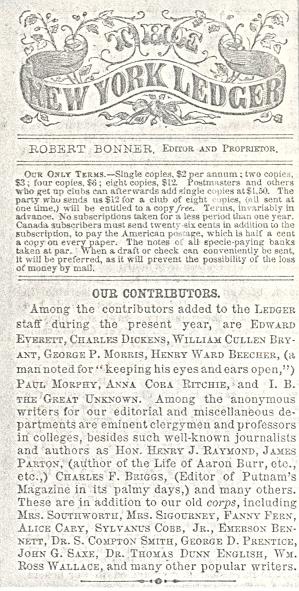
Issue of 16 July 1859
Finally, as regards Charles Dickens’ contribution to the New York Ledger, pages 895 and 912-913 of Dickens by Peter Ackroyd (London, 1991) state that in 1859 he received from Robert Bonner £1,000 for a short story, Hunted Down. At the time that was approximately $5,000.
(4846)
A feature on page 104 of Fred Reinfeld’s The Treasury of Chess Lore (New York, 1951) entitled ‘Morphy’s Estimate of Staunton’ was taken from page 410 of the September 1891 BCM, but the latter offered no source. For that, and a more extensive version, we turn to page 155 of Paul Morphy The Pride and Sorrow of Chess by David Lawson:
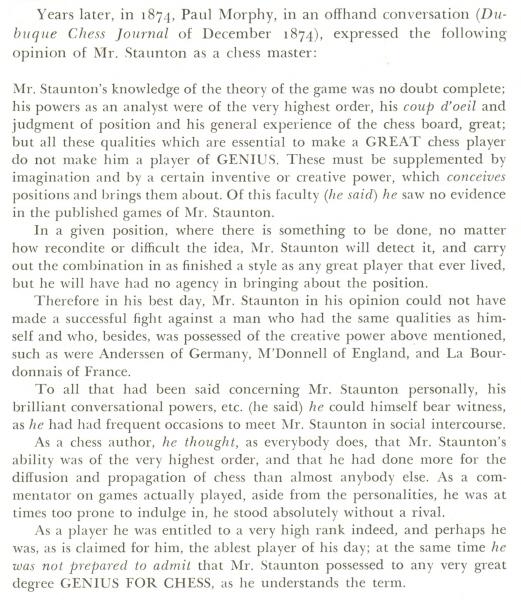
(5008)
Below, courtesy of the Cleveland Public Library, is the item published in the Dubuque Chess Journal:

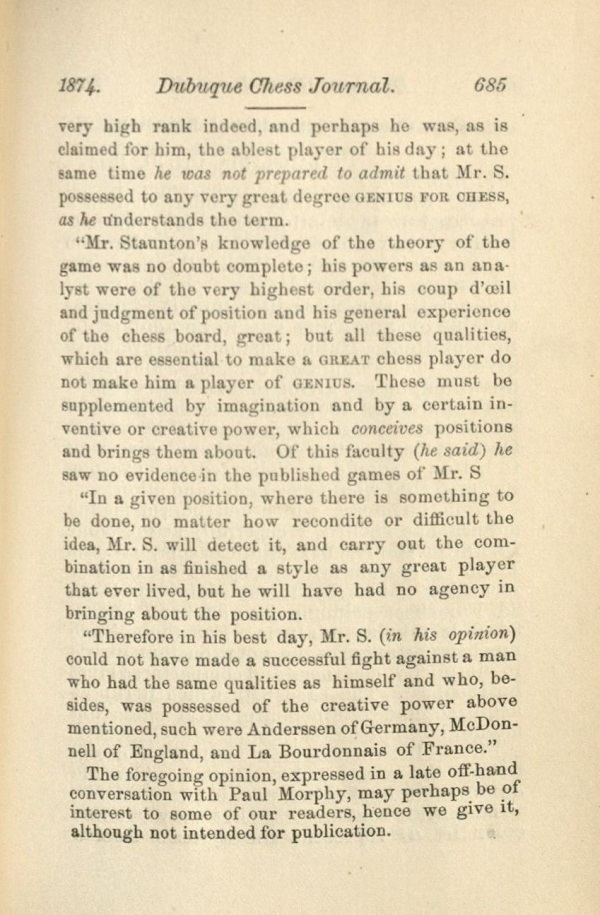
In a letter dated 11 June 1979 David Lawson sent us ‘a short list of errata for [Paul Morphy The Pride and Sorrow of Chess], as I understand that many copies of the book went out without it’:
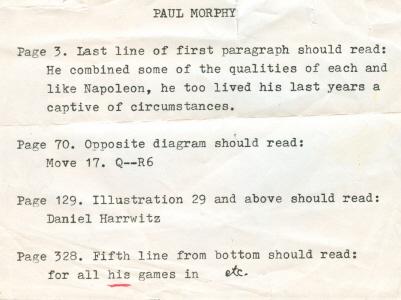
(5672)
In the late 1980s Frank Skoff sent us a ‘list of letters (plus some other items)’ in David Lawson’s book on Morphy:
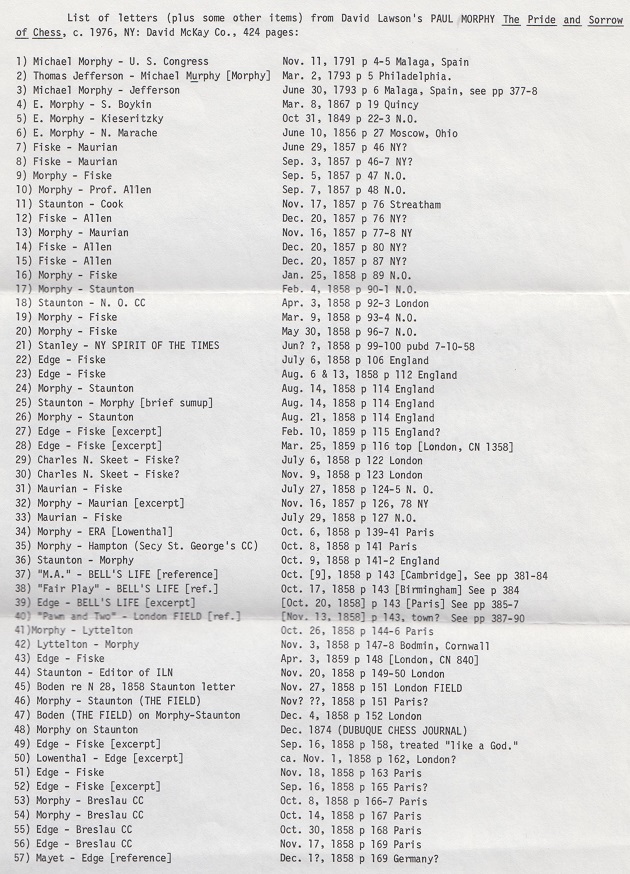
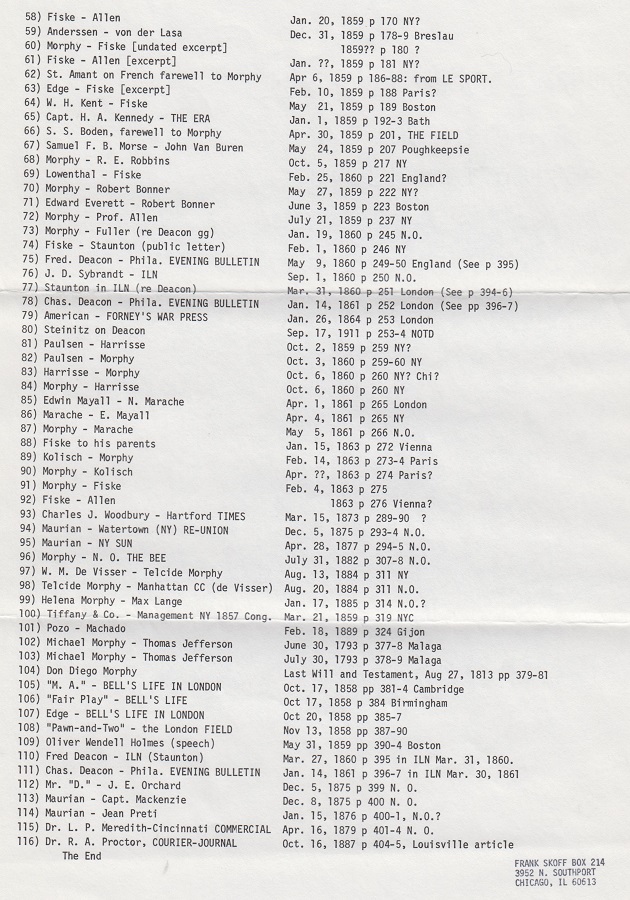
(10294)
We are grateful to Gilles David (Eaubonne, France) for a copy of his translation into French of David Lawson’s monograph on Morphy, under the title Paul Morphy: La Gloire et la Tristesse des Echecs.
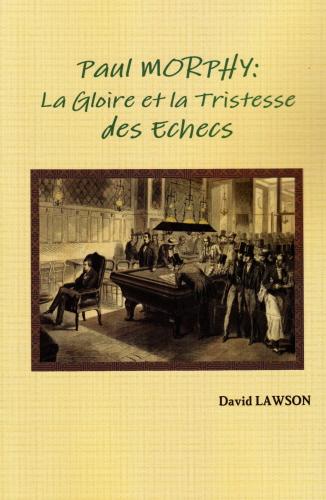
One hundred numbered copies have just been produced, and details are available at a website which Mr David is currently developing.
(8032)
Jerry Spinrad points out a brief item on page 1 of the Weekly Georgian Telegraph of 28 June 1859:
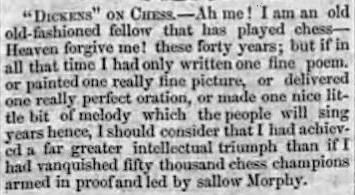
Pending further information, this paragraph, referring to Dickens, chess and Morphy, needs to be treated cautiously, and not least because our correspondent has found that the same text had appeared on page 3 of the Washington Constitution of 14 June 1859, but with the quote attributed to ‘Diogenes’.
(6957)
Which is the rarest monograph on Paul Morphy? Our suggestion is La odisea de Pablo Morphy en La Habana by Andrés Clemente Vázquez (Havana, 1893).
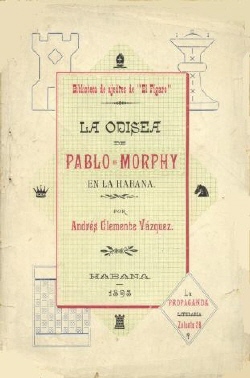
A booklet of under 60 pages, it mainly comprises quotes from the local press, and the few games given all found their way into later volumes on Morphy. The one illustration, on page 27, has the caption ‘“Soirée” de jugadores de ajedrez, en casa del Sr. D. Francisco Fésser (Habana), el 17 de Octubre de 1862’, with players identified as ‘A. Medina, Mr Paul Morphy, F. Fésser, F. Sicre, B. Dubouchet, G. Toscano’.
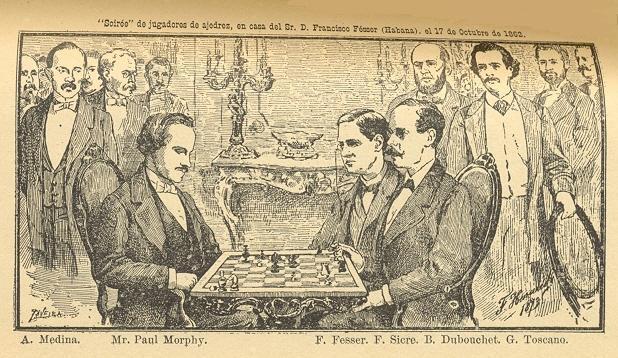
See also page 271 of David Lawson’s Paul Morphy The Pride and Sorrow of Chess. We should like to find out more about Félix Sicre, who had been regarded as the Cuban chess champion.
(4932)
Olimpiu G. Urcan (Singapore) draws attention to a similar sketch on page 29 of El Moro Muza, 26 October 1862 (with a report on pages 30-31), available in the on-line archives of the Biblioteca Nacional de España.
Our correspondent comments that his searches for material (texts and photographs) on such masters as Capablanca and Alekhine (also with the spelling ‘Alekine’) have been particularly fruitful.
(6830)
In C.N. 1065 Ed Tassinari (Scarsdale, NY, USA) noted that in the Odisea book Vázquez stated that he intended to produce a further work with additional Morphy material and information, games, newspaper accounts, etc. of the Cuban visits of Steinitz, Chigorin, Mackenzie, Gunsberg, Lasker and Walbrodt. Our correspondent’s question as to whether such a book ever appeared was answered in C.N. 1170 by Rob Verhoeven (The Hague, the Netherlands), who sent us a copy of pages 52-54 of Biblioteca ‘Andrés C. Vázquez’ (Índice), published in Havana in 1899. The pages comprise a comprehensive list of Vázquez’s books and articles. There is no mention of a further work on Morphy after the 1893 one.
We present a list of Morphy books (excluding reprints) in our
collection which have been published since David Lawson’s
biography in 1976.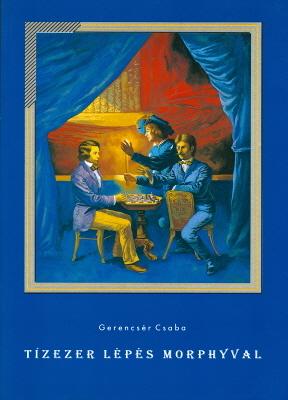
(4933)
Published in 1988 by colección Ricardo Aguilera (Madrid), Morphy su vida y 353 partidas by Benito López Esnaola claimed to be an important work of scholarship. As noted in C.N. 1821, the author commented in his introduction: ‘Morphy’s games have been compiled before, but I believe that the present book breaks the record with 353. The previous total was 300.’ The back-cover blurb remarked that 353 was a ‘record figure’ and trumpeted López Esnaola as ‘an excellent investigator of chess history’.
Our earlier item mentioned that such words were considerable exaggerations. Maróczy’s book on Morphy (first published in 1909) contained over 400 games, even though López Esnaola mentioned this predecessor on page 26. On the other hand, he overlooked the second series of unknown Morphy games published by David Lawson in the BCM (September 1979), and showed no evidence of acquaintance with Paul Morphy The Pride and Sorrow of Chess. There were so many misspellings they could hardly be printers’ errors. Pages 18, 26 and 35 referred to the ‘Britisch Chess Magazine’, no doubt by analogy with the ‘Britisch Chess Review’ (page 172). Staunton’ column was in the ‘Ilustration London’ (page 14), the ‘Ilustrated London News’ (pages 15, 16 and 172) and the ‘Ilustrated London’ (pages 17 and 18). Other nineteenth-century revelations were ‘McConnel’, ‘Rouseau’, ‘La Bourdonais’, ‘Lichtenthein’, ‘Lichtentheim’, ‘Lichtenheim’, ‘Lyttleton’, ‘Lytleton’, ‘Harwitz’, ‘St Jame’s Chess Club’, ‘Ilustrated Sportin and Dramatic News’, ‘MacDonnel’ , ‘Zukertot’ , ‘Andersen’, ‘Cuningham’, ‘Sucre’, ‘La Palamede’ and ‘Delandy’.
In addition, López Esnaola’s book concluded with six pages of biographical notes on Morphy’s opponents. They were simply purloined from the footnotes in Morphy’s Games of Chess by P.W. Sergeant.
(5195)
A very early appearance of the name ‘Morphy’ in a chess magazine came on page 248 of Le Palamède, 15 May 1842. It was, however, a reference to Ernest Morphy (Paul’s uncle). A feature on chess in the United States mentioned the devastation caused by yellow fever in New Orleans, and stated that Ernest Morphy (‘notre correspondant’) was active in chess there and had sent highly interesting material to Labourdonnais.
(5177)
Jon Crumiller (Princeton, NJ, USA) sends a cutting from page 4 of the Wisconsin publication the Whitewater Register of 31 July 1858. Readers are naturally advised to treat it with great prudence.
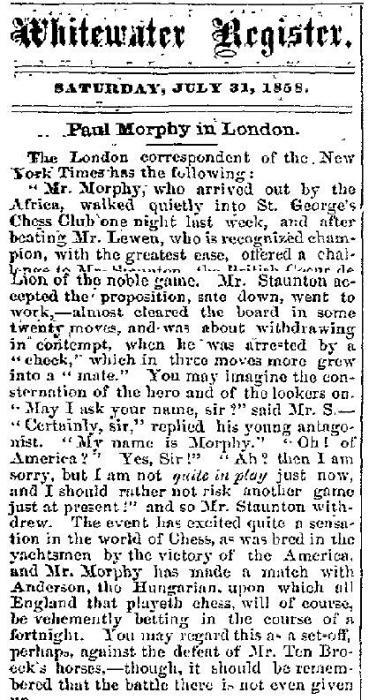
(5283)
Michael Clapham (Ipswich, England) sends an extract from the chess column by J.H. Sweet in the American Chronicle, 12 March 1868:
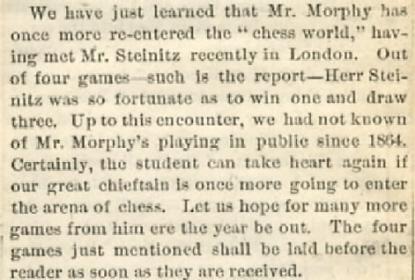
Our correspondent adds:
‘I have every column from its inception on 7 November 1867 up to the last, dated 30 July 1868, but I can find no further mention of these games, or a retraction.’
David Lawson discussed the matter on pages 288-289 of his 1976 biography of Morphy. After quoting Wilkes’ Spirit of the Times from early 1868 (‘Rumor says that he [Morphy] has played four games with Mr Steinitz, losing one and drawing three’), Lawson wrote:
‘Unfortunately for the chess world, they had not met, nor did they until 1883 during Steinitz’s visit to New Orleans. About this time, 1863 [sic], Steinitz had had several games with a Mr Murphy of London, and evidently someone, finding Steinitz’s opponent rather vaguely described, thought it was Morphy. This mistake was made even though Steinitz was conceding odds of pawn and move to his opponent, which should have canceled the possibility that the opponent was Morphy. Some of these games were published in 1863 in the Chess Player’s Magazine.’
(5844)
‘Lasker and Schlechter signed a secret protocol’ is the heading on page 46 of The Genius and the Misery of Chess by Zhivko Kaikamjozov (Newton Highlands, 2008), and the following page affirms:
‘The match rules [i.e. for the 1910 encounter] weren’t published anywhere and the above-mentioned clauses were secret, known only by the players and two confidants. The protocol from the match was revealed much later, after the death of the last of the four men who knew the secret.’
Naturally the ‘two confidants’ are left unidentified, as is the person who revealed the ‘protocol’, as well as everything else that the reader would expect to be told.
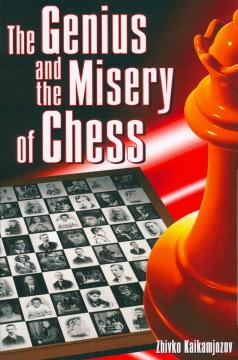
Another heading, on page 26, reads: ‘Mister Morphy, you have won the match, because you are stronger than me.’ These words, according to Mr Kaikamjozov, ‘Staunton pronounced in broken French’. Overleaf it is averred that, later on, Morphy ‘became paranoid, despised everyone’ and that ‘a loaded gun was kept on his bedside table at all times’.
That Morphy chapter (pages 23-29) shows the author at his most fabulistic, and we have seldom seen anything quite so bad.
(5855)
From Raymond Kuzanek (Hickory Hills, IL, USA):
‘On page 29 of his book The Genius and the Misery of Chess (Newton Highlands, 2008) Zhivko Kaikamjozov states:
“In 1867, Morphy embarked for Paris for treatment. The most prominent French psychiatric specialists tried hard to help him, but without any success. The only lasting effect was the emptying of his pockets, which soon led to his return to America.”
Unfortunately, Mr Kaikamjozov does not specify his sources of information. Do you recall any prior mention, with substantiation, of Morphy receiving psychiatric care in Paris?’
We do not. C.N. 5855 briefly discussed/dismissed The Genius and the Misery of Chess and singled out the Morphy chapter for particular criticism.
(8468)
From page 320 of Paul Morphy The Pride and Sorrow of Chess by D. Lawson:
‘Paul Morphy was memorialized at Spring Hill College on 27 April 1957, when a plaque and monument presented by E. Forry Laucks were unveiled by the Mayor of Mobile, Henry R. Luscher, with an honor guard from the Spring Hill ROTC.’
A photograph of the ceremony was given on the following page, and we add below a detail of the plaque, from page 164 of the June 1957 Chess Review:
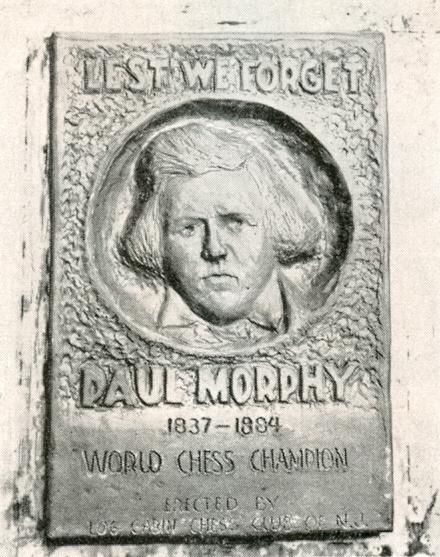
(5910)
Page 79 of David Lawson’s 1976 monograph on Morphy had an illustration captioned ‘Morphy’s American opponents’. They were not identified, and we therefore give the version published on page 54 of the May-June 1950 American Chess Bulletin:
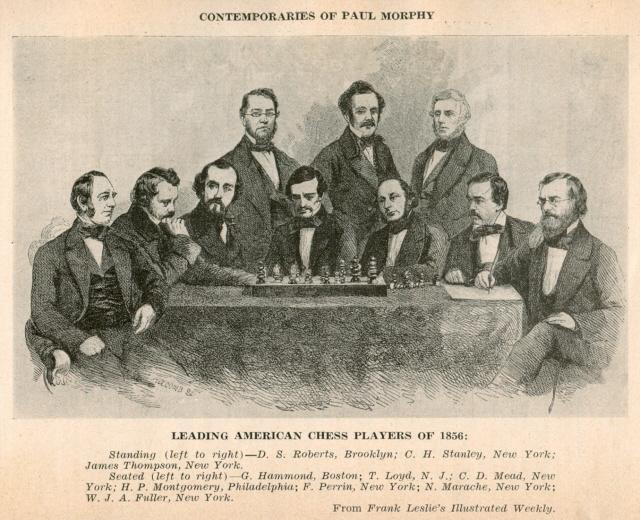
(5959)
Michael Clapham reports that on 19 February 2009 Swann Galleries of New York sold this item by auction for $2,880:
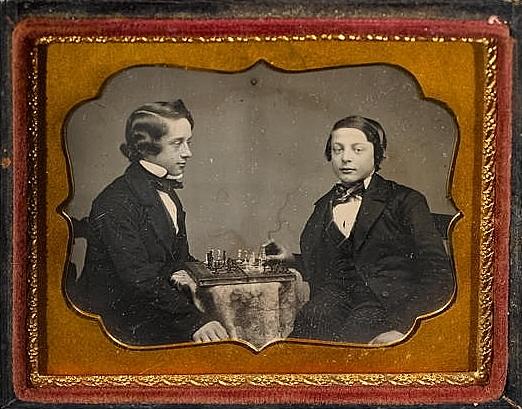
The catalogue described it as follows:
‘Portrait of early American chess master Paul Morphy and a companion, with a chess game in progress between them. Sixth-plate daguerreotype with delicate gilt highlights; in a leather case. 1850s.’
(6018)
The picture purportedly depicting Morphy, with an unidentified opponent, was the subject of an article by Enoch Nappen on page 25 of the June 1986 Chess Life.
(7390)
This picture was also discussed on page 37 of the October 1993 Chess Life by Frank Skoff, who concluded that it did not feature Paul Morphy.
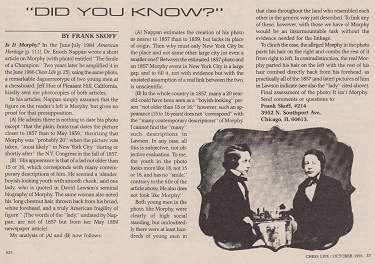
(11404)
John Blackstone (Las Vegas, NV, USA) asks for a reliable contemporary version of the moves of a game between Schulten and Morphy, New York, 1857. We reproduce below (without the notes) the score as it appeared on page 21 of the Chess Monthly, January 1858:
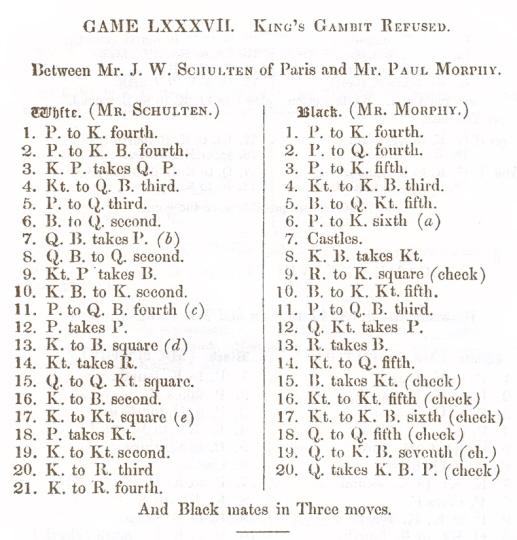
Schulten’s encounters with Morphy in late 1857 (he scored +1 –23 =0) were referred to on pages 30-31 of the same issue of the Chess Monthly. Contrary to occasional claims made even today, there was no suggestion in the magazine that Morphy played any of the games blindfold.
(6079)
From page 195 of Chess from Morphy to Botwinnik by Imre König (London, 1951):
‘This game has become a classic. It is one of the few early examples in which no improvement, either of opening theory or execution of attack, has been advanced.’
(7808)
Further to Imre König’s remark about Morphy in C.N. 7808, we add a comment by B.H. Wood from the Daily Telegraph chess column of 8 March 1986 which was quoted in C.N. 1130 under the heading ‘Open to doubt’:
‘... you could go through any game by the legendary Paul Morphy and find most of his moves from move six on were not quite the best he could have made.’
(7816)
Mark N. Taylor (Mt Berry, GA, USA) draws attention to John and the Chess Men by Helen Weissenstein (New York, 1952 and London, 1955), a children’s story which frames a beginner’s chess primer.
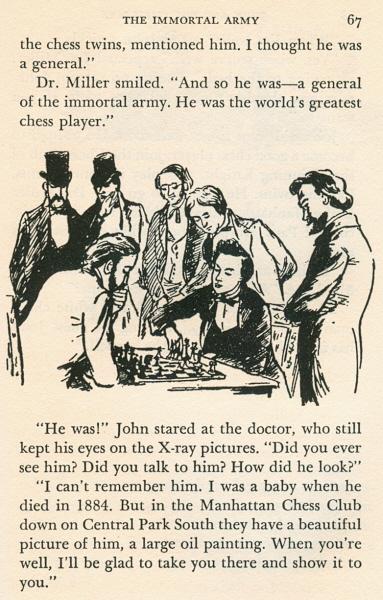
We have a great liking for the book. With considerable skill the author not only teaches the chess basics but gives guidance on etiquette and incorporates some chess history and lore (Franklin, von Kempelen and Morphy).
(6362)

In C.N. 2366 (see page 311 of A Chess Omnibus) Daniël De Mol (Wetteren, Belgium) reported that in 1998 Guinea issued a postage stamp which misidentified Spassky as Morphy. We are grateful to our correspondent for enabling us to reproduce the faulty stamp here, together with the rest of the set.
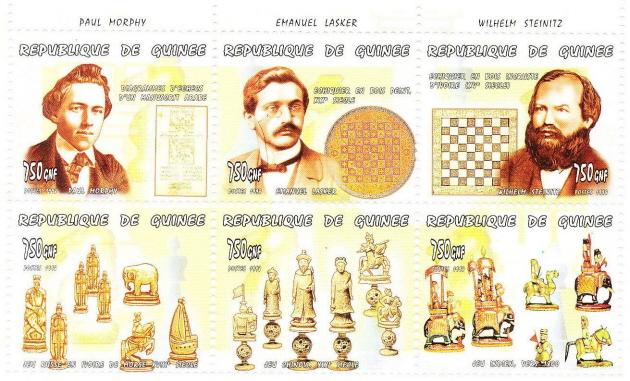
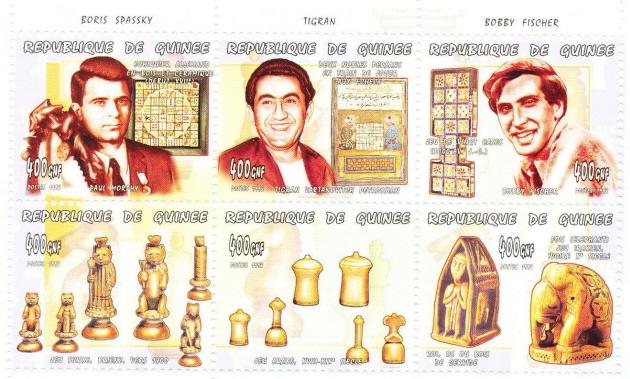
(6243)
A remark often ascribed to Paul Morphy is ‘Help your pieces so that they can help you’, but so far we have been unable to trace it back further than page 64 of Bréviaire des échecs by S. Tartakower (Paris, 1934):
‘“Aidez vos pièces pour qu’elles vous aident”, telle était la devise du génie d’échecs, Paul Morphy.’
The English version is on page 49 of A Breviary of Chess (London, 1937):
‘“Help your pieces so that they can help you” was the motto of that genius of chess, Paul Morphy.’
(6528)
Hassan Roger Sadeghi comments to us that this reference by Tartakower to Morphy’s ‘motto’ does not necessarily mean that the American himself made the explicit statement. Was it merely Tartakower’s way of summarizing Morphy’s style of play?
(6533)
Noting that Diego was the forename of several members of Paul Morphy’s family, Gilles David (Chatou, France) asks which of them edited this 1840 dictionary:
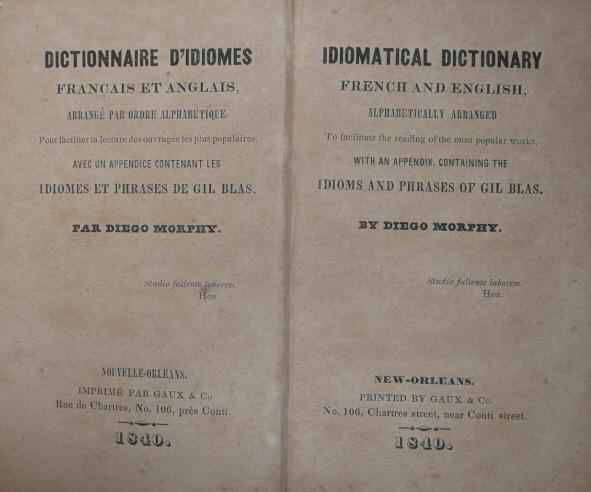
We note the following entry on pages 365-366 of Les écrits de langue française en Louisiane au XIXe siècle by Edward Larocque Tinker (Paris, 1932):
‘Diego Morphy, né à la Nouvelle-Orléans, fils de Diego Morphy, consul d’Espagne à la Nouvelle-Orléans et de sa femme Mollie Creagh; demi-frère du juge Alonzo Morphy, père de Paul Morphy qui, à son époque, était le champion du monde pour le jeu d’échecs. Est nommé, en octobre 1813, vice-consul d’Espagne et devient plus tard professeur de langues; épouse Eulalie Dubord, fille de Don Lorenzo Troisville Dubord et d’Eulalie Beaumont de Livaudais; enseigne jusqu’en 1852 et meurt de la fièvre jaune quelques années plus tard. Compose un dictionnaire à l’usage de ses élèves.’
He is marked in red on the family tree reproduced from page 112 of Morphy Gleanings by P.W. Sergeant (London, 1932):
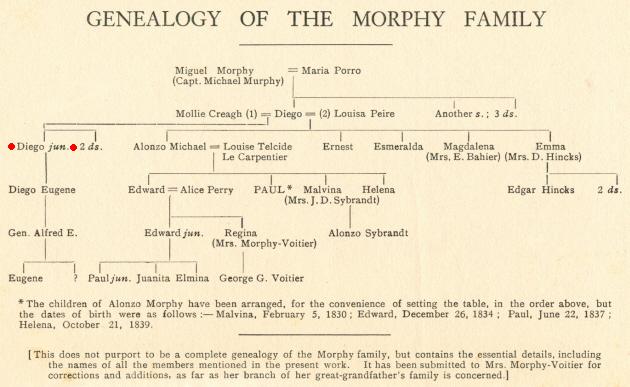
(6568)
C.N. 4297 noted that the entry on Löwenthal on page 122 of the Dictionary of Modern Chess by Byrne J. Horton (New York, 1959) stated:
‘One of Löwenthal’s famous quotations is: “The judicious violation of general principles marks the master-mind”.’
The exact source of the observation was requested, and we now see the following (a game between Morphy and Julien) on page 415 of Morphy’s Games of Chess by J. Löwenthal (London, 1860):
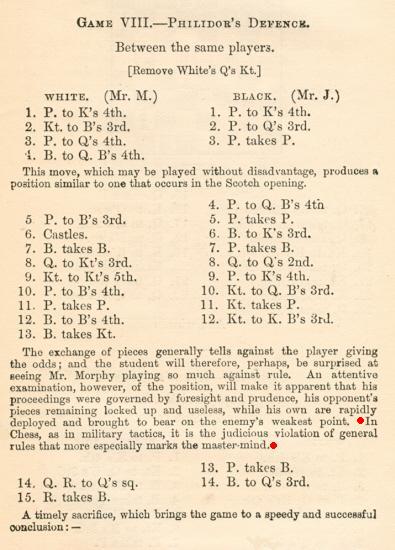
The wording is thus slightly different: ‘In Chess, as in military tactics, it is the judicious violation of general rules that more especially marks the master-mind.’
(6581)
The back cover of a recent work of fiction, Paul Morphy: Confederate Spy by Stan Vaughan (Milwaukee, 2010):
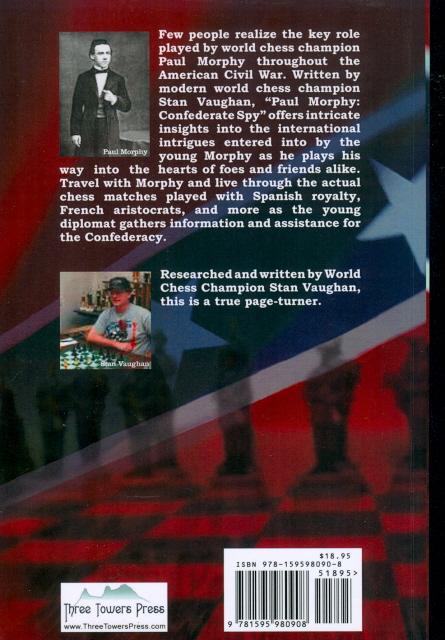
There is more information about the ‘modern world chess champion’ on the final page. It is stated, for instance, that S. Vaughan has the following titles and accomplishments:
(6919)
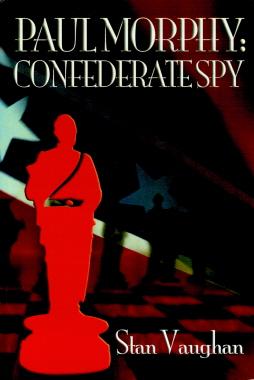
C.N. 6919 mentioned the work of fiction Paul Morphy: Confederate Spy by Stan Vaughan (Milwaukee, 2010). Now Rick Kennedy (Columbus, OH, USA) informs us that, as related on his webpage, he has noted cases of plagiarism. For example, page 63 has the following:
‘... an undigested cube of rock, and whoever designed it failed to realize that when plumbed down beside the delicate Moorish palaces upon which it encroached, it could only look ridiculous.’
Mr Kennedy found the identical passage (except for ‘plumped’ and ‘encroaches’) on page 227 of Iberia by James A. Michener.
As a small test of our own we opened the Morphy book at random and found, on page 113, whole chunks of text lifted by S. Vaughan from the website Exploring Toledo.
[Addition on 2 August 2013: the above Toledo link is not currently working.]
(7427)
There is an unexpected reference to chess and Morphy in Susan Sontag’s journal (part of an entry dated 24 October 1956), as published on pages 82-83 of Reborn edited by David Rieff (New York, 2008):

(6958)
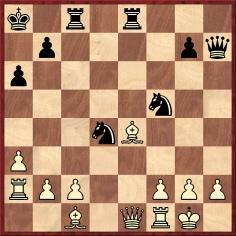
In reply to 1 c3 Black is said to have won with 1...Rxe4 2 Qxe4 Ng3 3 Qxd4 Ne2+ 4 Kh1 Qxh2+ 5 Kxh2 Rh8+ 6 Bh6 Rxh6+ 7 Qh4 Rxh4 mate.
Further details are unknown to us, although the position has been widely published. See, for example, page 403 of Paul Morphy Sein Leben und Schaffen by Max Lange (Leipzig, 1894) and page 431 of Paul Morphy by Géza Maróczy (Leipzig, 1909).
The four editions (1898, 1913, 1919 and 1923) of Der Weg zur Meisterschaft by Franz Gutmayer gave the position as ‘Bousserolle’ or ‘Bonserolle’ v Morphy. See also page 57 of Die Geheimnisse der Kombinationskunst (Leipzig, 1922). A blindfold win by Morphy (as White) against A. Bousserolles is known (the conclusion is on the above-mentioned page of Maróczy’s book), but on what basis did Gutmayer identify White in our diagrammed position?
(7408)
Further to the reference in C.N. 7408 to an alleged Morphy position against Bousserolle, Bonserolle or Bousserolles, we add that the conclusion of a different game (against Busserolles) was published on page 129 of the April 1859 Chess Monthly:
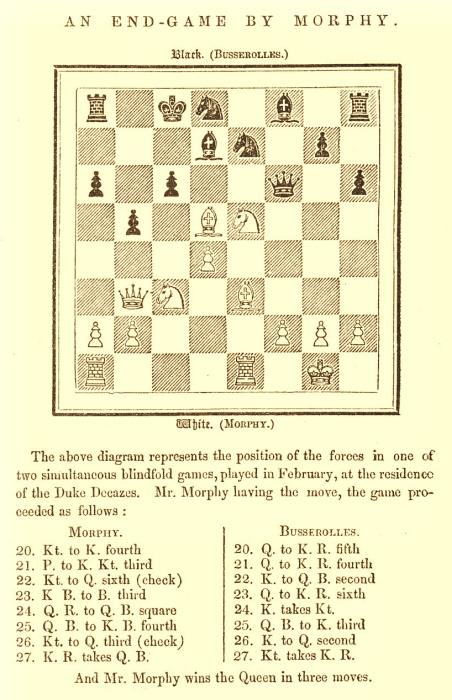
Page 132 of the same issue had the following regarding Morphy:
‘The Duke Decazes had given him a dinner, at which a number of grave senators and warlike generals assembled to do honor to the young hero. Mr Morphy, at the request of the company, played two simultaneous blindfold games and took part, at the same time, in an animated conversation.’
(7651)
Gene Gnandt asks whether the full name and birth/death dates of General Busserolles are available.
He also quotes from page 160 of David Lawson’s Paul Morphy The Pride and Sorrow of Chess:
‘On 14 February (as published in the New Orleans Sunday Delta, 27 March 1859), at a fête given
“by the Duke Decazes ... [Morphy] played two games blindfold against M. Prefect Lacoste and General Busserolles, both fine players, winning both. The moves were transmitted by Mr Lequesne ... and during the whole of the performance Mr Morphy sustained an animated conversation with Mme Decazes and several ladies and gentlemen.”’
(7679)
Which teenager published an annotated collection of Morphy’s games?
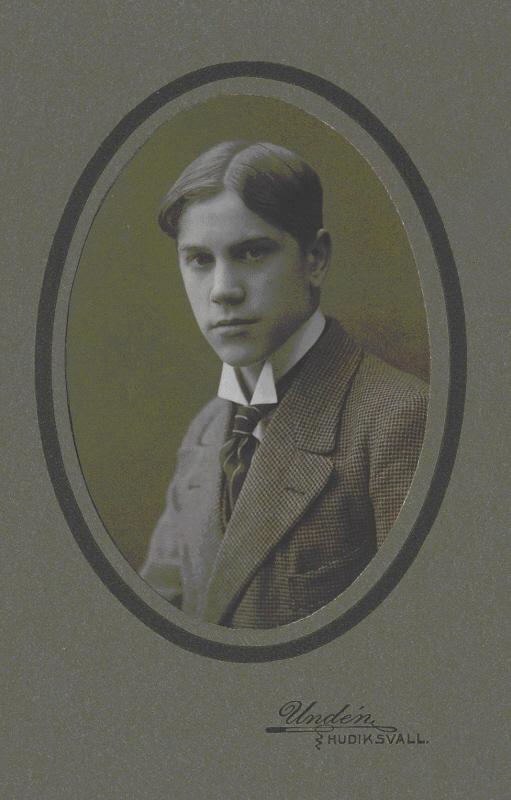
The answer is Bertil Rask, whose monograph Paul Morphy 180 partier (Stockholm, 1915) appeared around the time of his 17th birthday.
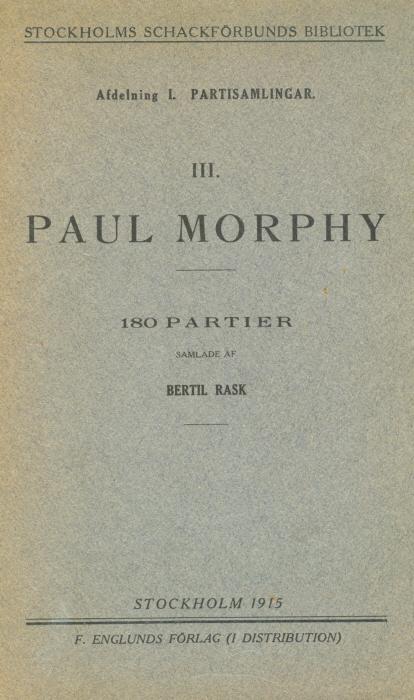
Rask died of tuberculosis in Stockholm in 1918, aged 20. Below is his obituary on page 170 of the August-September 1918 issue of Tidskrift för Schack:
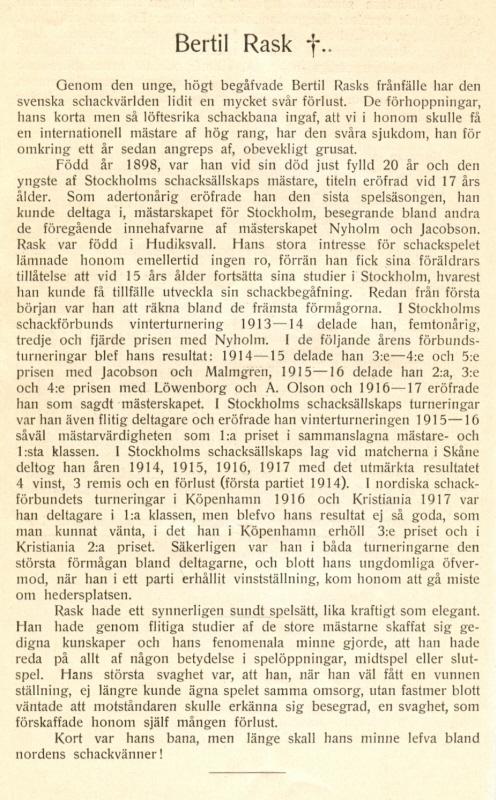
See also pages 392-393 of an admirable 526-page book Stockholms Schackförbund 1911-2011 by Peter Holmgren (Stockholm, 2011). We are grateful to Mr Holmgren for allowing us to reproduce the above portrait of Rask.
(7151)
A position from the sixth match-game between Morphy and Harrwitz, Paris, 1858:
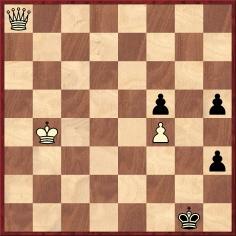
The finish – as given, for instance, on page 61 of Morphy’s Games of Chess by J. Löwenthal (London, 1860) – was 48 Qf3 and wins (‘for if 48...h2 49 Qg3+ Kh1 50 Qf2, mating next move’).
The conclusion was featured in an article ‘Some Historic Blunders’ by W.H. Watts on page 26 of a book co-written by him with A.W. Foster, The Year-Book of Chess 1915 and 1916 (London, 1917):
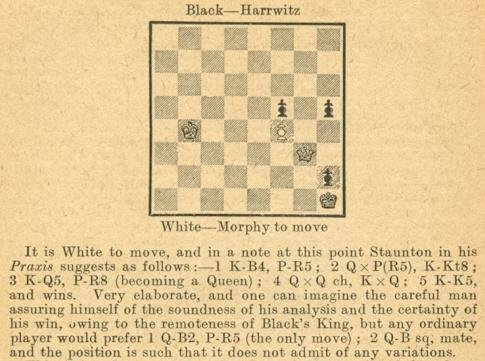
Page 480 of Staunton’s Chess Praxis (London, 1860) stated that after 48 Qf3 Black resigned, and the faulty line referred to by Watts was given in a footnote:
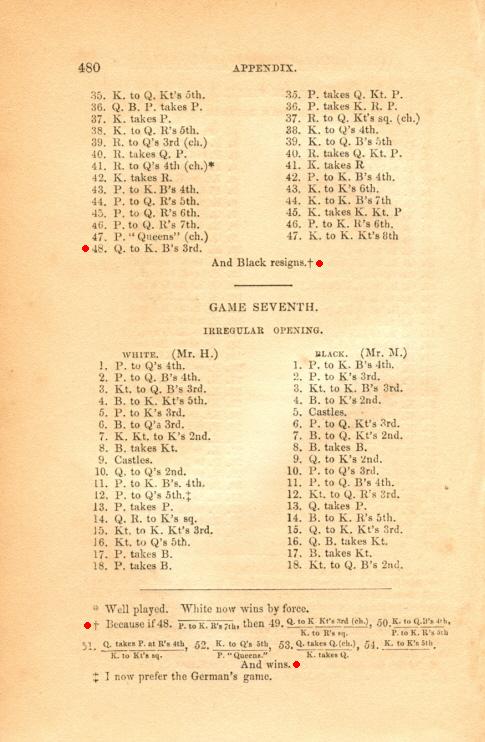
The matter is surprisingly complex, and we would make a number of points:
1) In Chess Praxis the game appeared in a lengthy ‘Appendix’ (pages 453-620) consisting of annotated Morphy games, and we are puzzled by a comment in a review of the book on pages 97-103 of the Chess Player’s Chronicle, 1860:
‘The third and last part of the book is called the Appendix, and consists of the well-known Morphy games to the number of about 150. These games are prefaced by a few lines which lead us to infer that the work was done by contract – so much for so much. The author says: “The notes to the games in the Appendix are generally taken from the publications in which they at first appeared, and are generally good, although we cannot always approve of the taste which prevailed in the choice of them.[”]’
That is a strange remark for any author to make, but in any case we cannot find the passage in our (1860) edition of Chess Praxis.
2) Staunton published the erroneous analysis in his Illustrated London News column of 9 October 1858 (page 344). We thank Rod Edwards (Victoria, BC, Canada) for a copy:
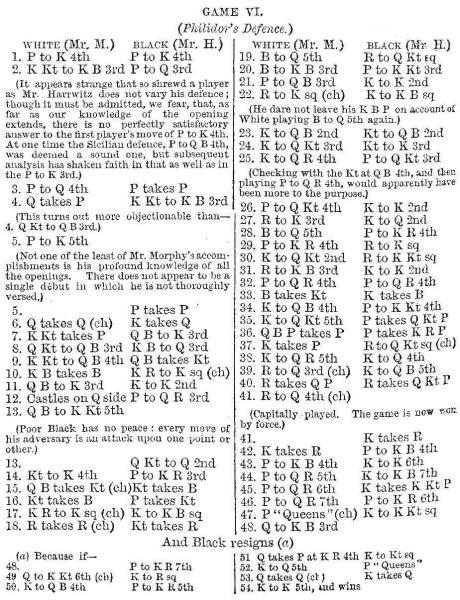
On page 340 of the November 1858 Chess Monthly the analysis by Staunton was repeated (without any indication that it was wrong):
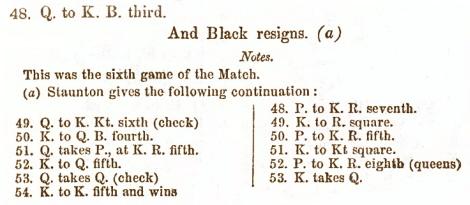
The same text, and still with notation errors, was reproduced on page 36 of Morphy’s Games of Chess, and Frère’s Problem Tournament by T. Frère (New York, 1859):
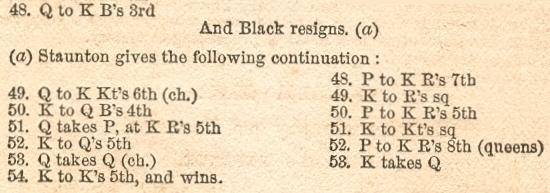
3) The line was given too, without any mention of Staunton, on page 241 of Paul Morphy, A Sketch from the Chess World by Max Lange (London, 1860):
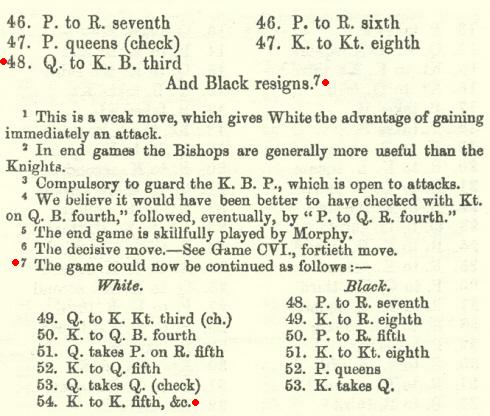
4) Page 109 of Choix des parties les plus remarquables jouées par Paul Morphy en Amérique, en Angleterre et en France by J. Preti (Paris, 1859) gave the same moves but indicated that they were played over the board:
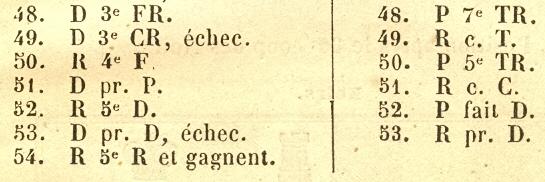
If the Preti book were correct, it would mean that, in the diagrammed position below, Morphy too missed 50 Qf2 and 51 Qf1 mate, during the game.
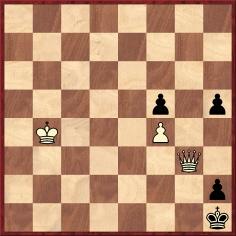
There is surely much more to be discovered about this matter.
(6593)
The missed mate in two was discussed on pages 196-197 of a book by W. Ritson Morry and W. Melville Mitchell, who unpersuasively concluded:
‘How could two such writers [Max Lange and Howard Staunton] miss the simple mate? One can only suppose the players themselves indicated the line after the game and nobody bothered to check.’
The book appeared in the 1960s and 1970s under a slew of titles: Chess: A Way to Learn; Chess The Elements and the Play; Tackle Chess This Way; Tackle Chess; Chess Theory and Practice.
(6634)
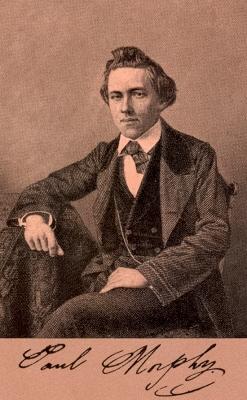
At the Chess Archaeology website an intriguing article has just been posted: ‘A New Morphy Game? Found by Nick Pope, Introduced by John S. Hilbert.’
(7115)
‘Paul Charles Morphy is the greatest chess player known to history, and it is doubtful if there will ever be a better one. ... What it does seem is that he defeated the game of chess.’
These words were quoted in C.N. 17 from the first paragraph of the article ‘Wizard of Chess’ by Robert Cantwell on pages 1079-1081 of The People’s Almanac #2 by David Wallechinsky and Irving Wallace (New York, 1978). The piece originally appeared on pages 16-18 of Yesterday in Sports edited by John Durant (New York, 1956).
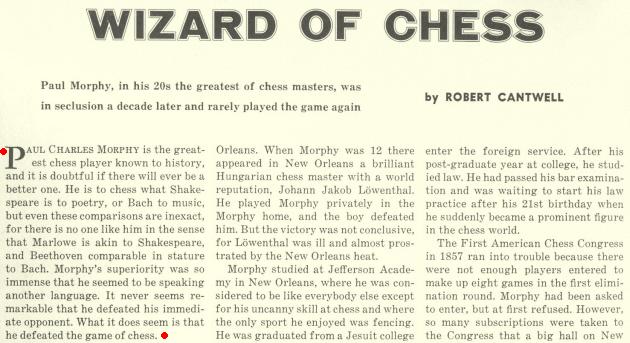
(7239)
In C.N. 17 we commented:
Morphy has been poorly served by his fellow countrymen, as indeed has Staunton by his.
The story about Morphy against the Devil, in connection with a picture by Moritz Retzsch, is too familiar to be repeated here. See, for instance, pages 235 and 269 of Paul Morphy The Pride and Sorrow of Chess by David Lawson, as well as the following non-exhaustive list of magazine items:
The oldest related item in our collection dates from the month before Morphy was born, i.e. The Saturday Magazine of 6 May 1837. Below are the front cover (page 169) and the text on page 170:
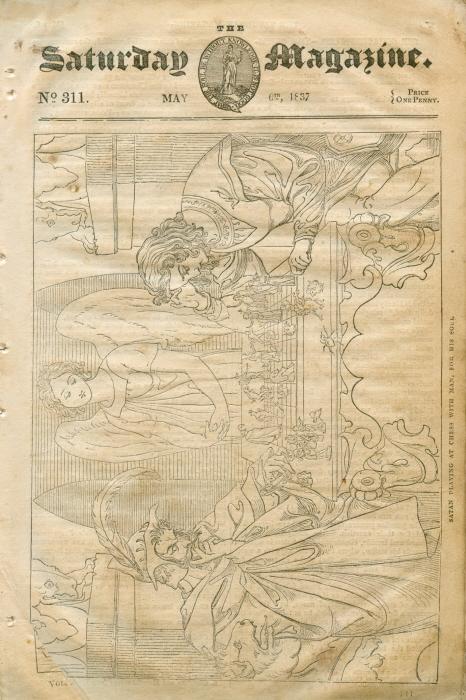
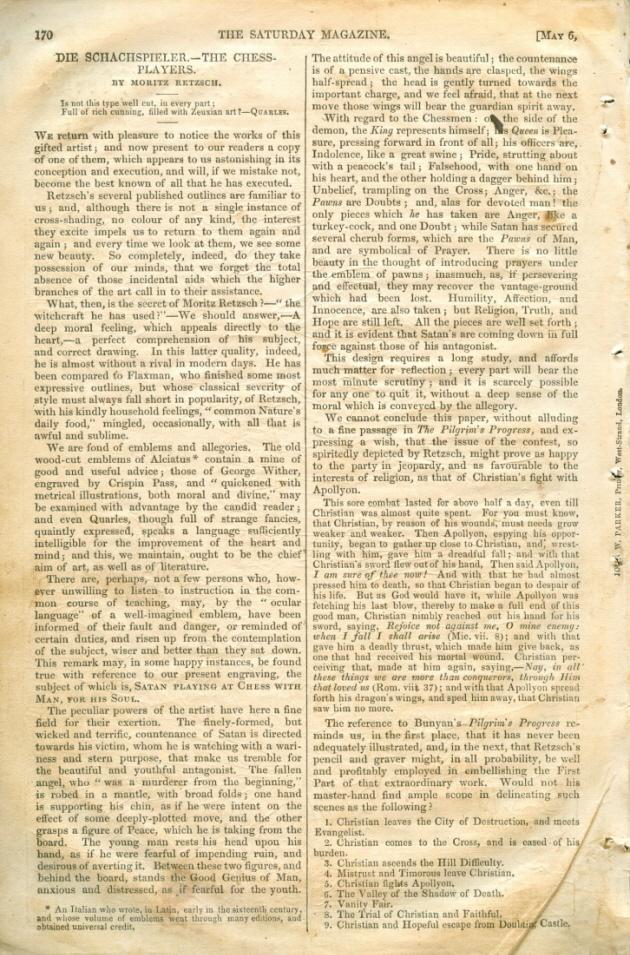
(7363)
The Editor of Virginia Chess, Macon Shibut (Vienna, VA, USA), authorizes us to reproduce an article by John T. Campbell which was published on pages 1-2 of the magazine’s November-December 1994 issue:
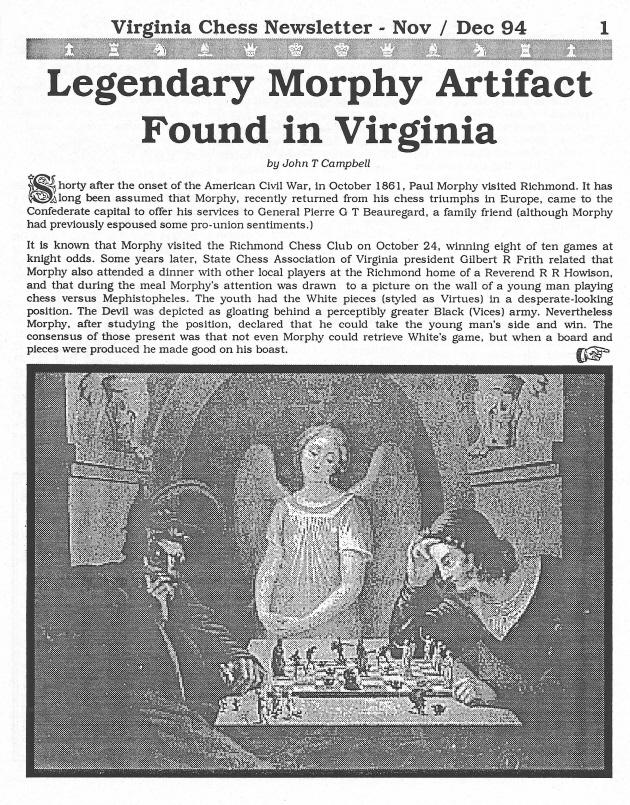
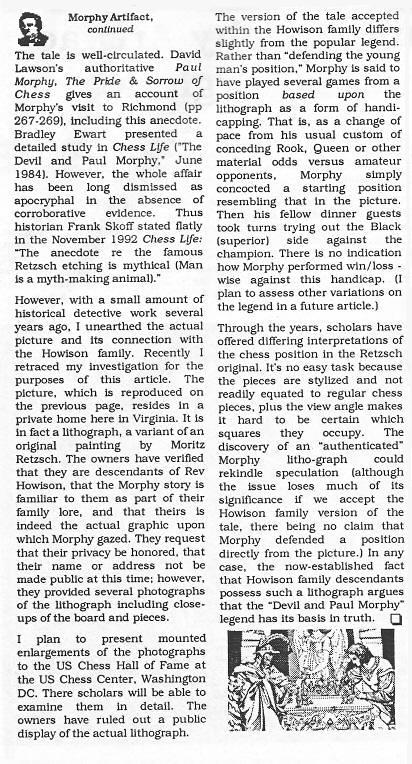
Our correspondent has also provided the picture in colour:
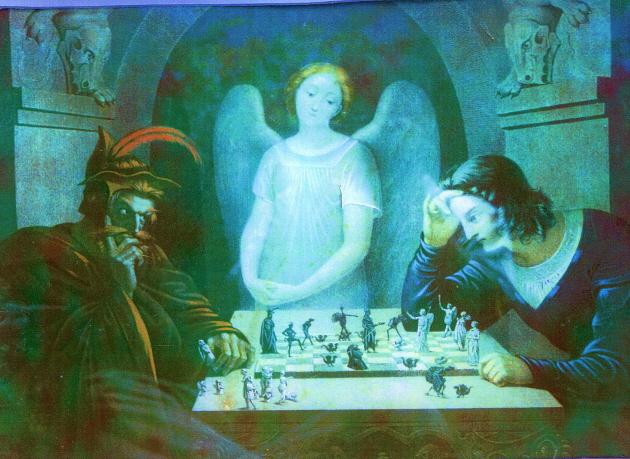
(7386)
A further article is ‘The Devil and Paul Morphy – Again’ by Bradley Ewart on pages 26-27 of Chess Life, June 1986.
(7399)
From our brittle edition of Frank Leslie’s Illustrated Newspaper, 31 October 1857 (page 344):
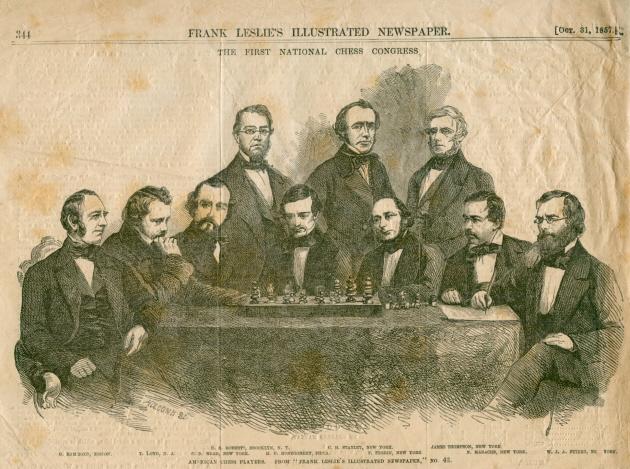
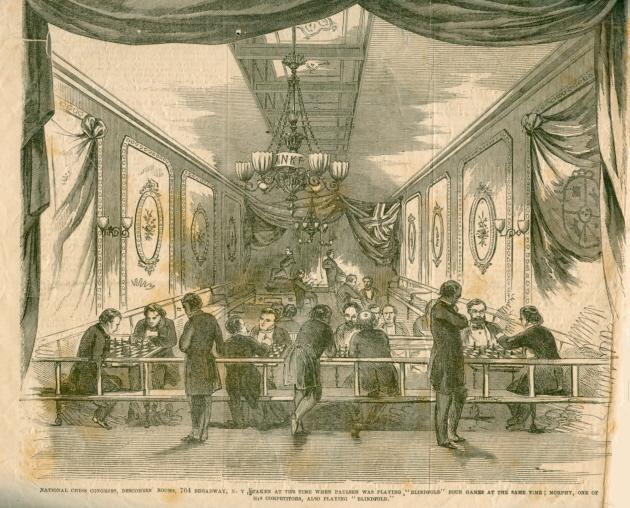
(7393)
These sketches appeared on page 345 of the 31 October 1857 issue of Frank Leslie’s Illustrated Newspaper:
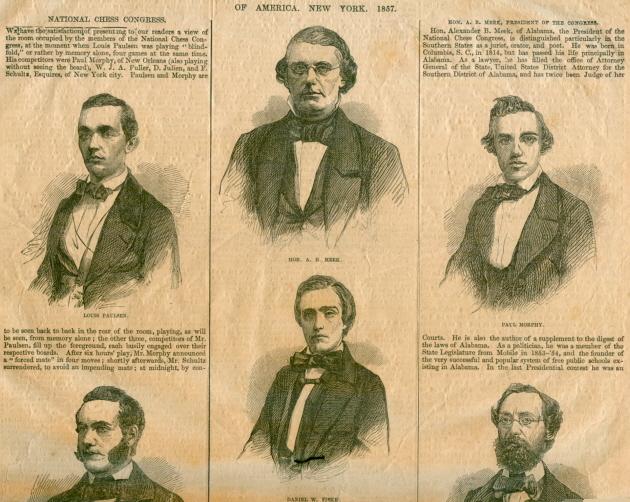
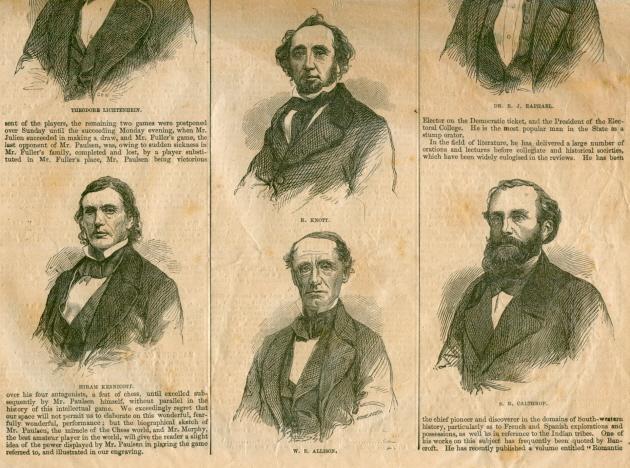
Larger versions of section one and section two
(7393)
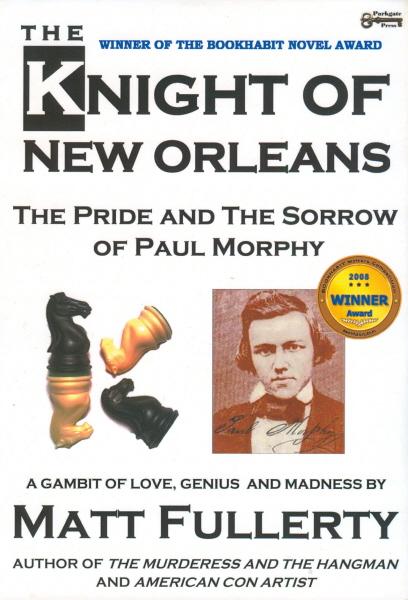
Matt Fullerty’s novel about Paul Morphy, The Knight of New Orleans, has been published recently, a 556-page hardback. Its introductory pages describe Emanuel Lasker as ‘World Chess Champion for 27 years (1894-1918)’ and Louis Paulsen as ‘Swedish-American’; in rapid succession there are also references to ‘Amserdam’ and ‘aritocrats’ and a misattribution to ‘Grandmaster [sic] Rudolph [sic] Spielmann’ of the book/magician/machine quote, which dates from the nineteenth century (see C.N. 4156). From an initial skim of the novel itself we noted off-puttingly frequent misspellings of French words and expressions, and the book has taken a low place in our reading pile.
(7419)
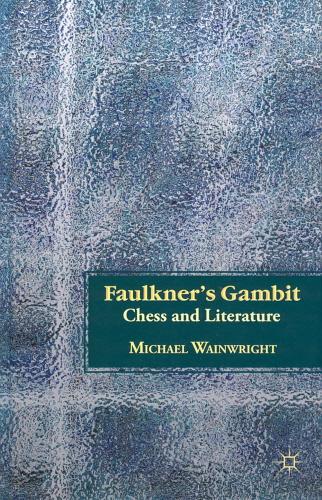
Also added to the reading pile is Faulkner’s Gambit (subtitle: Chess and Literature) by Michael Wainwright (New York, 2011). It ‘examines the chess structures, motifs, and imagery in William Faulkner’s only novella, situating this critically neglected work within both a historical and literary context’. A central thesis is that Faulkner’s character Gavin Stevens in Knight’s Gambit was inspired by Paul Morphy.
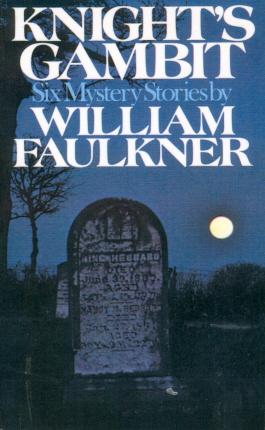
(7420)
Following J. Löwenthal’s death, page 69 of the Westminster Papers of 1 August 1876 referred to autobiographical information provided by the master to Men of the Time. Below we reproduce his full entry on page 665 of the ninth edition of that book, which was by Thompson Cooper and was published in London in 1875:
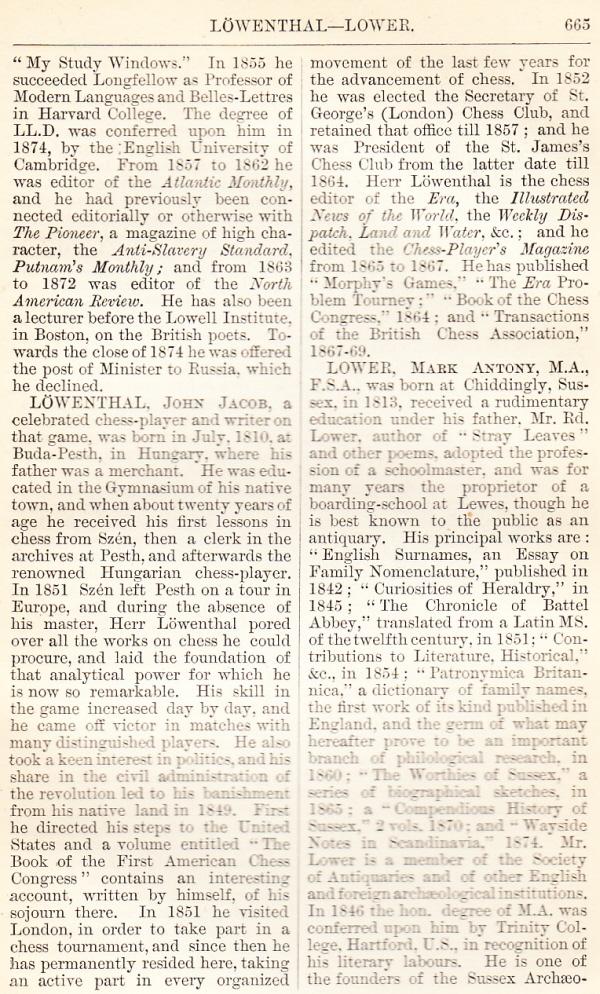
The entry for Morphy on page 740:
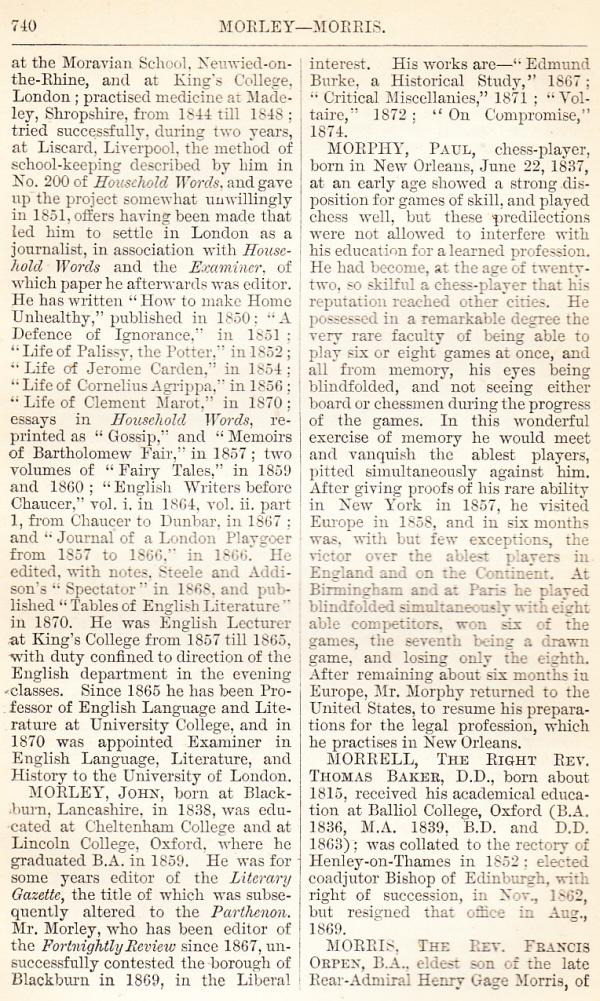
(7707)
Our item below appeared on pages 21-22 of the Autumn 1996 Kingpin:
When was the Bxh7+/Ng5+ attack first played? In The Chess Companion Irving Chernev annotated the game Morphy v Guibert, Paris, 1858. After Black’s 7...h6, he wrote (page 186):
‘Anybody else would have castled and fallen into the trap 8 BxPch KxB 9 N-N5ch, etc. An old trap to you and me, but it was invented 25 years after this game was played!’
Chernev contradicted himself two pages later on (an item reprinted from his column in the July 1953 Chess Review):
‘Another little idea that Paulsen anticipated is the ritual sacrifice of BxPch in the French Defense. Credit is usually given to Fritz, who surprised Mason with it in the Nuremberg tournament of 1883. So here to dispute the claim is an entry from a match [Paulsen v Schwarz] played in 1879.’
But what about Greco’s use of Bxh7+/Ng5+ in the early seventeenth century? An example even appears on page 90 of a previous book by Chernev, 1000 Best Short Games of Chess.
Page 331 of Kings, Commoners and Knaves mentioned that in 1925 the second issue of Les Cahiers de L’Echiquier Français (page 59) suggested that the Fritz v Mason game was the earliest specimen of Bxh7+ in a tournament game.
Chernev’s article about the Morphy game had originally appeared on the inside front cover of the April 1950 Chess Review:
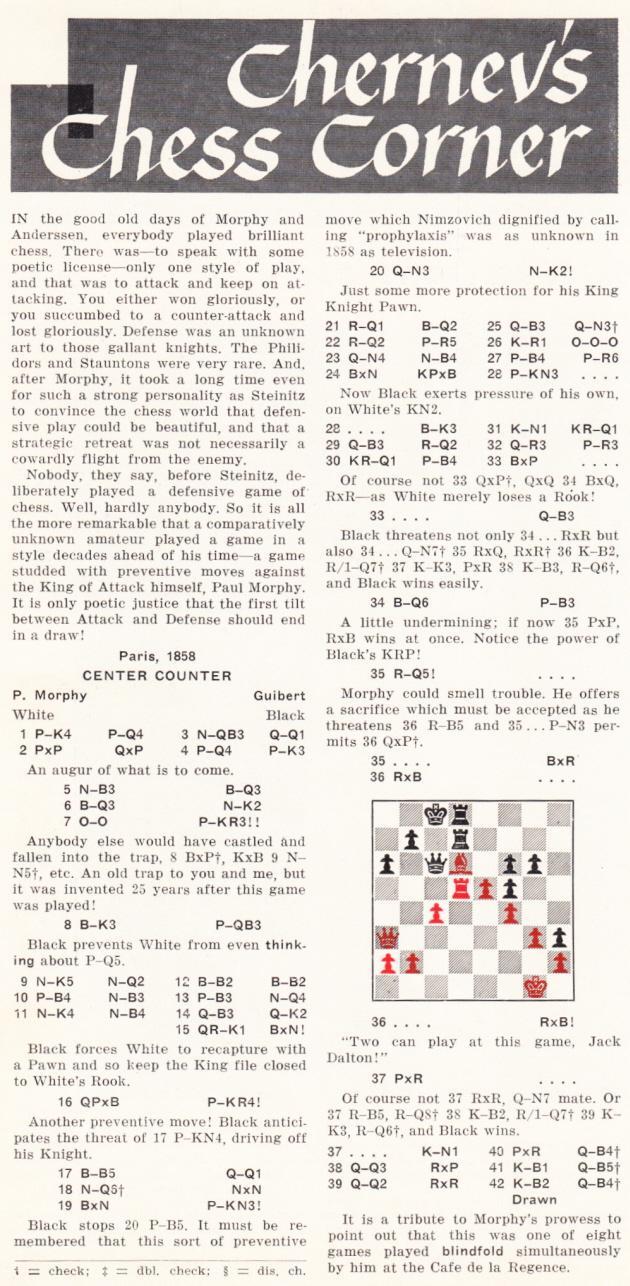
Is any biographical information available about Guibert?
(7979)
From Rod Edwards:
‘Guibert’s first initial was “A.”, as given at the end of a set of game commentaries which he wrote for La Régence (April 1849, page 113). Page 36 of the February 1851 issue listed members of the Cercle des Echecs of Paris, including “Guibert, rentier, aux Batignolles 66, rue Saint-Louis”.
He was mentioned in Le Palamède as early as January 1845 (page 33) and was still playing in 1874, according to citations given by Etienne Cornil in his collection Le Café de la Régence (quoting La Stratégie, 15 January 1874 and Le Monde Illustré, 7 March 1874).
A number of references mention Guibert as one of the strongest Parisian players (e.g. the Chess Player’s Chronicle, June 1849, page 188 and La Régence, May 1849, page 129). Staunton, on page 365 of the Illustrated London News, 16 October 1858, evaluated Guibert and Bornemann as “a shade weaker” than Baucher and Seguin, who “might almost aspire to the honour of playing without odds against Mr Morphy”. (They were all amongst Morphy’s opponents in his blindfold simultaneous exhibition in Paris.)
In Morphy’s Games of Chess (page 182) P.W. Sergeant wrote: “Guibert, one of the strongest Parisian amateurs; d. 1878.”’
The death of ‘M[onsieur] Guibert’ was reported on page 245 of La Stratégie, 15 August 1878. Fifteen lines long, the obituary gave no biographical facts.
(7982)
A quote from page 72 of The Fireside Book of Chess by Irving Chernev and Fred Reinfeld (New York, 1949):
‘Paul Morphy, considered by many critics the greatest chess genius that ever lived, never played 1 P-Q4.’
(7852)
Page 11 of Killer Chess Tactics by R. Keene, E. Schiller and L. Shamkovich (New York, 2003) states that the ‘second half of the book is a revised and updated version of World Champion Combinations, by Raymond Keene and Eric Schiller’.
Our 1998 article on that earlier book commented that page 18 ...
‘... has a game headed only ‘Morphy-Amateur’, yet a glance at a number of sources (including David Lawson’s biography of Morphy and Chess Explorations) would have sufficed to obtain Black’s name, P.E. Bonford.’
On page 208 of Killer Chess Tactics a correction to the game heading has been attempted:

(7884)
From page 70 of Ajedrez, March 1930:
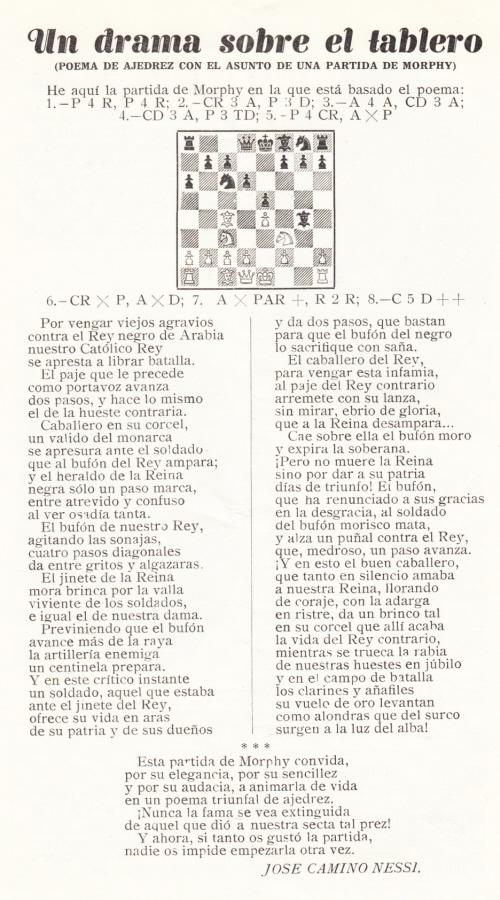
How did the game (1 e4 e5 2 Nf3 d6 3 Bc4 Nc6 4 Nc3 a6 5 g4 Bxg4 6 Nxe5 Bxd1 7 Bxf7+ Ke7 8 Nd5 mate) come to be ascribed to Morphy?
(7936)
From John S. Hilbert:
‘Can anyone provide concrete information confirming or contradicting Miron Hazeltine’s assertion that he was co-editor along with Daniel Willard Fiske of the Chess Monthly during 1857? Many years later, and speaking about himself in the third person, Hazeltine wrote that “He was co-editor with D.W. Fiske, A.M., of Vol. I American Chess Monthly” (American Chess Magazine, June 1897, page 7).
On pages 83-84 of Paul Morphy The Pride and Sorrow of Chess David Lawson asserted:
“The Chess Monthly was started as a joint venture by Daniel W. Fiske and Miron J. Hazeltine acting as editors and publishers. The first issue appeared in January 1857. However, Fiske observed the rising star of Morphy’s reputation during the Congress in October and wished him to join the magazine as co-editor. Since Fiske was apparently the principle [sic] party of the venture, it seems he eased Hazeltine out. Within a month after Morphy’s arrival in New York, Fiske was expressing the hope that Morphy would be editing with him, beginning in the new year. Before the middle of December the matter was settled, and the printer notified that Morphy and Fiske would be co-editors beginning January 1858.”
Lawson offered no supporting citations for any of his points. I have access only to a reprint of the Chess Monthly, but the title page of that reprint indicates that Morphy and Fiske were editors of Volume I, which apparently was bound early in 1858.
I would appreciate learning what, if any, contemporary sources either confirm or deny Hazeltine’s 1857 association with the Chess Monthly, and, if he was so associated, what evidence survives proving Fiske orchestrated his removal from the publication.’
(8129)
At the end of an article marking the death of William Robert Inge Dalton (pages 132-134 of the July-August 1931 American Chess Bulletin) Henry W. Barry quoted a letter received from Dalton (which appeared with some erroneous French):
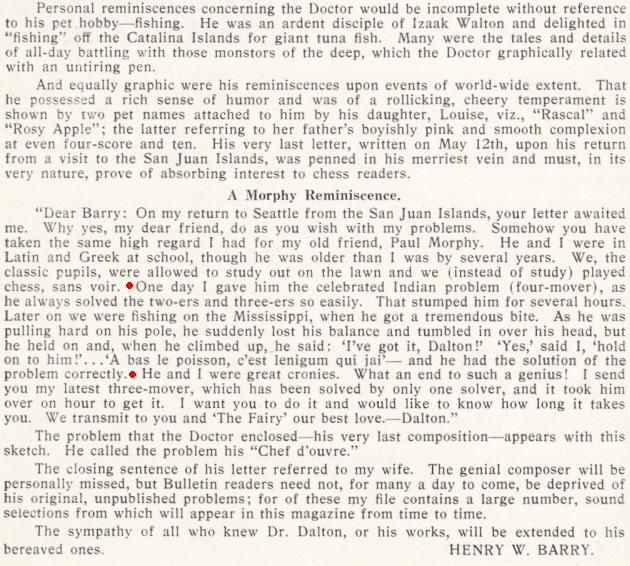
Referring to the letter, James Barrett commented on page 55 of the February 1981 BCM:
‘The late lamented David Lawson had no time for the garrulous Dr Dalton’s Morphy “reminiscences”, dismissing them pretty much out of hand, but the topic was discussed by him in the course of the 30 years’ correspondence we carried on about Morphiana.’
(8277)
The article below by G.H. Diggle was published in the December 1983 Newsflash and on pages 106-107 of Chess Characters (Geneva, 1984):
‘This Christmas marks the 125th anniversary of a match which caused a tremendous stir in Paris, and indeed throughout Europe, the opponents being Paul Morphy, aged 21, the “unstoppable” prodigy of the New World, who for six hectic months had carried all before him, and the last hope of the Old, Professor Adolf Anderssen, aged 40, winner of the first international tournament of 1851. Yet no great match before or since has been played with such chivalry, such lack of formality or such complete absence of diplomacy. There were no stakes, no time-limit, and no conditions except that the match was to go to the winner of the first seven games. The “seconds” were no more than privileged witnesses especially invited to the Hôtel de Breteuil. The match indeed would have been played in public at the Café de la Régence (a few hundred yards away) but Morphy’s doctor said “No”. The young American had been ill in bed with intestinal influenza for a whole fortnight, and actually had to be helped downstairs when, after the start had been held up for three days, the contest began in a private room in the presence of St. Amant, de Rivière, Journoud, Preti, Carlini, Edge, James Mortimer and Dr Johnston, Paris correspondent of the New York Times. Down the street at the Régence, “the greatest excitement prevailed”, and a large cosmopolitan crowd followed the game on three boards, a messenger carrying the moves from the hotel every half-hour.
The 11 games of the match ( M. 7, A. 2, Drawn 2) were played off in only nine days (20-28 December) two games being played on 23rd, 25th and 27th with one blank day (26th). Anderssen (ignoring the remonstrances of his own countrymen) gave up his Christmas holiday to the match, and travelled in mid-winter 600 miles each way to play – Morphy insisted on paying all his expenses. The great German master opened with a win and a draw, but then Morphy took complete charge and scored the next five games running. The eight-hour sixth game (like the great 13th game between Fischer and Spassky) virtually decided the match – Anderssen with the score 3-1-1 against him had made a great effort, but missed his way just at the end. In the ninth game he was brilliantly slaughtered in “scarcely half an hour”, but rallied bravely in the tenth (played immediately afterwards), which he scored after a “long and trying endgame”. “Mr Morphy wins his games in 17 moves, while I take 77”, said the philosophical Professor. But the end came next day with a seventh American victory, and the two great players parted on excellent terms, never to meet again.
Press coverage of the match, in the hands of such excitable Morphy fans as Fred Edge and the more likeable old French journalist Alphonse Delannoy, makes rollicking reading. According to the fanatical Fred, Anderssen “would sit at the board, examining the frightful positions into which Morphy had forced him, until his whole face was radiant with admiration of his antagonist’s strategy and, positively laughing outright, he would commence resetting the pieces for another game”. Delannoy surpasses even this. At the Régence, after Anderssen had won the first game, “no description of the passionate and frantic boastings of the Germans can be made. ... They opened their purses, put out gold and bank-notes. ... They doubled, tripled their bets in the proportion of two, three and five to one”. Later on, when Morphy turned the tables, “the despair and astonishment which ensued after the battle of Jena are only frous-frous and meows of cats compared to the thundering noise, energetic oaths and the outbursts with which La Régence was then stunned.” This was “vintage Delannoy” at its fizziest, but the best account of the match, of course, is in the late David Lawson’s fine work on Morphy.’
(8448)
Wanted: information about E.T. Fellowes, with whom Morphy had a law practice (from circa 1872 to 1874, according to pages 290-291 of David Lawson’s book on Morphy).
David DeLucia (Darien, CT, USA) has authorized us to show from his collection the two attorneys’ business card (as well as an earlier card of Morphy’s, dated November 1864):
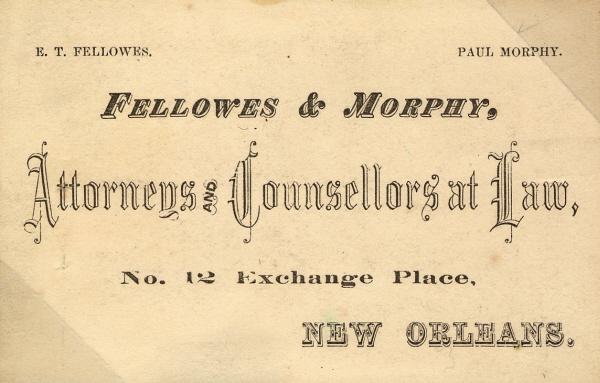
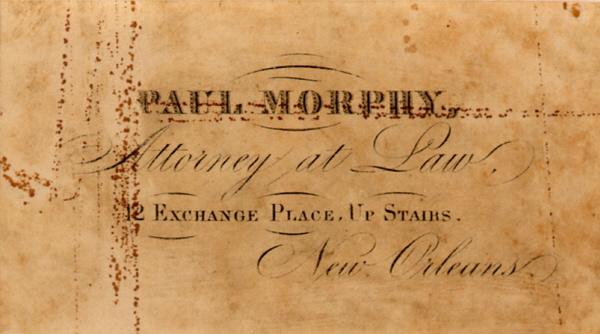
(8469)
Michael McDowell (Westcliff-on-sea, England) has found that the New York Clipper can be viewed on-line [broken link], using the site’s ‘Browse Archive’ function. He comments that the chess column was usually published on page 6 of the Saturday edition and that there were also occasional chess features elsewhere.
Morphy’s only authenticated problem, composed some seven years previously, is on page 78 of the 28 June 1856 edition. (For further information, see pages 18-19 of David Lawson’s biography of Morphy.)
(8473)
Jerry Spinrad forwards a report published on page 11 of Der deutsche Correspondent (Baltimore), 16 August 1884 which had previously appeared in Bahn Frei:
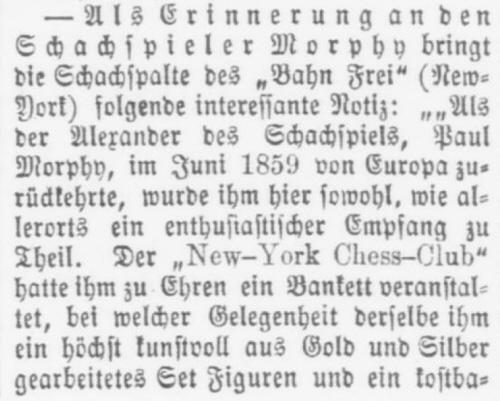
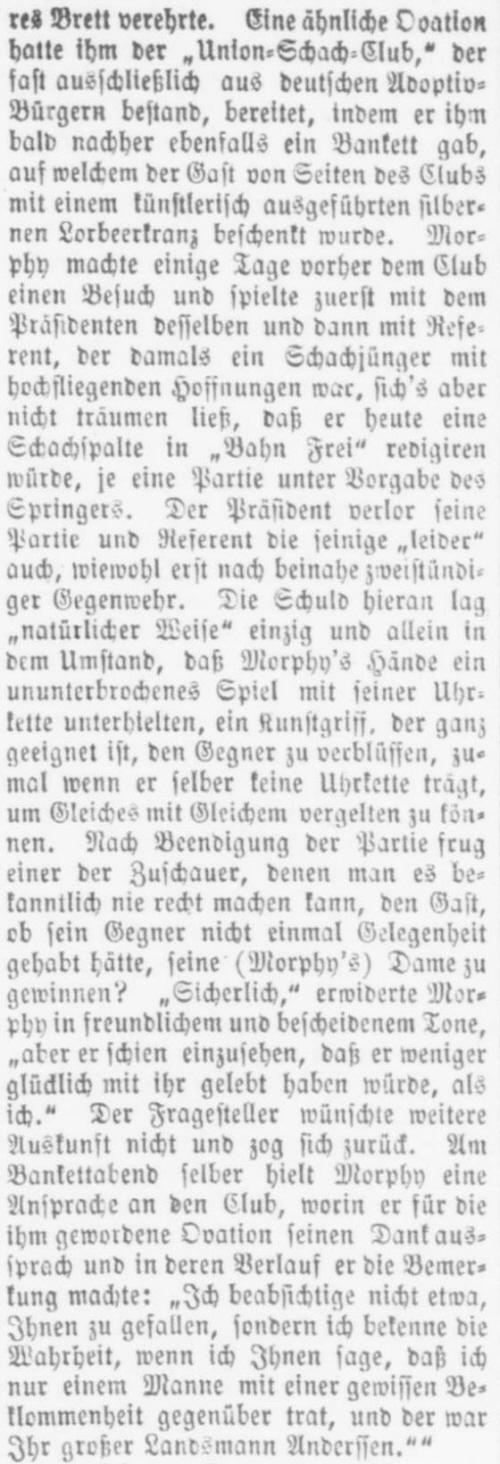
Mr Spinrad comments:
‘This report confirms that the Bennecke who played Morphy at the Union Club was H. Bennecke, who was later the chess editor of Bahn Frei, and not his brother L. Bennecke, who was also a club member and later a minor problem composer. It is also the only instance I know of where an opponent claimed that Morphy did anything distracting during play.’
Our correspondent seeks clarification of the meaning of Morphy’s alleged remark about taking the queen, as quoted in the report. It is indeed obscure, to say the least, and we should like to find the original report in Bahn Frei before embarking upon any detailed discussion of the episode.
(8552)
Drawing attention to a bizarre report on page 96 of Le Monde Illustré, 5 February 1876, Jerry Spinrad comments:
‘Even though the report exaggerates the size of Morphy’s blindfold exhibition, stating that it was on 12 boards, it more or less dismisses as unimportant the fact that it was given blindfold. The writer suggests that Morphy, a lazy Creole, seemingly dozed in the comfort of an armchair and merely murmured his moves. Rosenthal’s over-the-board simultaneous display, in which he had to walk constantly, is regarded as far more impressive.’
Three games from Rosenthal’s 29-board exhibition (Paris, 28 January 1876) are given in A Forgotten Showman.
(8611)
Hans Renette seeks information about the provenance of a picture on page 105 of Paul Morphy The Pride and Sorrow of Chess by David Lawson:
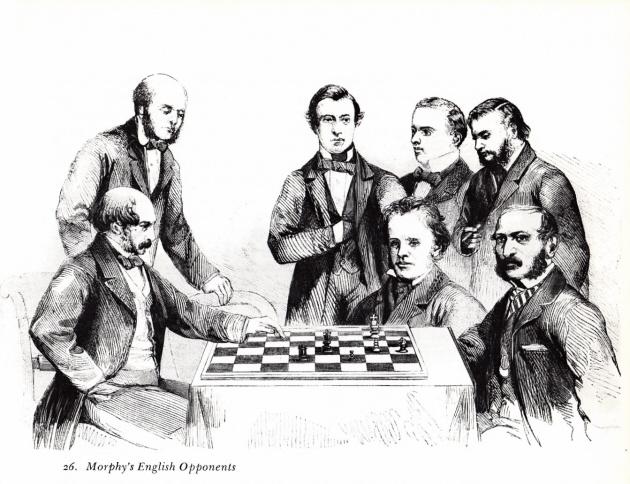
In the paperback edition (Lafayette, 2010) it was on page 190 (with a slightly different caption: ‘Paul Morphy’s British opponents’).
For purposes of comparison we add an illustration discussed in Pictures of Howard Staunton:
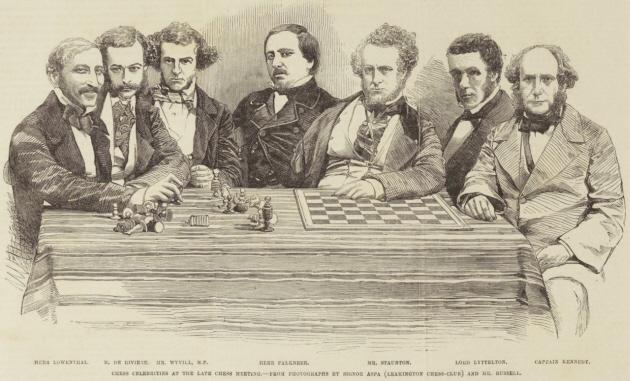
Source: Illustrated London News, 14 July 1855, page 44.
When this latter picture was given on page 85 of The World of Chess by Anthony Saidy and Norman Lessing (New York, 1974) the players were not identified, and the reader was merely informed:
‘Staunton (third from right) among cronies.’
(8705)

Hans Renette suggests, very tentatively, this caption (from left to right): T.W. Barnes, G. Walker, S.S. Boden, A. Mongrédien, H.E. Bird, R.W. Wormald and J.J. Löwenthal.
(8817)
Can any reader take the matter forward? For example, where was the illustration published before 1976 and, particularly, in the nineteenth century?
(9437)
Fabrizio Zavatarelli (Milan, Italy) reports that the picture was published in the Illustrated News of the World, 14 September 1861 with the following key (left to right): H.A. Kennedy, T. Hampton, S.S. Boden, C.H. Stanley, L. Paulsen, I. Kolisch and J. Löwenthal. The heading was: ‘Great chess match between London and Bristol, Thursday, 12 September 1861. Group at the Athenæum, Bristol.’
Thus David Lawson’s caption, ‘Morphy’s English Opponents’, was not only vague but inaccurate.
As reported on, for instance, page 3 of the Morning Chronicle, 13 September 1861, the London v Bristol match was played by electric telegraph and comprised one consultation game and six single-handed games.
The many detailed press reports on the match which were published on 13 September, or shortly afterwards, are a reminder of the astounding speed with which newspapers operated at that time.
(9472)
Part of an article ‘Sketches from the Chess World’ by Ernst Falkbeer on pages 53-54 of the June 1881 issue of Brentano’s Chess Monthly:
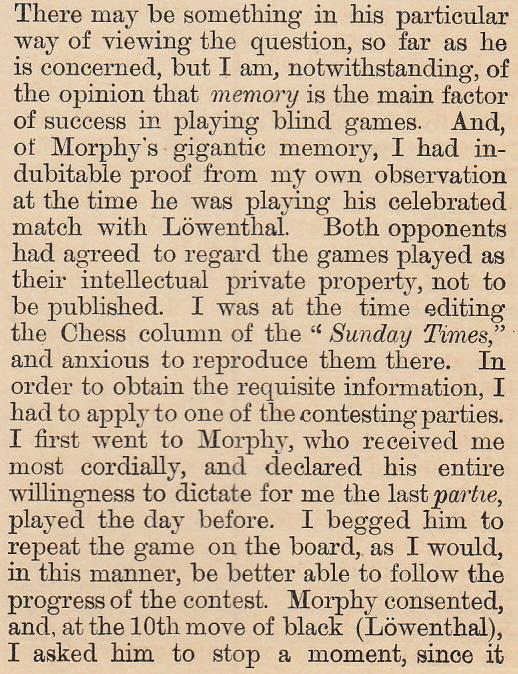
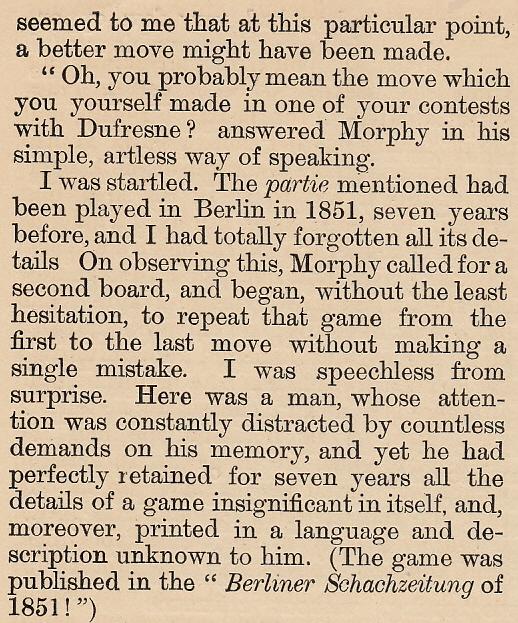
The article was translated from the Deutsche Illustrirte Zeitung, and we wonder whether the details about the memory episode can be verified.
The Morphy v Löwenthal match conditions did indeed stipulate that the games were the joint property of the players, as reported in Löwenthal’s column in the Era, 18 July 1858, page 13:
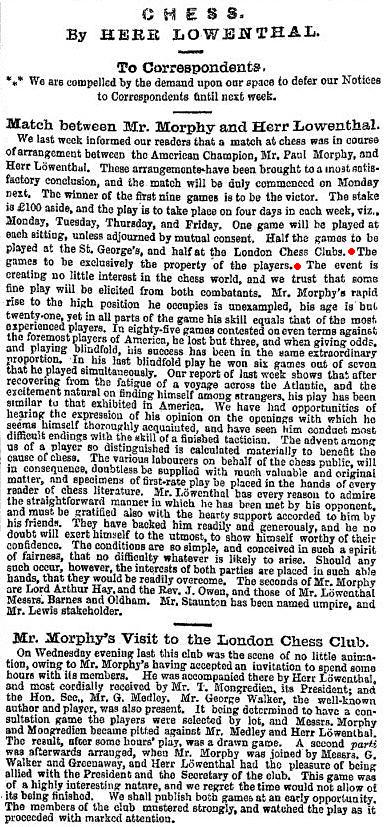
See too page 284 of the Chess Monthly, September 1858 and page 108 of David Lawson’s biography of Morphy.
Below is the first column by Falkbeer to give a game from the Morphy v Löwenthal match (Sunday Times Supplement, 8 August 1858, page 4):
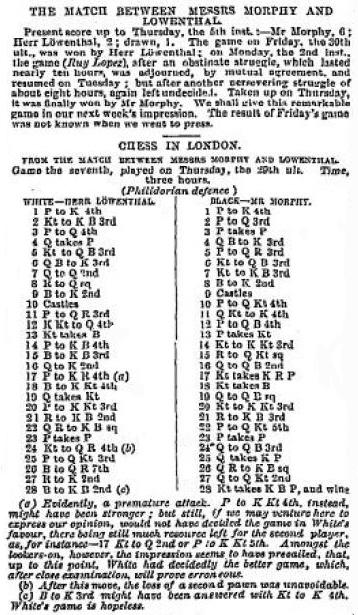
We have yet to find anything of relevance to the Falkbeer/Dufresne matter in any columns in the Era or Sunday Times from 1858, in Max Lange’s book on Morphy (London, 1860), which was translated and adapted by Falkbeer, in the collection of Morphy’s games by Löwenthal (London, 1860), or in any periodicals published in 1851.
(8717)
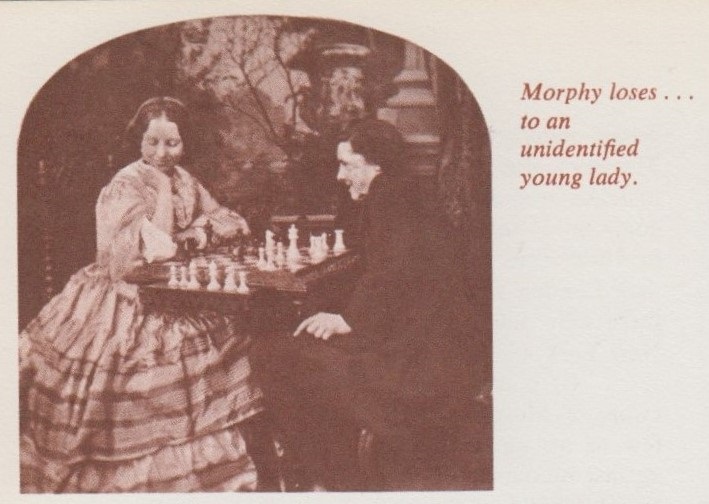
This photograph comes from page 40 of Chessworld, January-February 1964, in an article on Morphy by David Lawson. One of two similar shots, it was also given (‘Paul Morphy and a lady’) on page 333 of Lawson’s 1976 biography of Morphy. Page 109 showed the same setting in a photograph of Morphy and Löwenthal (‘London, 1858’).
Even so, page 94 of Arte y Ajedrez by Gabriel Mario Gómez (Buenos Aires, 2014) bizarrely asserts that the photograph was taken in the gardens of Buckingham Palace and that Morphy’s opponent was Queen Victoria:
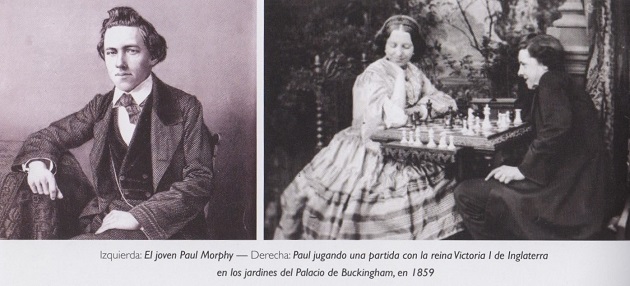
Chess and British Royalty notes a discussion of Morphy and Queen Victoria on pages 200-201 of Lawson’s book, which included this passage:

The full text of that newspaper report.
(8968)
Addition on 12 December 2022:
From John Townsend:
‘You note that the photograph of Morphy sitting opposite the “unidentified young lady” is in the same setting as one of Morphy and Löwenthal, which David Lawson described as “London, 1858”. It seems to be a reasonable working hypothesis that both were taken during the match between them.
According to Löwenthal’s 1860 book, Morphy’s Games (page 69), the match began in London on 19 July and ended on 22 August 1858, Morphy’s seconds being Lord Arthur Hay and the Rev. John Owen.
Lord Arthur Hay (1824-78), as he was then called, was the son of the 8th Marquess of Tweeddale and was an enthusiastic supporter of Morphy. Having duties as a second, he needed to keep Morphy’s company frequently during the match. He was born on 9 November 1824 and had been married in London on 18 February 1857 to a younger woman, Helena Eleanora Augusta de Kielmansegge, the only child of Count de Kielmansegge (source: Burke’s Peerage, 1875, page 1168). She died on 30 September 1871 at Chislehurst, Kent; according to her death notice in the Illustrated London News of 7 October 1871 (page 13), she was born in August 1836, so she was 21 or 22 at the time of the match.
The photographs could have been taken near the start of the match on a day when Lord Hay brought along his wife. Their London residence at that time was a house in Chester Square, Pimlico. She left London in the early stages of the match, on 21 July, “for the baths of Kissengen”, according to the Morning Post of 22 July 1858 (page 5). Lord Hay remained in town.
Can a likeness of Lady Hay be found for comparison? In 1862 she became Viscountess Walden, and was later appointed a Lady of the Bedchamber to the Princess of Wales.
Lord Arthur Hay was the only one of Morphy’s eight opponents who obtained a draw against him in the blindfold simultaneous exhibition at St George’s Chess Club on 20 April 1859, as was described on pages 208-210 of Lawson’s book on Morphy.’
From Rod Edwards:
‘One would expect the identities of players in as important an event as Morphy’s blindfold exhibition at the London Chess Club on 13 April 1859 to be well established, but that is not the case for one of his opponents, who is referred to in many sources only as “Jones”.
On page 187 of Morphy’s Games of Chess (London, 1916) P.W. Sergeant gave his name as “J.P. Jones”, as did David Lawson’s biography of Morphy. However, on page 8 of the 17 April 1859 edition of Bell’s Life in London George Walker, who took a board in the display, identified him as “Alfred Jones”. Walker also wrote “Alfred Jones” when he published the game on page 3 of the 19 June 1859 issue of Bell’s Lif e in London:
1 e4 e5 2 f4 exf4 3 Nf3 g5 4 Bc4 g4 5 d4 Qe7 6 O-O gxf3 7 Nc3 c6 8 Qxf3 Bg7 9 Bxf4 Bxd4+ 10 Kh1 Bg7 11 e5 Bh6 12 Ne4 d5 13 exd6 Qf8 14 Rae1 Be6 15 Bxe6 fxe6 16 Qh5+ Kd7 17 Nc5+ Kc8 18 Bxh6 Nf6 19 Qe5 Nbd7 20 Nxd7 Qxh6 21 Rxf6 Qh4 22 Nc5 and wins.
Data on J.P. Jones and Alfred Jones would be appreciated, as would information on how the discrepancy arose.’
On page 104 of Morphy Gleanings (London, 1932) P.W Sergeant noted, without further comment, that Bell’ s Life in London had called Morphy’s opponent ‘Alfred Jones’. That was also the name given in other newspaper reports on the exhibition, e.g. the London Daily News, 20 April 1859, page 2, and the Times, 21 April 1859, page 12.
The provenance of ‘J.P. Jones’ is unclear, but two pre-Sergeant sightings can be mentioned: page ix of Paul Morphy Sein Leben und Schaffen by Max Lange (Leipzig, 1894) and page 290 of Paul Morphy by Géza Maróczy (Leipzig, 1909). The former book had ‘Jones, J.P.’ in the index on page ix:
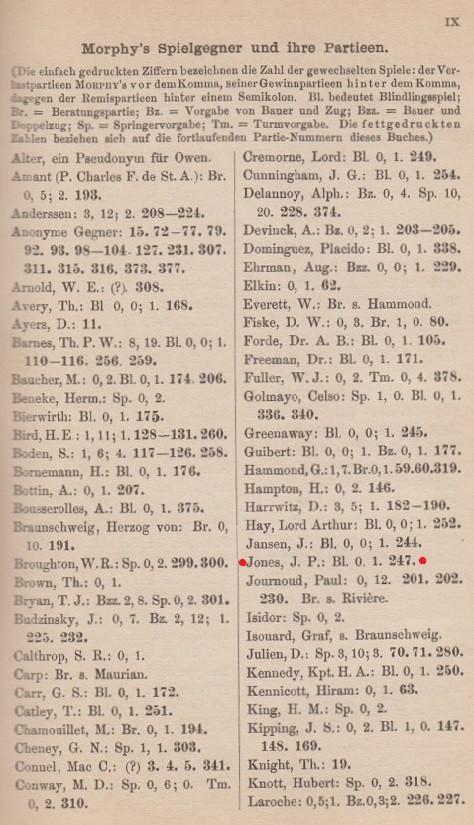
Confusion over players’ initials is not limited to Jones. Two of Morphy’s other opponents in the London display were indexed in Max Lange’s book (page x) as ‘Maude P.’ and ‘Slous, P.’, whereas Lawson’s biography (page 193) and other sources give their initials as G. and F.L. respectively.
(8906)
Whereas no reference to a player called J.P. Jones has been found, many appearances of the name Alfred Jones can be cited. For example, John Townsend refers to an account of the ‘Annual Dinner of the London Chess Club’ on page 14 of the Era, 28 May 1865:
‘The chair was occupied by A. Mongredien, Esq., President of the Club; and the vice-chair by Alfred Jones, Esq.’
Jerry Spinrad notes an obituary of Alfred Jones on page 180 of the Westminster Papers, 1 March 1870:

(8910)
From William D. Rubinstein (Melbourne, Australia):
‘His name makes precise identification difficult, but he is presumably the Alfred Jones of 7 (other sources state 72) Queen Street, Cheapside, City of London and 117 Harley Street, Middlesex, “gentleman”, who died on 29 January 1870 at 117 Harley Street, leaving £35,000 (resworn from £30,000). His executors were his sister Mary Shephard Jones of 117 Harley Street and his brother Horace Jones of 13 Victoria Street, Middlesex. Oddly, I could find no death notice for Alfred Jones, and could not trace him in the Census, and do not know his age at death. His brother Horace Jones was almost certainly Sir Horace Jones (1819-87), the architect who designed Tower Bridge and was President of the Institution of British Architects in 1882-84 and was knighted in 1886. (Information from ancestry.co.uk and the Oxford Dictionary of National Biography.)’
(8915)
William D. Rubinstein adds:
‘I have learned that Alfred Jones was born on 12 July 1812 and baptized at St Stephen Walbrook Church in the City of London, the son of David Jones and Sarah Lydia née Shepard. According to his (almost certain) brother’s entry in the Oxford Dictionary of National Biography, David Jones was a solicitor. I have also now traced Alfred Jones in the 1861 Census, where he was listed as a “solicitor” at Wandsworth Common, living with his two sisters. He was unmarried.’
Gene Gnandt wonders whether Alfred Jones was a Justice of the Peace and, if so, whether use of the initials ‘J.P.’ resulted in a mistaken belief that they represented his forenames.
We note that the index on page 313 of Paul Morphy. Skizze aus der Schachwelt by Max Lange (Leipzig, 1881) had ‘P. Jones’.
(8924)
Page 92 of Chess Made Easy by Muriel Goaman (Toronto, 1973) has one brief paragraph on Morphy:
‘Another child prodigy was Paul Morphy (1837-1884), who was a Master of chess at the age of 13. After three years he gave up international chess.’
(9039)
From page 41 of Шахматный калейдоскоп by A. Karpov and Y. Gik (Moscow, 1981):
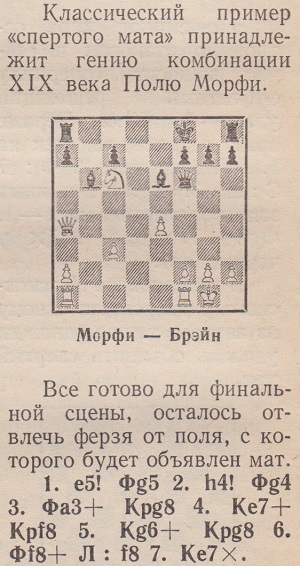
Page 26 of the English edition, Chess Kaleidoscope (Oxford, 1981), named Black as ‘Brain’:
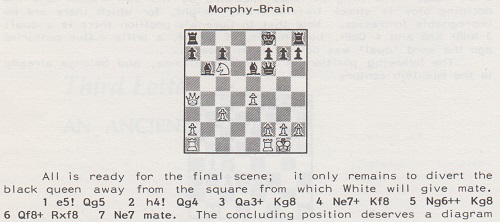
The game between Morphy and Thomas Jefferson Bryan is in most Morphy collections, e.g. on page 280 of Paul Morphy. Skizze aus der Schachwelt by Max Lange (Leipzig, 1881).
Bryan’s name is most commonly seen nowadays in connection with the ‘Bryan Counter-Gambit’: ...b5 after either 1 e4 e5 2 f4 exf4 3 Bc4 or 1 e4 e5 2 f4 exf4 3 Bc4 Qh4+ 4 Kf1. For example, various editions of the nineteenth-century work Synopsis of the Chess Openings by William Cook stated that the defence was devised by Bryan and subsequently analysed and recommended by Kieseritzky. The involvement of Kieseritzky in the opening is well documented (quite apart from the Immortal Game), but what about Bryan? And how to explain the fact that, also in the late nineteenth century, editions of Chess by R.F. Green, as well as Green’s ‘Index to the Openings’ appended to reprints of Staunton’s Handbook, called 1 e4 e5 2 f4 exf4 3 Bc4 b5 ‘Brien’s Counter Gambit’.
Such references to Robert Barnett Brien are surprising, as is a comment by C.E. Ranken on page 119 of the March 1901 BCM, after 1 f4 e5 2 e4 exf4 3 Bc4 b5 in a game between H. Brewer and W. Atkinson:
‘This ingenious counter attack is the invention of Mr S. Calthrop, of Trinity College, Cambridge, and now of New York, who played it frequently in the forties with the late Mr Brien, of Oxford.’
Have these historical discrepancies already been investigated, and perhaps even resolved, by opening theoreticians?
(9045)
Rod Edwards forwards a paragraph from J. Löwenthal’s column on page 5 of the Era, 1 December 1861:
‘Mr Paul Morphy. Now that so many distinguished players have had an opportunity of displaying their powers in this country, and under the eye of our most eminent amateurs, an opportunity has been afforded of comparing Mr Morphy’s play with that of others of the highest pretensions, and the conclusion which is come to on all hands, even by these eminent players themselves, is that Mr Paul Morphy stands on a pedestal far above any other living player. We ourselves have long maintained this opinion; but we will not conceal that we have been most anxious to see Europe vindicate its old prestige. However, at present, it must be admitted that America boasts the Chess Champion of the World. Mr Morphy’s games have exhibited in the very highest degree a pre-eminence of skill in every branch. His extraordinary quickness of perception, his power of combination, the accuracy of his strategy, and the genius and originality which characterizes the whole conduct of his play, combine to render him a perfect prodigy of power as a chessplayer. It is hoped that efforts will be made to secure Mr Morphy’s presence in London during the Grand Congress next year. We feel sure that every chess amateur in the country will hail his coming with satisfaction.’
(9358)
An early appearance of Morphy’s name in print was on the front page of the Daily Picayune, 14 October 1854:
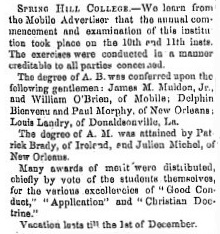
(9393)
Patsy A. D’Eramo (North East, MD, USA) provides two columns with earlier mentions of Paul Morphy at Spring Hill College:

Daily Picayune, 17 October 1851, page 1

Daily Picayune, 17 October 1852, page 3.
(9407)
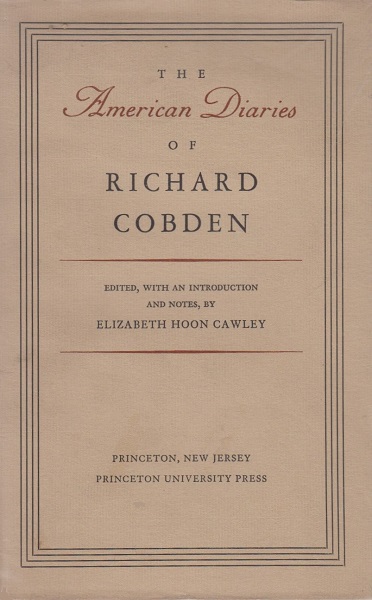
Two pages (201-202) from The American Diaries of Richard Cobden edited by Elizabeth Hoon Cawley (Princeton, 1952):
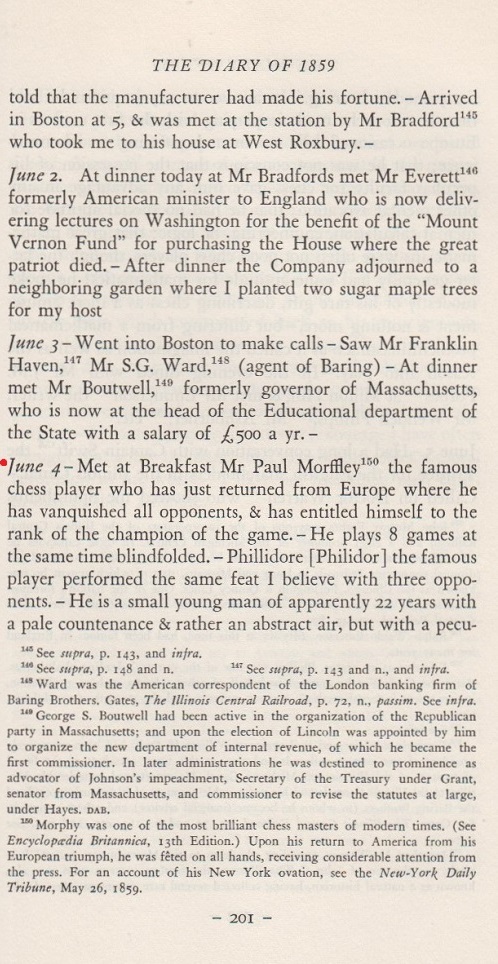
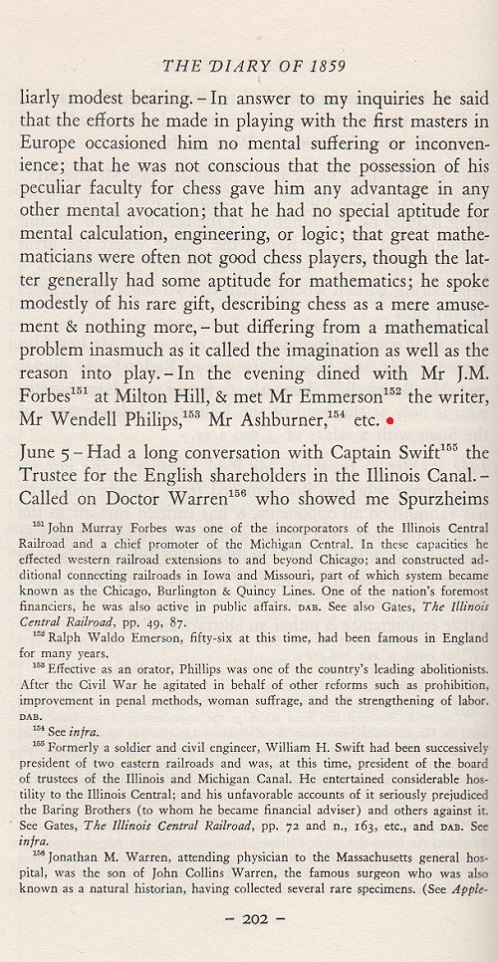
We referred to this material on page 28 of the January 1982 BCM.
(9408)
As shown in Zukertort v Blackburne, London, 1883, page 238 of the August 1963 BCM briefly noted that Edgard Tchélébi had died (aged 34, in fact):

The book referred to, Le secret de Morphy (Limoges, 1960), is scarce, and most writers on the great American master have ignored it, the preference nowadays being for material easily accessible on-line.
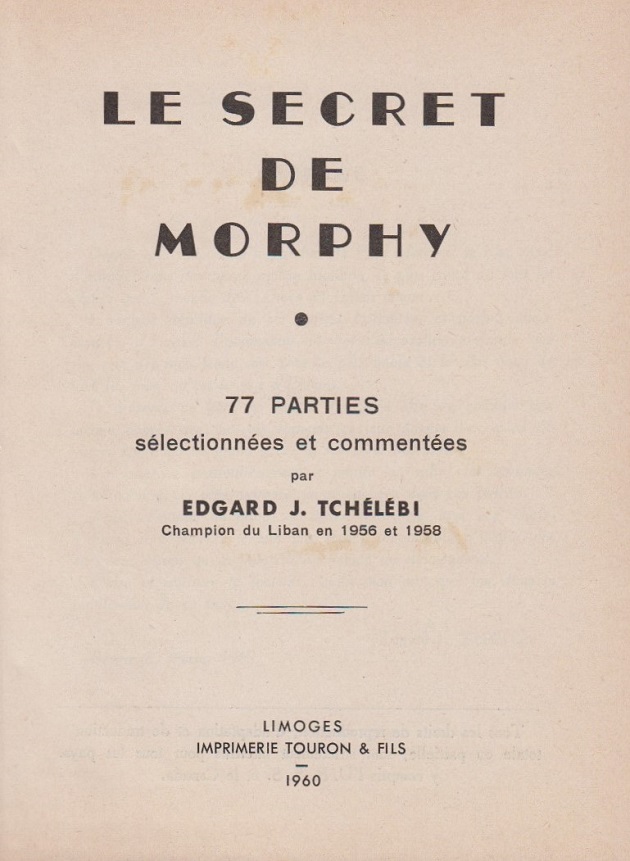
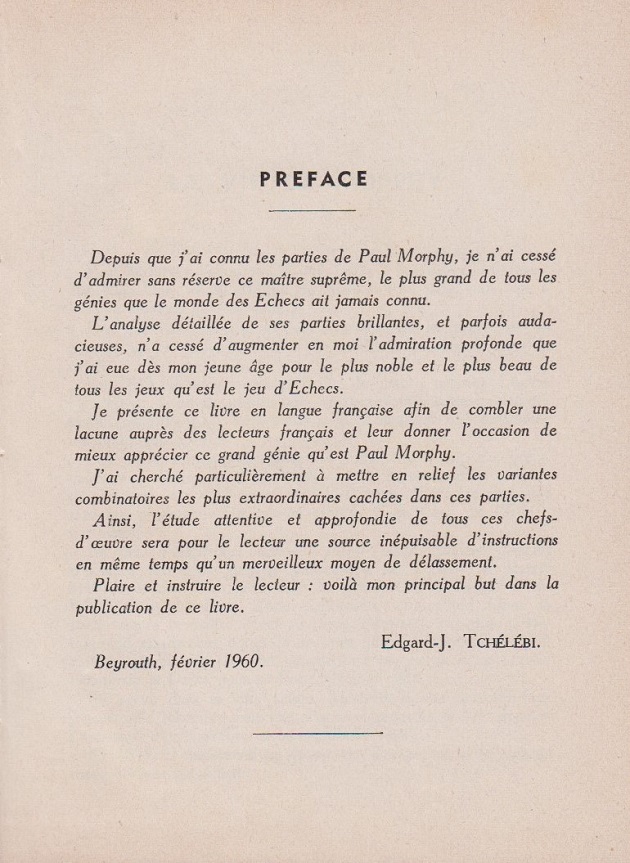
There was nothing austere about the 284-page hardback, and in the introductory matter Tchélébi’s multiple exclamation marks and SUDDEN CAPITALS were an unbecoming way of conveying his unreserved admiration. From page 8:

The Morphy v Anderssen game referred to was on pages 231-235:
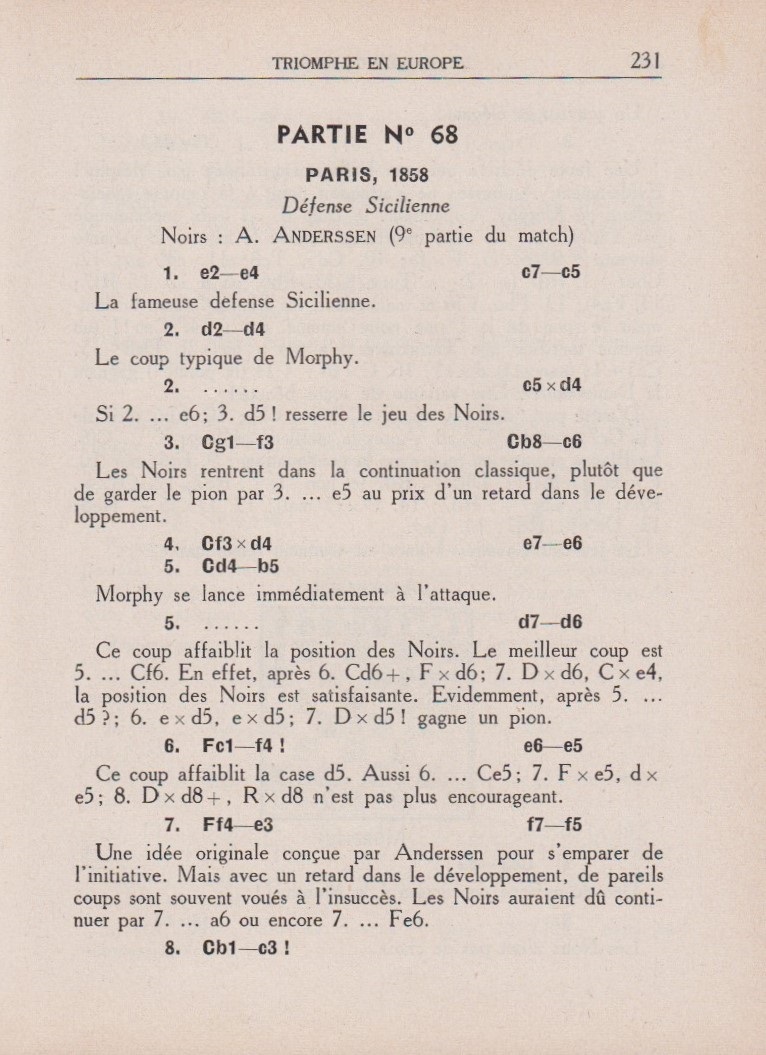
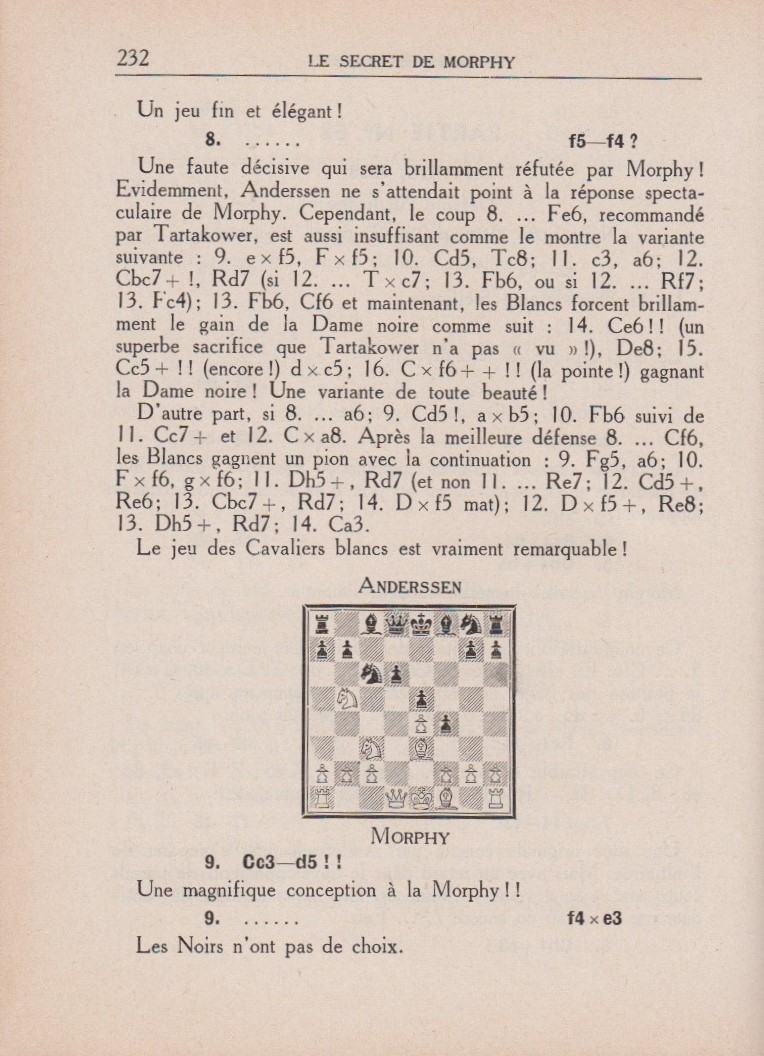
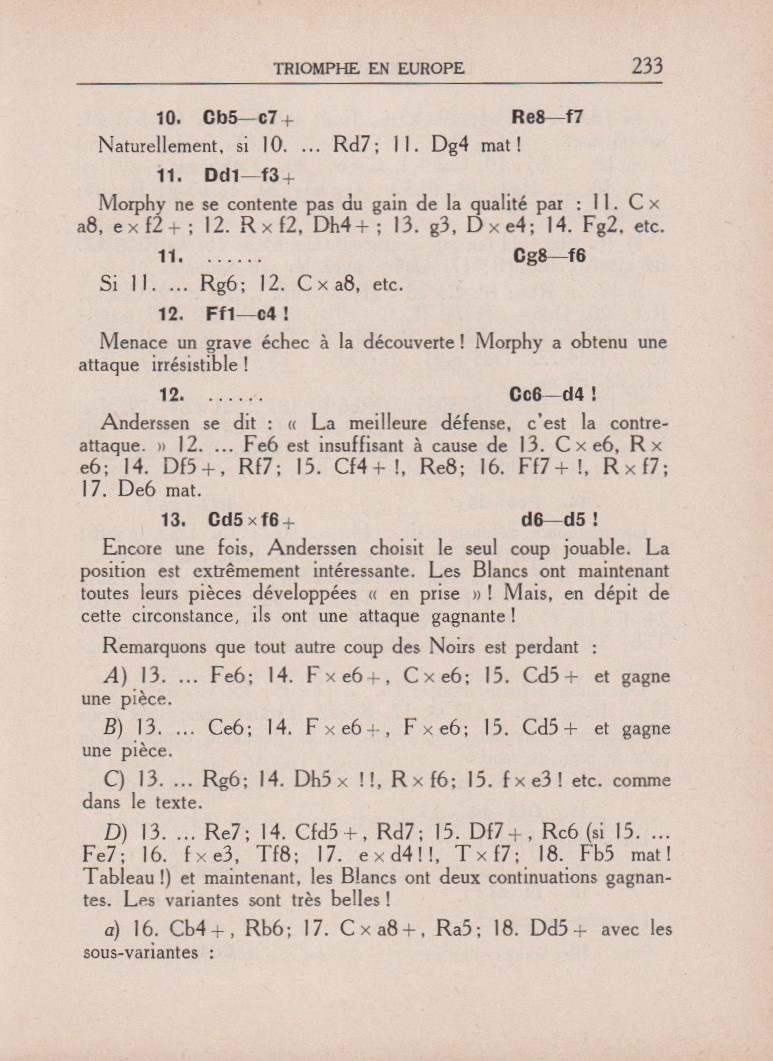
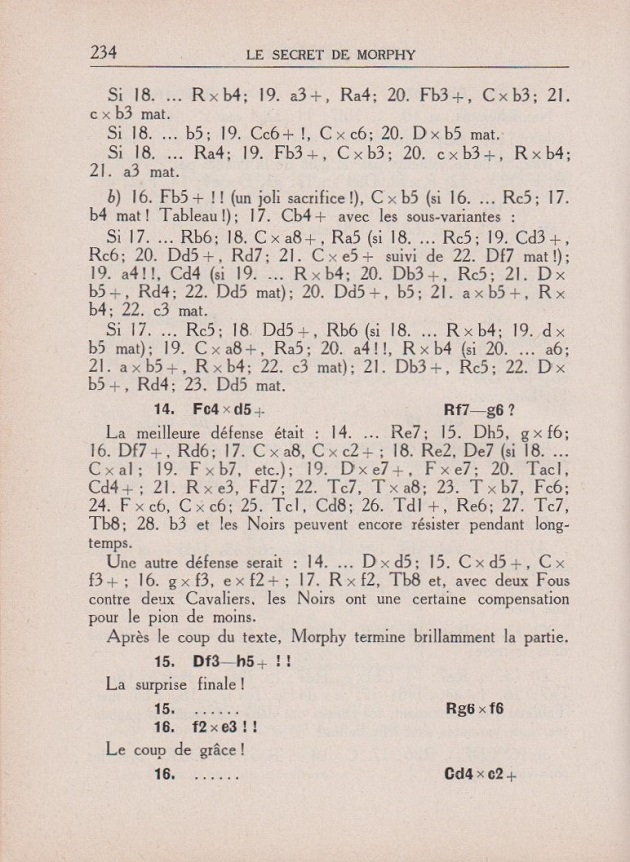
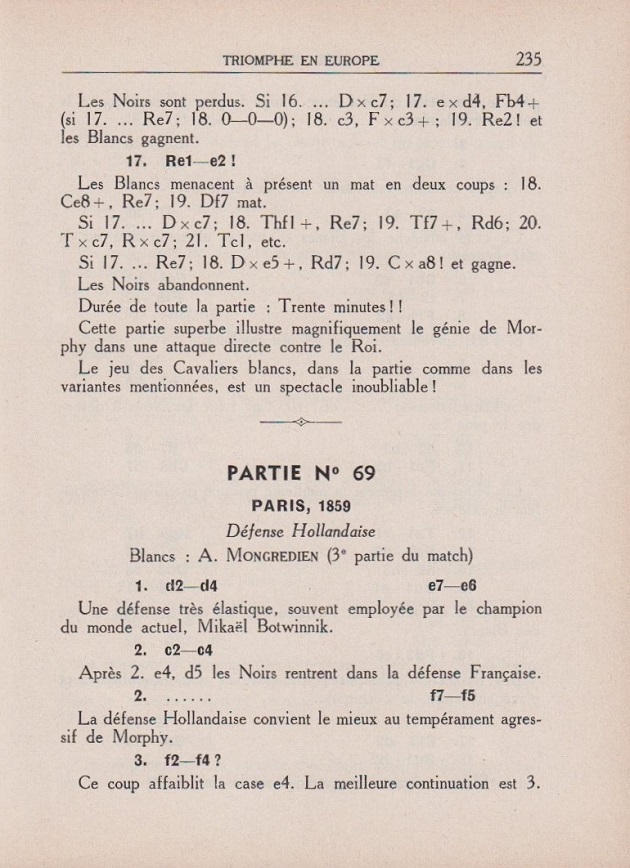
That encounter between Morphy and Anderssen (1 e4 c5 2 d4 cxd4 3 Nf3 Nc6 4 Nxd4 e6 5 Nb5 d6 6 Bf4 e5 7 Be3 f5 8 N1c3 f4 9 Nd5 fxe3 10 Nbc7+ Kf7 11 Qf3+ Nf6 12 Bc4 Nd4 13 Nxf6+ d5 14 Bxd5+ Kg6 15 Qh5+ Kxf6 16 fxe3 Nxc2+ 17 Ke2 Resigns) was one of only two match-games by the American which Steinitz believed could be called brilliant. On page 7 of the January 1885 International Chess Magazine he wrote:
‘On sifting the matter by a sort of statistical research, we were rather amused to find, and probably our readers will be astonished to learn, that out of all of Morphy’s match games with Paulsen, Löwenthal, Harrwitz and Anderssen, nay, even including his matches with “Alter” and Mongrédien, therefore in 56 games altogether, there were only two that can lay claim to being called brilliant, namely the ninth with Anderssen and the fourth with Harrwitz. As regards the former, Morphy leaves a bishop to be taken on the ninth move, for which he might gain a clear rook, coming out with the exchange ahead. He prefers instituting an apparently vehement attack, which might have resulted in an exchange of queens, Morphy remaining only with one pawn ahead, and with two knights against the adverse two bishops, and we do not agree that the game was so absolutely lost for Anderssen as represented by Löwenthal. Winning the exchange was more sure. Doubt has also been thrown by the Chess Monthly on the soundness of the sacrifice, on the ground that on the 14th move Anderssen might have played K-K2, a move which it would have been heresy to think of at that time, because it blocks up queen and bishop, but nowadays any second-class player would give it his first consideration if he has the chance of remaining a piece ahead; knowing that it has been often enough successful even with a pawn behind. However, Anderssen plays K-Kt3, overlooking a very brilliant winding up, of which his ingenious opponent fully avails himself.’
Morphy’s ‘secret’ was explained by Tchélébi on page 11:
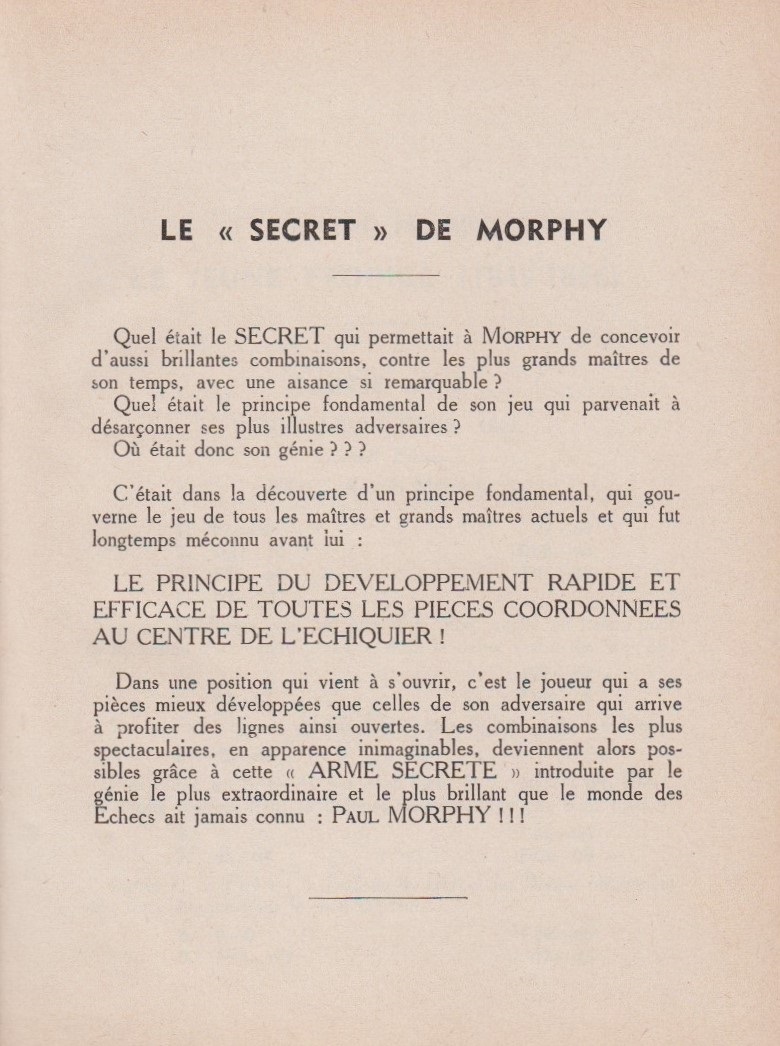
David Hooper sprinkled some vinegar on Tchélébi’s book, and on Morphy, in a short review on page 148 of the May 1963 BCM:
‘Although Steinitz and Lasker, and doubtless others, were in their time as much ahead of their contemporaries as was Morphy, and although they played a greater number of brilliant games and made deeper combinations, many players still regard Morphy as by far the greatest of them all, and his games are published again and again ...
No new light is thrown on Morphy by this book. It contains 11 of the serious games and 66 other games, all chosen for their combinative brilliance. The best of Morphy’s chess is here. The copious if effusive notes are easy to understand ...’
Before concluding ‘it may also be pointed out that Morphy sometimes made unsound sacrifices’, Hooper commented:
‘Before yet another book is written in praise of Morphy it may be pointed out that although he had studied the openings deeply he added nothing significantly new. The much praised 9 Kt-QB3 in the Evans’ Normal Position, and the defence 5...Kt-R3 in the Scotch Gambit after 4 B-QB4 B-B4 5 Kt-Kt5, are both in Staunton’s handbook; as for the Morphy Defence to the Ruy López, 3...P-QR3, he was shown it by Löwenthal.’
(9519)
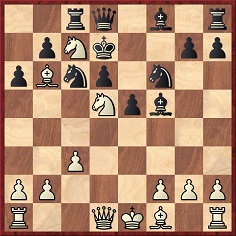
White to move
Regarding this position (a variation given by Tartakower and du Mont), C.N. 9519 showed Edgard Tchélébi’s observation on page 232 of Le secret de Morphy (Limoges, 1960) that White can play 14 Ne6 Qe8 15 Nc5+ dxc5 16 Nxf6+.
We add now that Tchélébi had given similar analysis on page 80 of the February 1955 BCM:
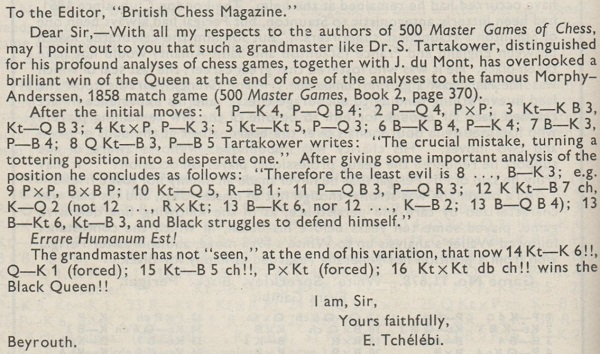
(11016)
Concerning a detailed Morphy page which includes the ‘Statement of Rev. R.R. Harrison’ from pages 4-5 of the Columbia Chess Chronicle, 3 January 1889, the following is to be noted from page 35 of the magazine’s 24 January 1889 issue:
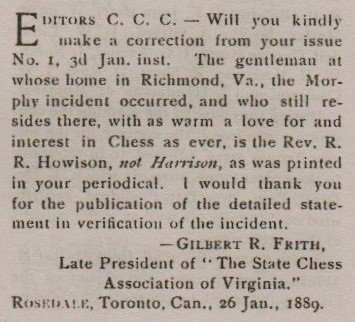
(9734)
Pages 17-20 of the Brooklyn Chess Chronicle, 15 November 1884 published Ai Scacchisti Americani, Una Lagrima Sulla Tomba dell’immortale Scacchista Americano, Paolo Morphy by Giuseppe Liberali:
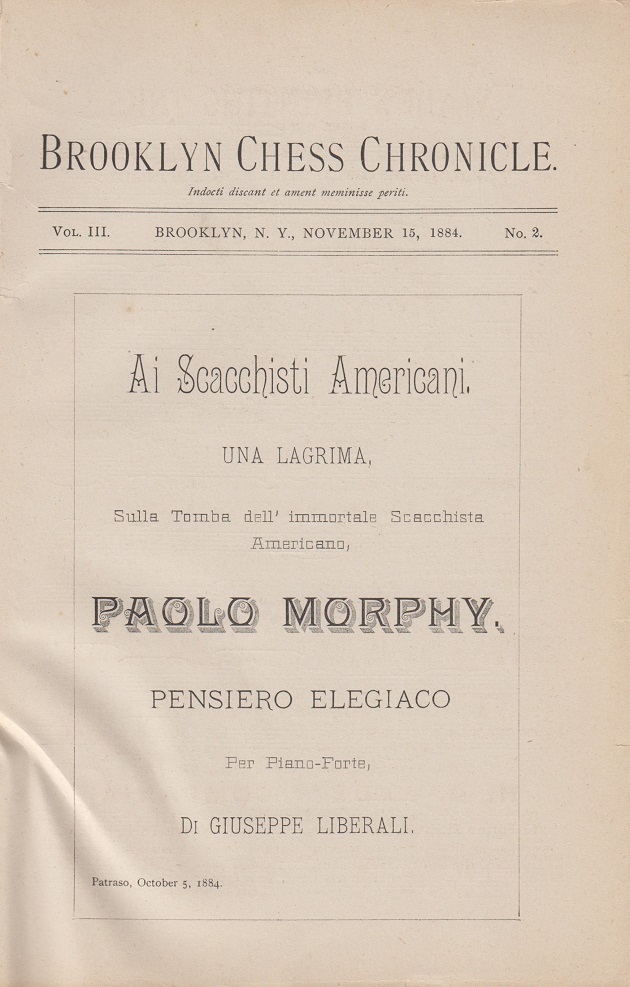
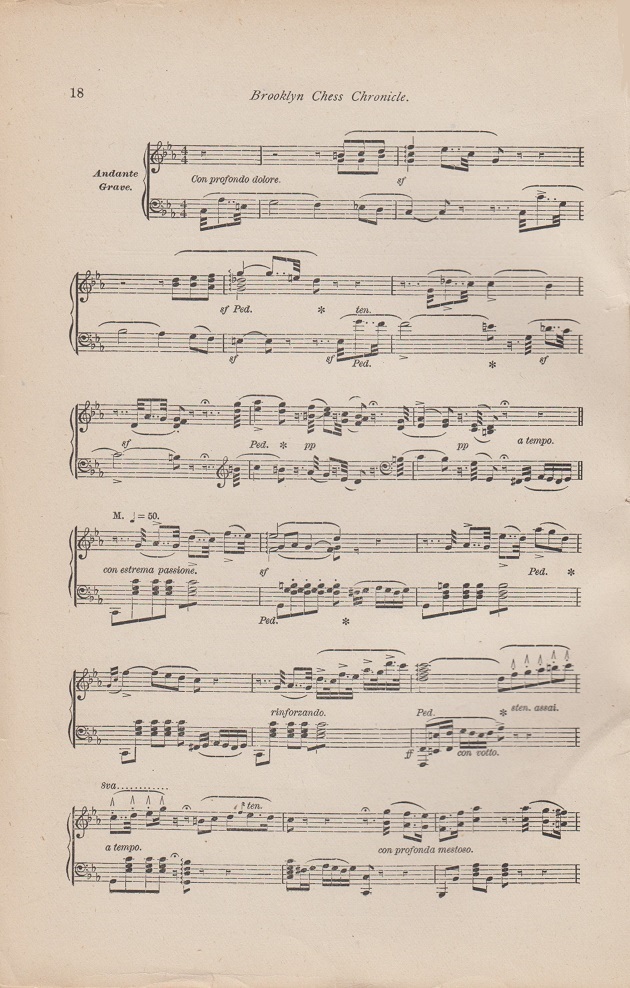
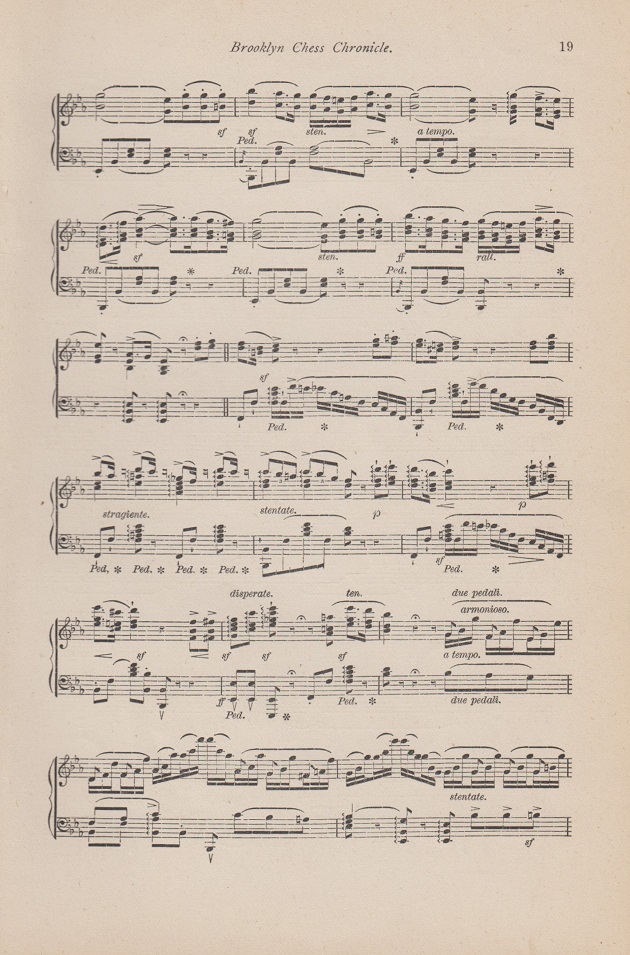
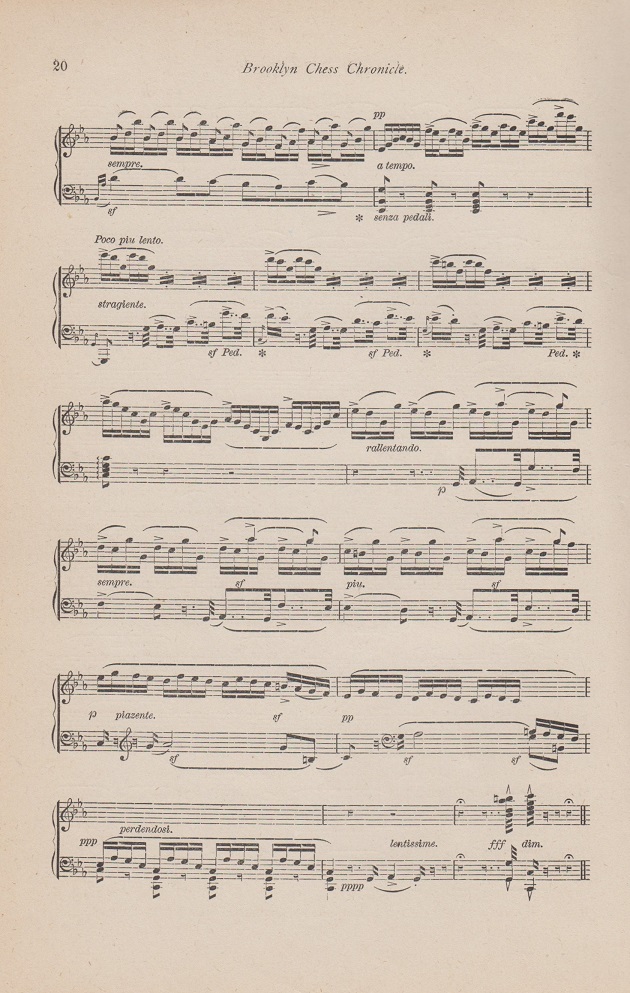
(9988)
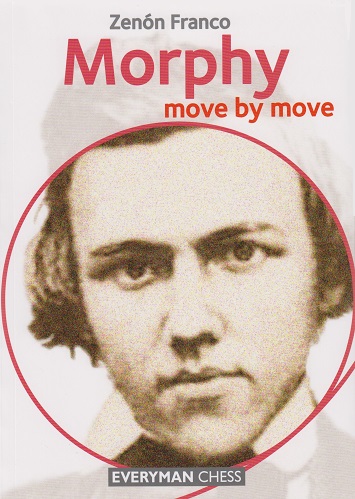
Any author of a book about Morphy has to decide how many of the dozens of monographs on him published since the late 1850s will be duly scrutinized and acknowledged in the bibliography.
Below is page 5 of Morphy move by move by Zenón Franco (London, 2016):
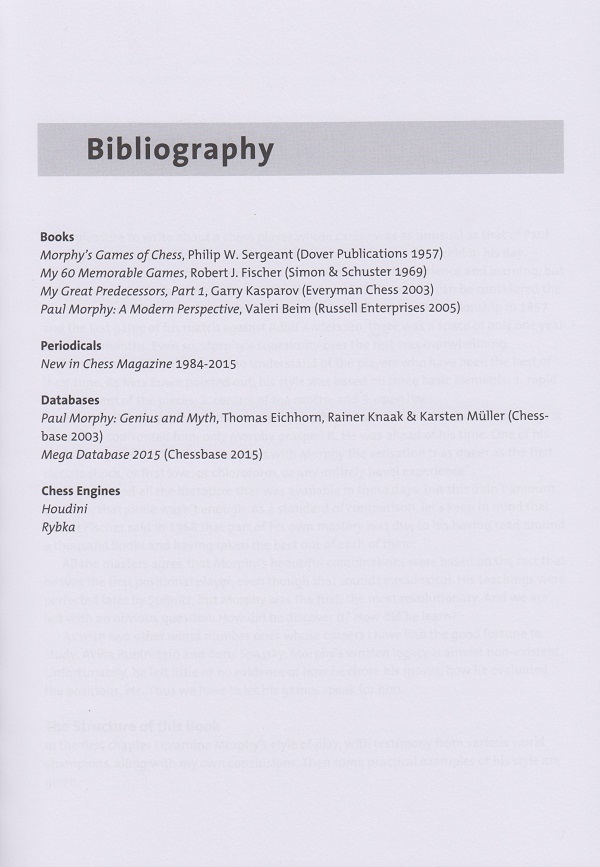
(10133)
Han Bükülmez (Ecublens, Switzerland) asks for information about a Morphy gamelet against A. Bottin (Paris, 1858): 1 e4 e5 2 c3 Nf6 3 d4 Nxe4 4 dxe5 Bc5 5 Qg4 Nxf2 6 Qxg7 Rf8 7 Bg5 f6 8 exf6 Rxf6 9 Bxf6 Be7 10 Qg8+ Resigns. Our correspondent adds that a longer score is also readily found, comprising post-game analysis said to have involved Morphy.
There are brief accounts in the Morphy collections by G. Maróczy and P.W. Sergeant, but the most extensive coverage of the game that we recall is on pages 224-225 of Paul Morphy Sein Leben und Schaffen by Max Lange (Leipzig, 1894):
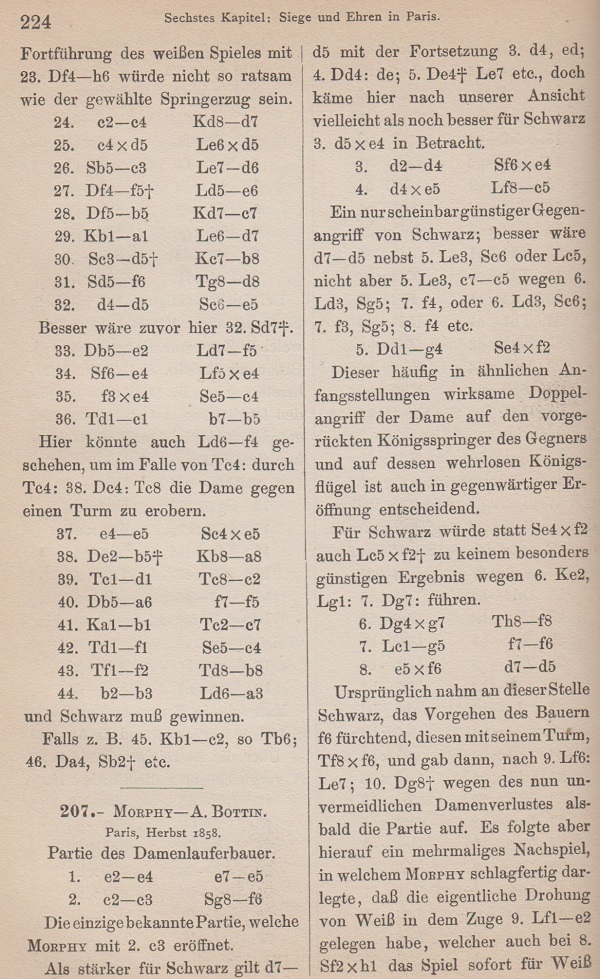
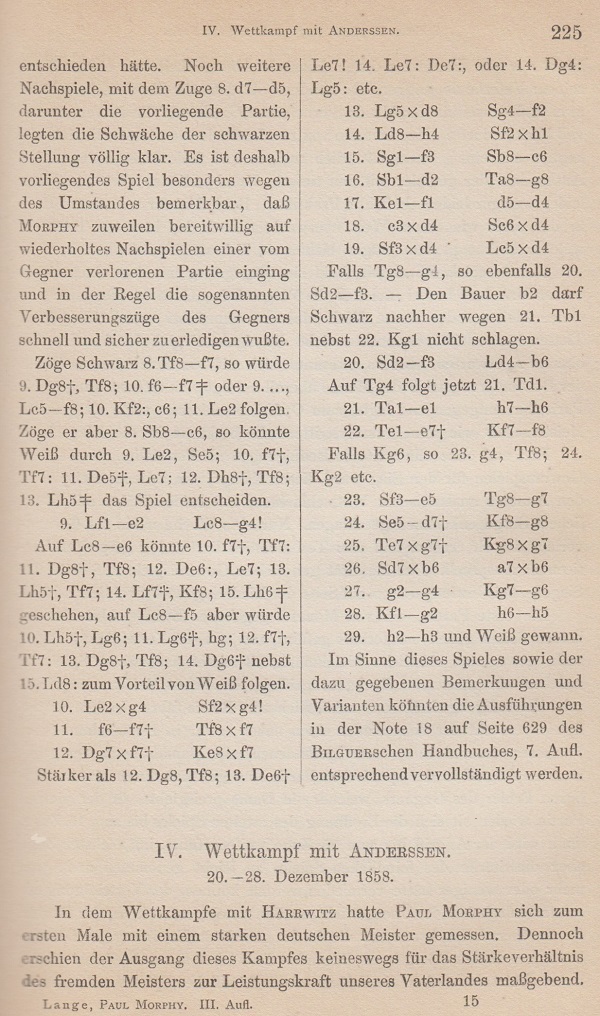
What more can be discovered about Morphy v Bottin?
(10143)
A question in C.N.s 6424 and 6496 concerned the largest number of opponents faced by Morphy in simultaneous exhibitions. The figures are relatively small, but can the matter be put beyond doubt?
One claim concerning Morphy (in the period after his match with Anderssen) is quoted below without comment:
‘He confined himself to simultaneous displays, playing 20, 30 and even 40 people at once ...’
Source: page 274 of Keene On Chess by R. Keene (New York, 1999). The identical wording re-appeared on page 275 of Complete Book of Beginning Chess by R. Keene (New York, 2003).
(10423)
See also C.N.s 11939 and 11992, as well as the following:
Jerry Spinrad (Nashville, TN, USA) informs us that the only simultaneous display by Staunton which he has seen mentioned in the Chess Player’s Chronicle is a very small one at the Rock Ferry Chess Club (July 1853 issue, pages 217-218):
‘A special Meeting of this Society was held on the evening of the 5th ult. at the Club Rooms, Rock Ferry Hotel, for the purpose of welcoming to Cheshire Mr Staunton, who, during his short visit, was the guest of Mr Morecroft, of the Manor House ... In the course of the evening there was some very interesting play. Mr Staunton conducted simultaneously two games against the Liverpool gentlemen, in consultation at one board, giving them the odds of pawn and two moves, and against the Rock Ferry gentlemen, at another board, giving them the odds of the knight.’
After supper and speeches the games were resumed, but the report did not specify the outcome.
On Morphy, Jerry Spinrad and John Townsend refer to a simultaneous display which is well known. Mr Townsend writes:
‘David Lawson, in Paul Morphy, the Pride and Sorrow of Chess (new edition by Thomas Aiello, 2010), quoted (on pages 213-214) from an account of a simultaneous exhibition which took place at the St James’s Chess Club in London on 26 April 1859, the source being the Illustrated News of the World, of “the following Saturday”:
“A highly interesting assembly met in the splendid saloon of St James’s Hall, on Tuesday evening last [26 April], when Mr Morphy encountered five of the best players in the metropolis.”
The opposition was formidable:
“The first table was occupied by M. de Rivière; the second, by Mr Boden; the third, by Mr Barnes; the fourth, by Mr Bird; and the fifth, by Mr Löwenthal. Mr Morphy played all these gentlemen simultaneously, walking from board to board, and making his replies with extraordinary rapidity and decision. Although we believe that this is the first performance of the kind by Mr Morphy, it is a remarkable fact that he lost but one game. Two other games were won by him and two were drawn.”’
Those reports, one display apiece by Staunton and Morphy, are all that can currently be cited here, although the following may be recalled from C.N. 10423 (concerning Morphy after his match with Anderssen):
‘He confined himself to simultaneous displays, playing 20, 30 and even 40 people at once ...’
Source: page 274 of Keene On Chess by R. Keene (New York, 1999). The identical wording was on page 275 of Complete Book of Beginning Chess by R. Keene (New York, 2003).
(11196)
From a column by Fred Reinfeld (Chess Review, March 1952, page 77):
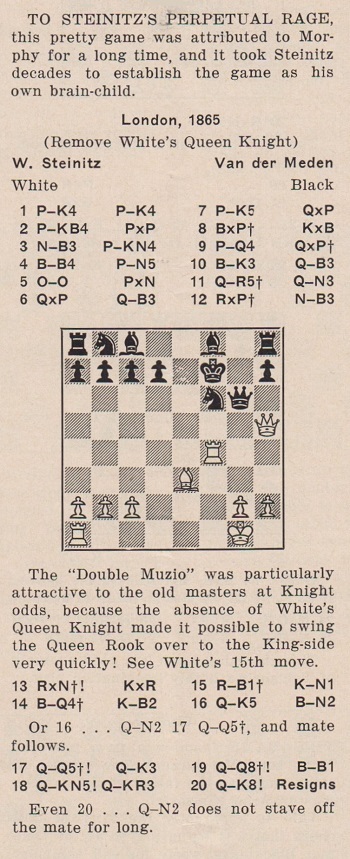
Reinfeld appeared unaware that, less than a decade earlier, a very similar game had been played by Morphy. Nothing has been found to justify the assertion that Steinitz was in a ‘perpetual rage’ with regard to his Muzio Gambit game.
Establishing the basic facts about either game is not easy. For example, the name of Steinitz’s opponent appears inconsistently in chess literature. Reinfeld also named him as ‘van der Meden’ on pages 40-42 of Great Moments in Chess (New York, 1963), which had this introduction: ‘Games like the following one show how Steinitz acquired the nickname of “the Austrian Morphy”.’ Chernev’s 1000 Best Short Games of Chess (pages 341-342) called him ‘Meden’. Pages 97-98 of the first volume of Bachmann’s monograph on Steinitz had ‘Van der Meelen’ and offered an occasion: the London Club, 10 December 1865. However, that is the exact date when the game was published, with Black unidentified, in the Era (page 4):
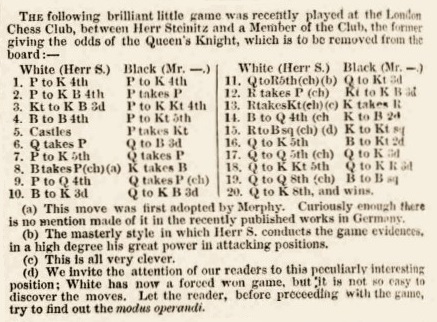
The similar game by Morphy referred to above was on page 206 of the July 1858 Chess Monthly:
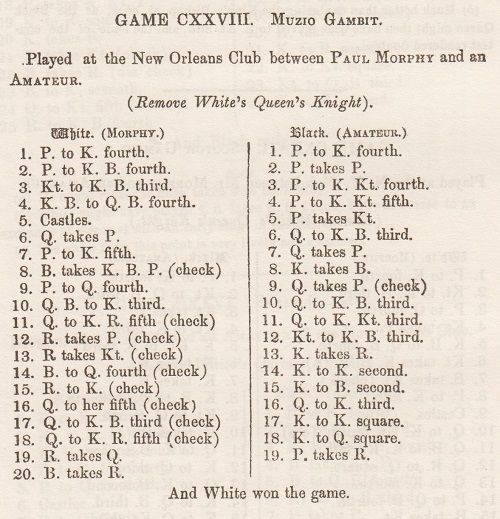
The venue specified above is the New Orleans Chess Club, but a number of Morphy anthologies place the game in New York (with the date 1857).
Both games were discussed by Steinitz in a series of ‘Personal and General’ articles in the International Chess Magazine, May, June, July and August 1885. On pages 210-211 of the July 1885 issue, Steinitz stressed his familiarity with the Morphy game, noting its publication in the Chess Monthly. See too pages 71-80 of The Steinitz Papers by Kurt Landsberger (Jefferson, 2002).
Writing before clarification of the exact year of his game had been provided, Steinitz stated on page 143 of the May 1885 International Chess Magazine:
‘I played the game, a Muzio Gambit at the odds of a Kt, at the old London Chess Club, against Herr van der Meden, then Belgian Consul in London, in the year 1866 at the very latest.’
On page 14 of The Transactions of the British Chess Association for the Years 1866 and 1867 by J. Löwenthal and G.W. Medley (London, 1868) a list of subscribers included ‘Von der Meden, O.’.
(10464)
In the final round of the New York, 1857 tournament, Morphy defeated Louis Paulsen +5 –1 =2. According to the Lange, Maróczy and Sergeant monographs on Morphy, the dates of the eight games were as follows: First: 29 October; Second: 30 October; Third: 2 November; Fourth: 4 November; Fifth: 6 November; Sixth: 8 November; Seventh: 8 November; Eighth: 10 November.
Hans Renette (Bierbeek, Belgium) writes:
‘My particular interest is in the dates of the concluding games between Morphy and Paulsen. The New York, 1857 tournament book is rather vague and not altogether trustworthy. On page 68 of Paul Morphy The Pride and Sorrow of Chess (New York, 1976) David Lawson stated that the sixth game was played on 3 November, and page 71 gave 6 November and 10 November as the respective dates of the seventh and eighth games. There was no explanation for the gaps in the schedule.
The New Orleans Daily Picayune of 13 November contains a quote from the New York Courier and Enquirer of 6 November which reported that the final game had been played on 5 November:
‘The chess congress was virtually brought to a close last evening by Paul Morphy winning the decisive game, the fifth, from Mr Paulsen [the eighth game is meant, i.e. Morphy’s fifth victory – H.R.]. Mr Paulsen was suffering from a severe catarrh yesterday, and might with great propriety have requested a postponement of the contest; but he fought gallantly and yielded gracefully.”
The New York Times reported on 7 November:
“At the chess congress Mr Morphy has won five games in the last section of the Grand Tournay, entitling him to the first prize.”
Which newspapers of the time allow the games to be dated precisely, beyond all doubt?’
(10754)
Steve Guardiano (Daytona Beach, FL, USA) owns this trophy:
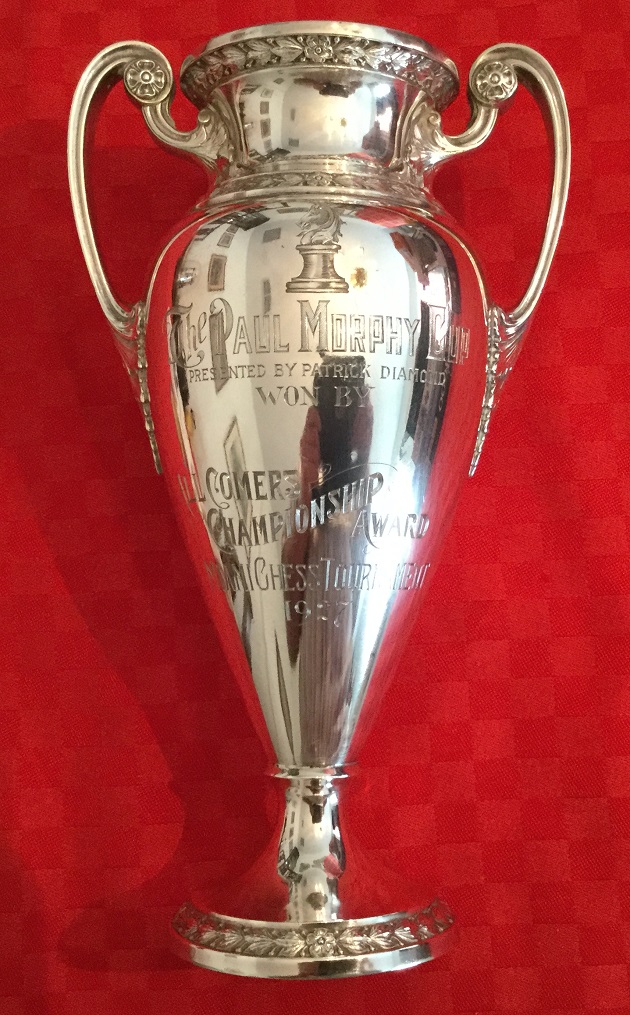
He writes:
‘It is engraved with the image of a knight and with this text:
“The Paul Morphy Cup
Presented by Patrick Diamond
won by
[blank]
All Comers Championship Award
Miami Chess Tournament
1927.”‘Made by the Gorham Company, it is approximately nine inches (23 cm) tall and bears the Gorham mark, as well as the marks “Sterling” (indicating the silver purity of .925), “A10068” and “1⅜ pint”:’

We can add a report from page 16 of the Society section of the Miami News, 27 March 1927:
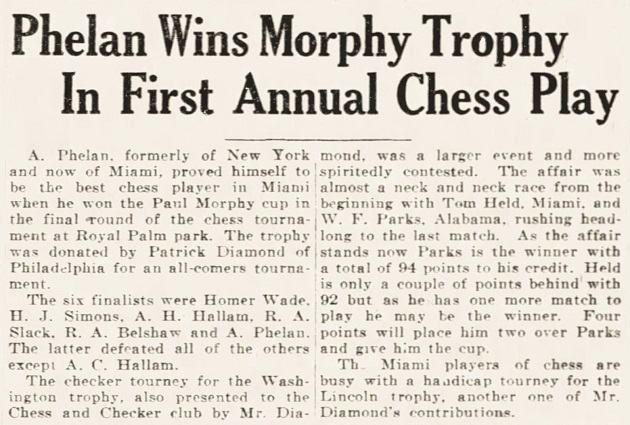
(10821)
C.N. 10816 referred to two brilliant combinations by James Mason, yet the following may be noted from page 25 of the Chess Weekly, 27 June 1908:
‘... a combination at chess should be adroit and witty, rather than lingering and exact. As a case in point, the play of Paul Morphy, who before all things was a combination player, may very well be contrasted with the siege-like style of James Mason, who rejoiced in the sombre, slow-marching sort of game which, even in the playing over, takes half an hour to pass a given point. Morphy made epigrams on the chess board; Mason expressed himself at considerable length.’
(10849)
From page 11 of Masters of the Chess Board by Richard Réti (London, 1933):
‘His contemporaries reproached Morphy with a certain dryness, a criticism which has been levelled against every world’s champion before and after him.’
The original text, on page 29 of Die Meister des Schachbretts (Mährisch-Ostrau, 1930):
‘Von seinen Zeitgenossen wurde Morphy, gleich allen anderen Weltmeistern vor und nach ihm, Trockenheit vorgeworfen.’
Wanted: examples of Morphy being accused of dryness by his contemporaries.
(11225)
First, two extracts from The Human Side of Chess by Fred Reinfeld (London, 1953):
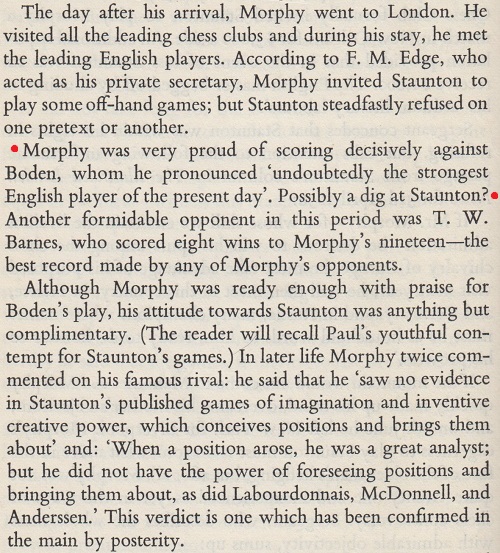
Page 64
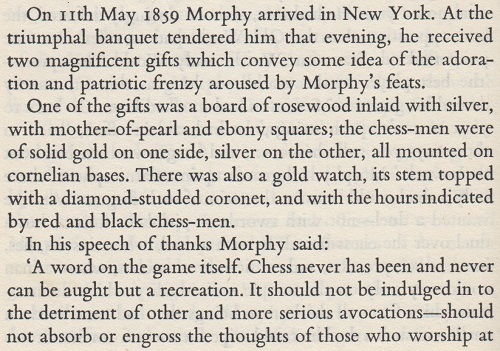
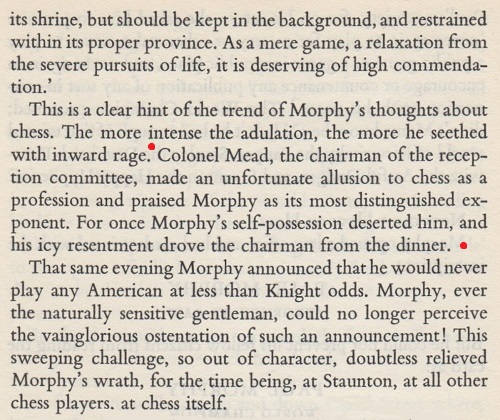
Pages 72-73
From a review of Reinfeld’s book on page 3 of CHESS, October 1953:
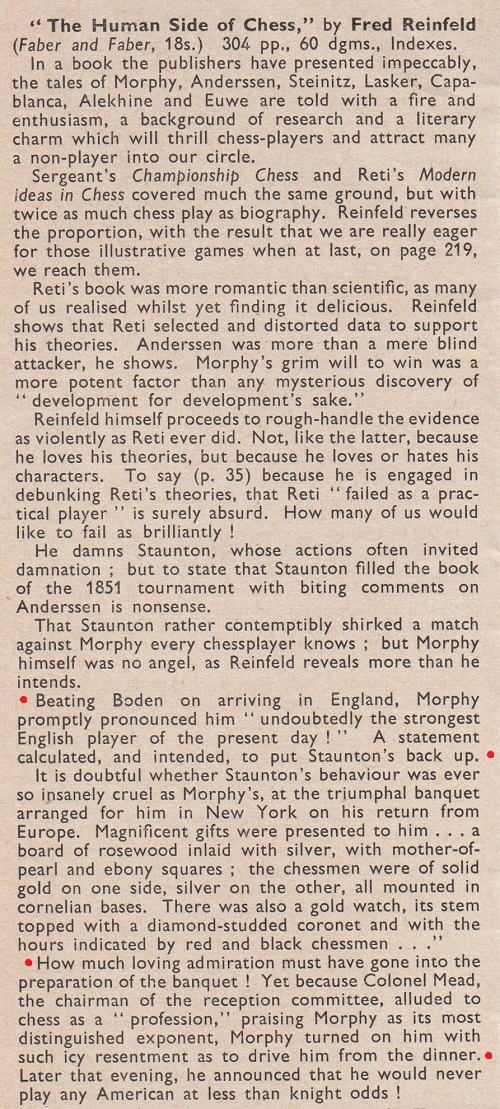
The specific remark by Morphy about Boden being ‘undoubtedly the strongest English player of the present day’ was not made ‘promptly’ by Morphy after his arrival in England in June 1858. He wrote it in his New York Ledger column of 31 March 1860 in notes to a McDonnell v Labourdonnais game (which had begun 1 e4 e5 2 Bc4 Nf6 3 d4):
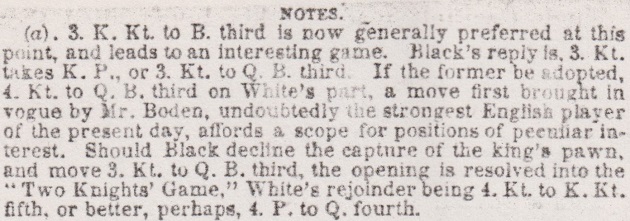
Also concerning Boden, below is a comment by F.M. Edge on page 73 of his book on Morphy (New York, 1859):
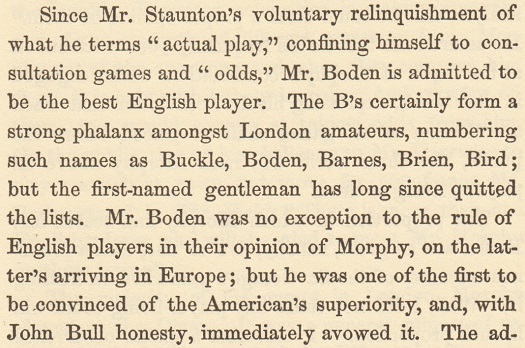
The entire 1859 banquet story involving Colonel Mead was dismissed by David Lawson on pages 213-214 of his 1976 monograph on Morphy: ‘No such incident occurred.’ On page 174 Lawson commented regarding The Human Side of Chess: ‘Reinfeld is frequently in error in his facts and assessments.’
(11265)
C.N. 11265 showed that unjustified interpretations about Paul Morphy’s conduct were made by Reinfeld and by CHESS in ignorance of the facts. Concerning the Colonel Mead yarn, we now reproduce the relevant pages of Paul Morphy. His Later Life by C.A. Buck (Newport, 1902):
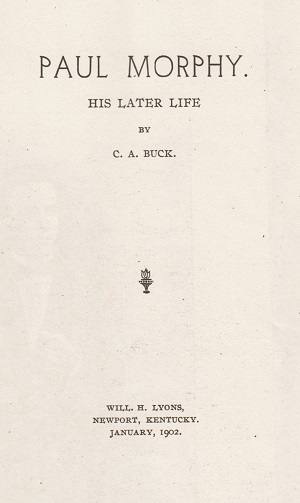
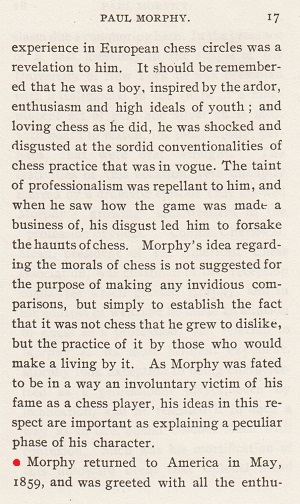
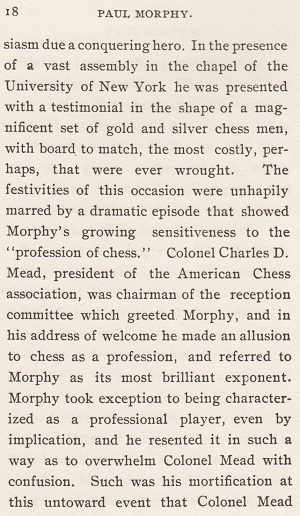
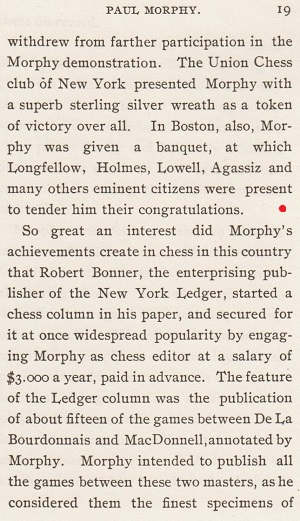
Below is the repudiation of Buck’s claim on pages 213-214 of Paul Morphy The Pride and Sorrow of Chess by David Lawson:
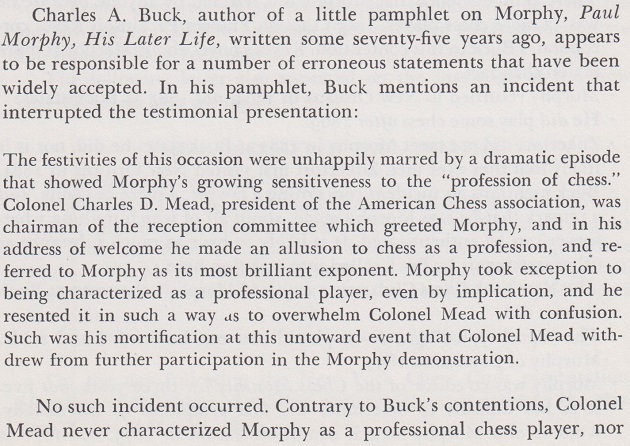
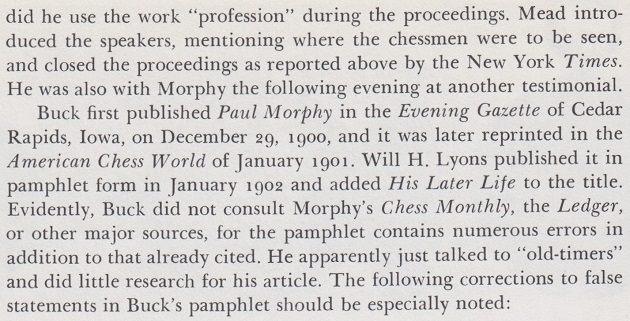
In bullet-point form on pages 214-215 Lawson then listed 16 corrections to Buck’s booklet, the final one being:

The episode illustrates how chess history has often been distorted, with false inferences drawn. The unsubstantiated claims by Buck were repeated by Reinfeld without dissent or attribution. Although the CHESS review of The Human Side of Chess criticized Reinfeld in general terms for rough-handling evidence, it accepted unquestioningly what Reinfeld had written about Colonel Mead. Solely on that basis, CHESS denounced Morphy for conduct that was ‘insanely cruel’.
(11270)
From Chess Records:
David Lawson (né Charles Whipple, 1886-1980) was aged 89 when his book Paul Morphy The Pride and Sorrow of Chess (New York, 1976) was published. (C.N. 287; pages 108 and 262 of Chess Explorations.)
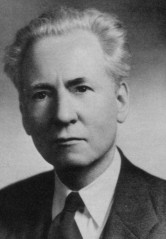
David Lawson
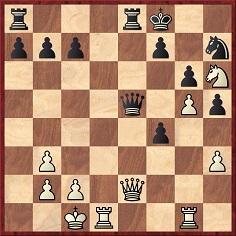
White to move
Leaving his queen en prise, White threatened mate with 26 Rd7. The possible rejoinder 26...Nxg5 has received much attention, but the present item focuses on the issue of due attribution of analysis rather than the analysis itself.
The position arose in Morphy’s well-known victory over T. Lichtenhein in the 1857 New York tournament. Working backwards, we begin with page 48 of the 1994 book Magic Morphy by C. Abravanel and P. Clère, which attributed the critical line, beginning 26...Nxg5 27 Rxg5 Qf6, to P.W. Sergeant:

Another example comes from pages 8-9 of the 1922 edition of Half-Hours with Morphy by E.E. Cunnington:
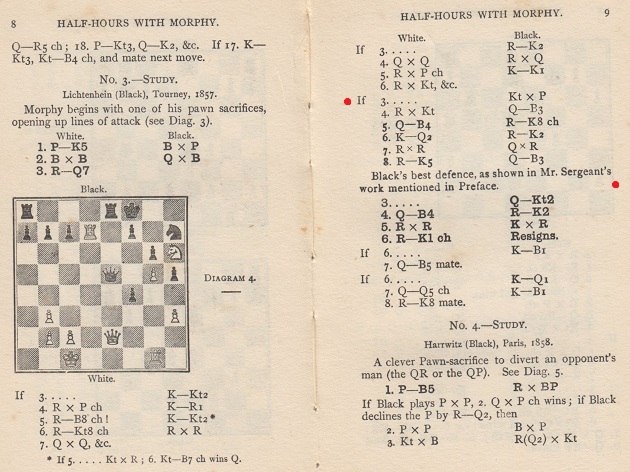
From page 47 of Sergeant’s 1916 monograph on Morphy:
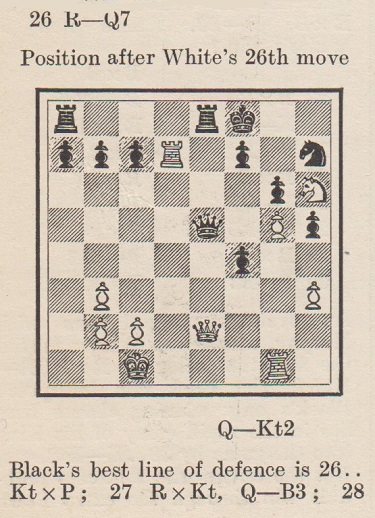
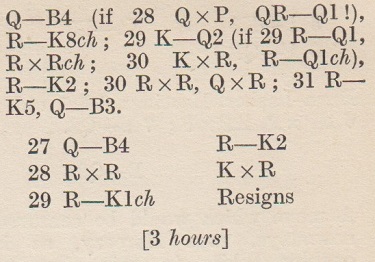
However, when that line was given by Reinfeld on page 13 of the January 1955 Chess Review it was credited to Maróczy:
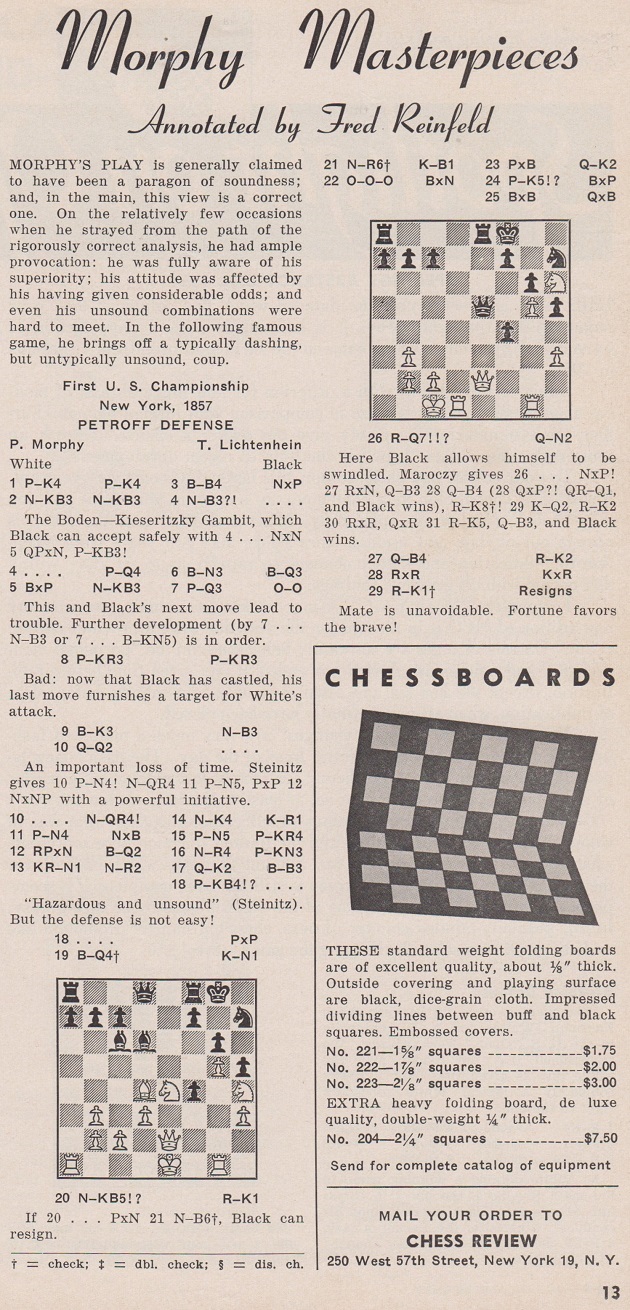
See also pages 59-60 of the 1974 Reinfeld/Soltis book Morphy Chess Masterpieces, which stated that 26 Rd7 (‘!’) ‘loses against inspired defense’ but that Lichtenhein missed ‘the beautiful defense pointed out by Maróczy, the great Hungarian player and analyst’.
Below is Maróczy’s note in his 1909/1925 book on Morphy (pages 35-36 and 23 respectively):
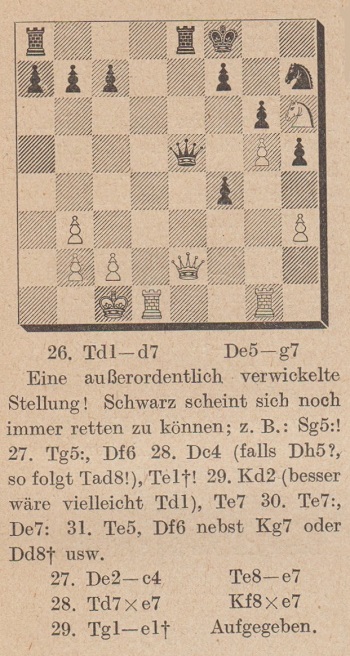
From page 49 of the third edition (1894) of Paul Morphy. Sein Leben und Schaffen by Max Lange:
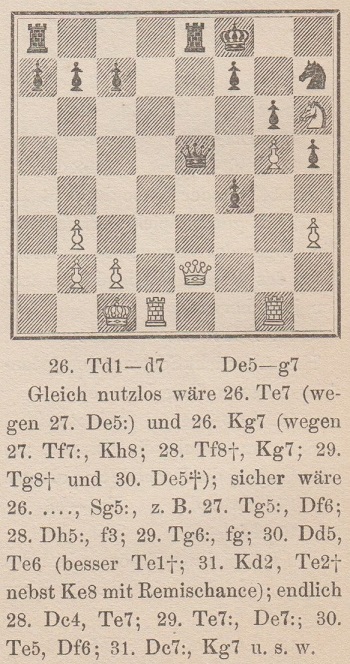
The game was discussed on pages 132 and 3 of Steinitz’s 1889 book The Modern Chess Instructor, with these notes regarding 26 Rd7 and 26...Qg7:

The reference to Löwenthal concerns pages 335-336 of his 1860 monograph on Morphy:
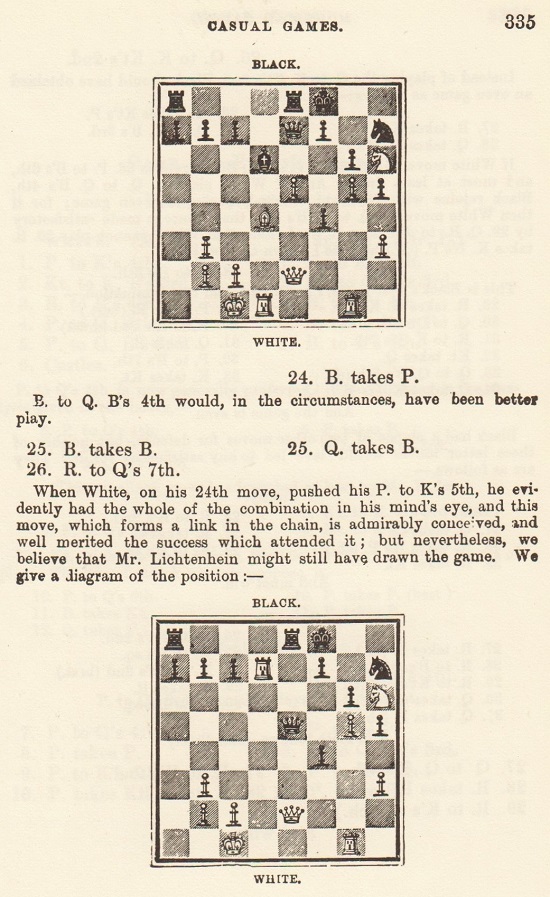
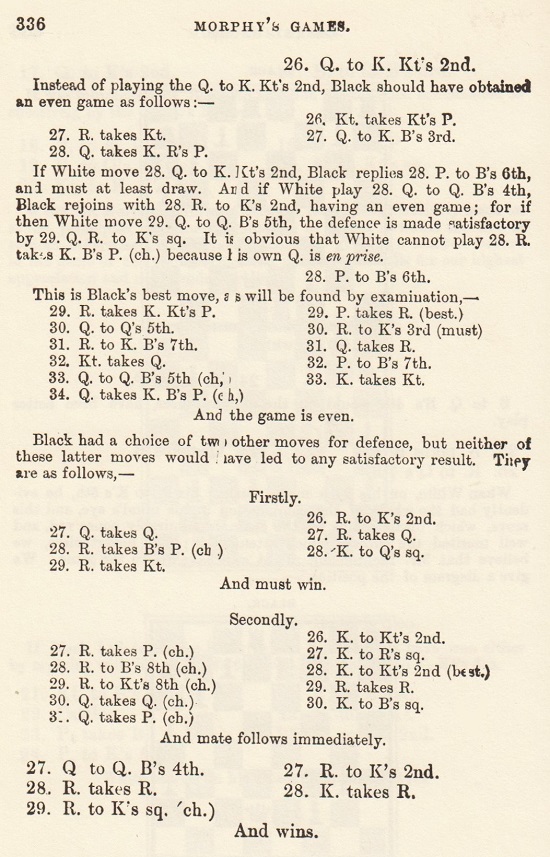
Two earlier publications of the game:
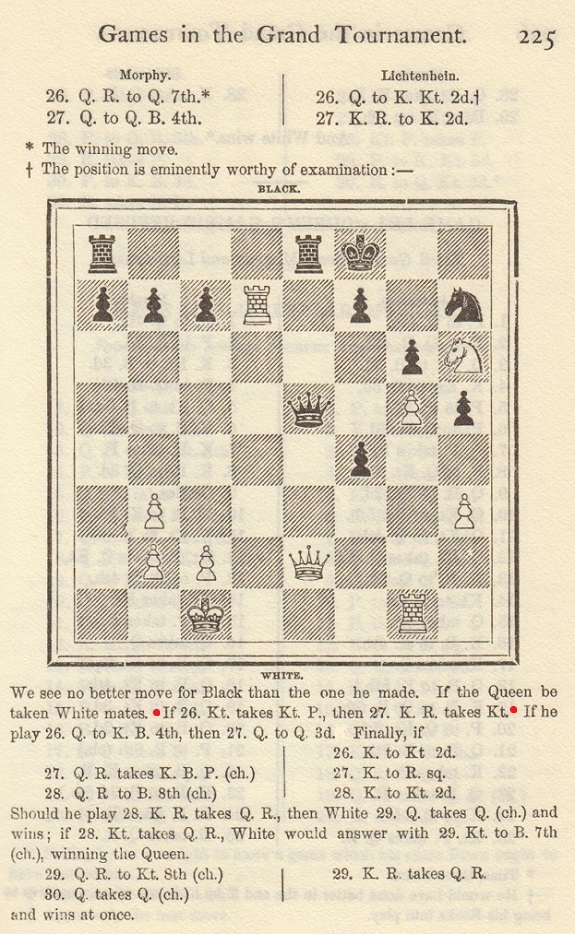
New York, 1857 tournament book (1859), page 225
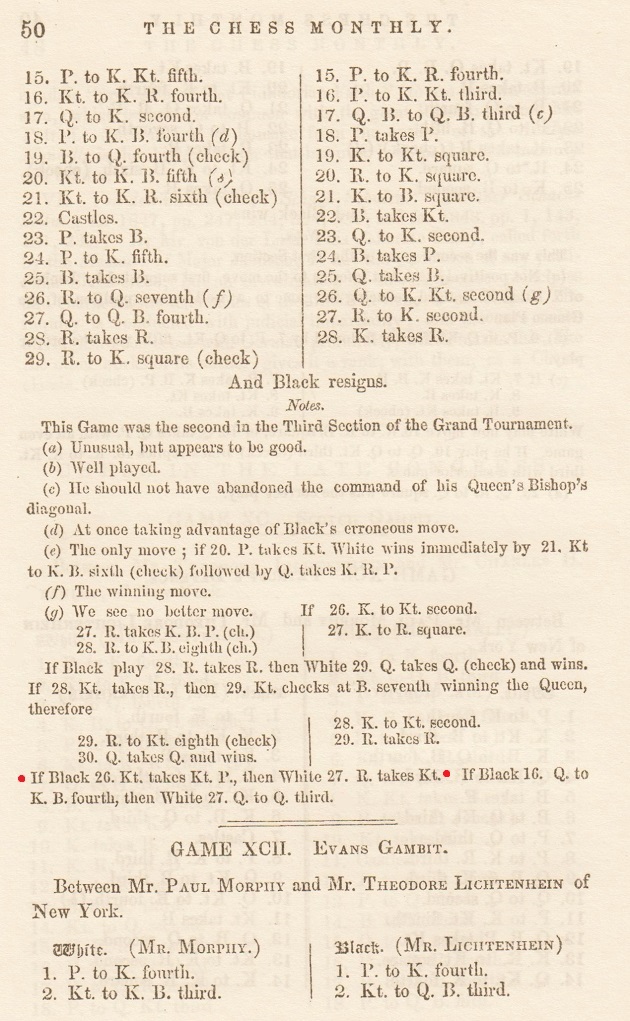
Chess Monthly, February 1858, page 50
See too page 45 of the 1995 work Tízezer Lépés Morphyval by C. Gerencsér. The latest detailed analysis of the game appears to be in Morphy move by move by Z. Franco (2016). The note after 26...Qg7 (‘?’) on page 89 is 16 lines long but mentions no prior annotators. That hardly seems right, but the game illustrates the difficulty of deciding how moves, lines and ideas can best be credited to analytical predecessors. The matter was addressed by Sergeant in the Preface to his Morphy games collection (page v):
‘In the annotation of the games I have made full use of all the recognized authorities in my possession or within my reach, including the books of Löwenthal, Lange and Maróczy, and the scattered criticisms of Zukertort, Steinitz, Lasker, etc. Where I have been able to trace the original source of an important note, I have usually acknowledged it; but the habit of so many analysts of borrowing without acknowledgement makes it impossible to do this in many cases.’
(11485)
Addition on 4 December 2022:
John Townsend writes:
‘In your feature article on Paul Morphy, you raise the matter of the absence of a source for David Lawson’s brief remarks about Morphy’s death and point out that they relied heavily on the account which appeared in the New Orleans paper the Times-Democrat (11 July 1884).
Lawson’s version contained details which appeared in other newspapers, i.e. that Morphy died from congestion of the brain brought on by entering the cold water while very warm after his walk. Lawson also mentioned that he was found with his head resting on the side of the bath tub, to which his hands were clinging.
Several US newspapers (viewable on-line on Chronicling America) carried a different version of the circumstances; these omitted to mention congestion or his warm body temperature and the cold water, but instead attributed his death to drowning, noting that he was found face down in the water.
For example, the Mineral Argus (24 July 1884, page 1) included the following:
“New Orleans Special 10th: Paul Morphy, the world-renowned chess player, was this evening found dead in a bath tub at his residence. He had been taking his daily bath, and it is supposed was seized with a fit, for when his family, alarmed at his long stay, entered his room, he was found face down in the water dead. He had been drowned.”
Very similar or identical reports appeared in The De Smet Leader (19 July 1884, page 1), The Warner Weekly Sun (18 July 1884, page 1), The Northern Pacific Farmer (17 July 1884, page 1), The River Falls Journal (Wisconsin) (17 July 1884, page 1), and The Sun (Minnesota) (17 July 1884, page 1). The Weekly Expositor (Michigan) (17 July 1884, page 1) also reported: “It is supposed he was seized with a fit and drowned.”’
Addition on 26 December 2022:
From Ross Jackson:
‘It is misguided to assume answers in contemporary reports or understandings of medicine. I noted a similar error in reportage that distress from his divorce killed Capablanca. We can accept that Morphy died in his bath and that it is impossible for an able conscious adult to drown in a bath. Beyond that, whether by heart attack, cardiac arrest secondary to aortic or cerebral aneurysm, stroke, shock (potentially anaphylactic, diabetic or steroid), epileptic seizure or some other medical emergency, it would require an autopsy to modern standards to determine cause of death. Except for epilepsy (where there would be a history of seizures) whether Paul Morphy’s head ends up above water or below water, or whether there is a temperature change for getting into his bath, are of irrelevance as primary cause of death.
In regard to “cerebral congestion” there is now no such condition. The Journal of the American Medical Association links to an article in the journal Archives of Neurology:
“Cerebral Congestion
A Vanished Disease
Gustavo C. Román, MD, FACP
Author Affiliations
Arch Neurol. 1987;44(4):444-448. doi:10.1001/archneur.1987.00520160074018Abstract:
The concept of ‘cerebral congestion’ as a cause of apoplexy was first proposed by Morgagni in 1761, and had a profound influence in the treatment of stroke during the next 150 years. It accounted not only for cerebral hemorrhage, but also for lacunes (Dechambre, 1838), état criblé (Durand-Fardel, 1842), depression, maniac outbursts, headaches, coma, and seizures. According to Hammond (1871, 1878), cerebral congestion was ‘more common ... than any other affection of the nervous system.’ This notion fell into oblivion when an accurate method for bedside determination of blood pressure became available (Riva-Rocci, 1896; Korotkov, 1905) allowing for better understanding of the neurologic complications of arterial hypertension.”’

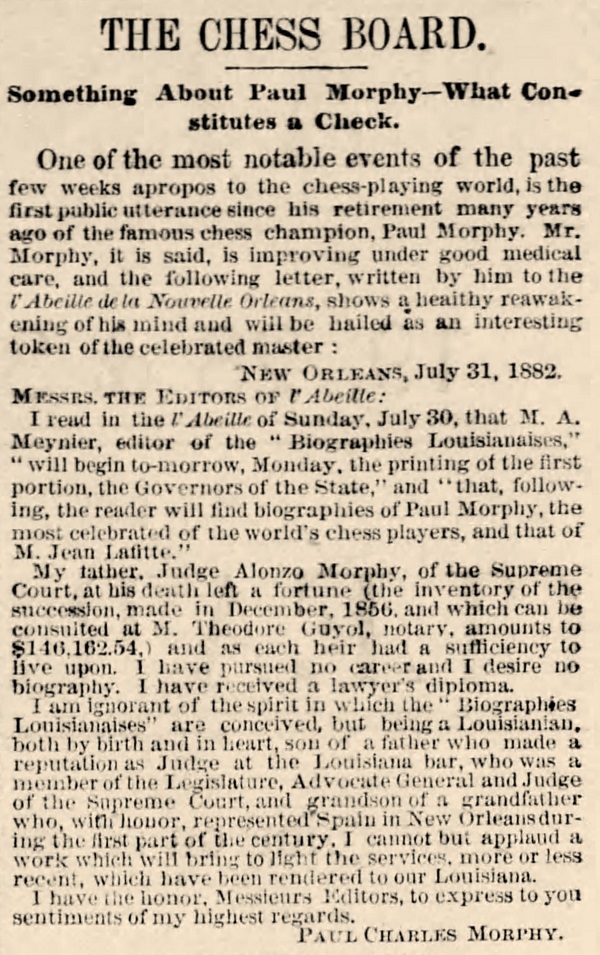
Philadelphia Times, 13 August 1882, page 7
The letter was also published on page 16 of the St Louis Globe-Democrat, 20 August 1882, but any appearance in an English-language newspaper in Morphy’s home state, Louisiana, remains to be found.
At the start of Chapter 25 of his 1976 monograph on Morphy, on pages 307-308, David Lawson gave a different text with, to take an example from the penultimate paragraph, ‘during a part of the first quarter of this century’ instead of, as above, ‘during the first part of the century’:
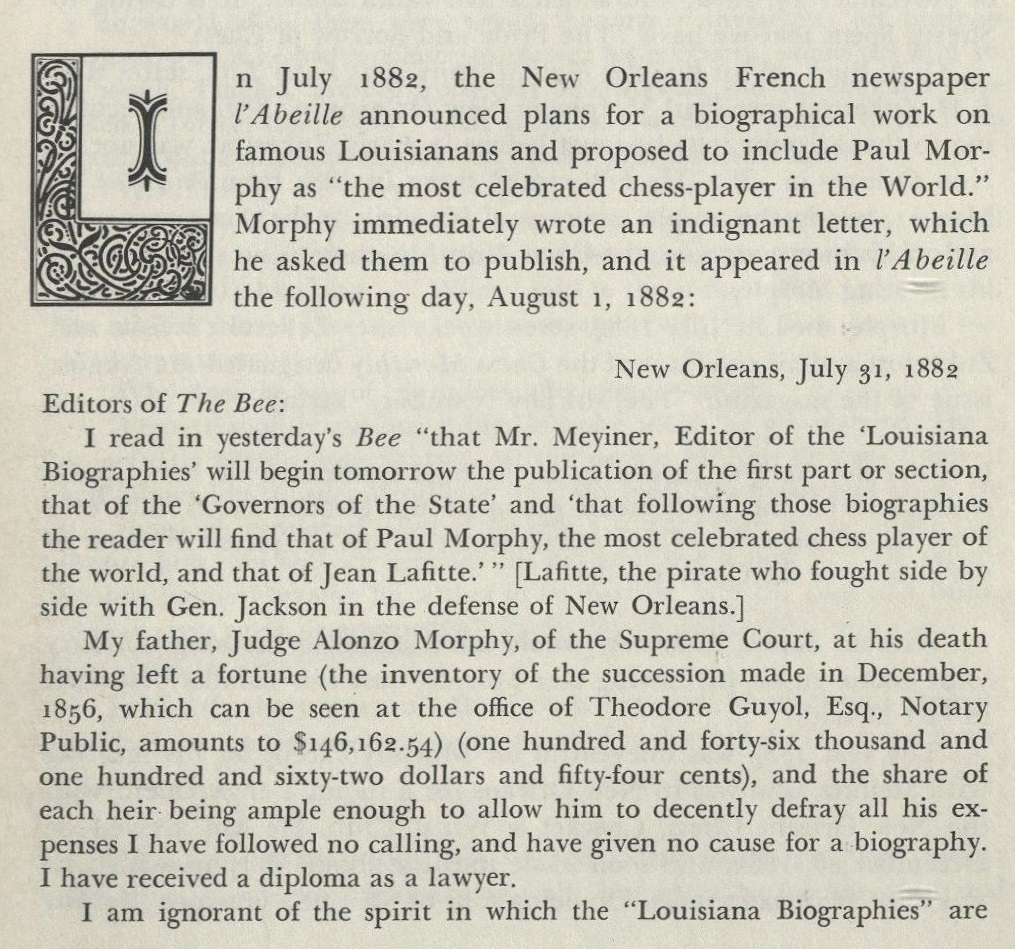
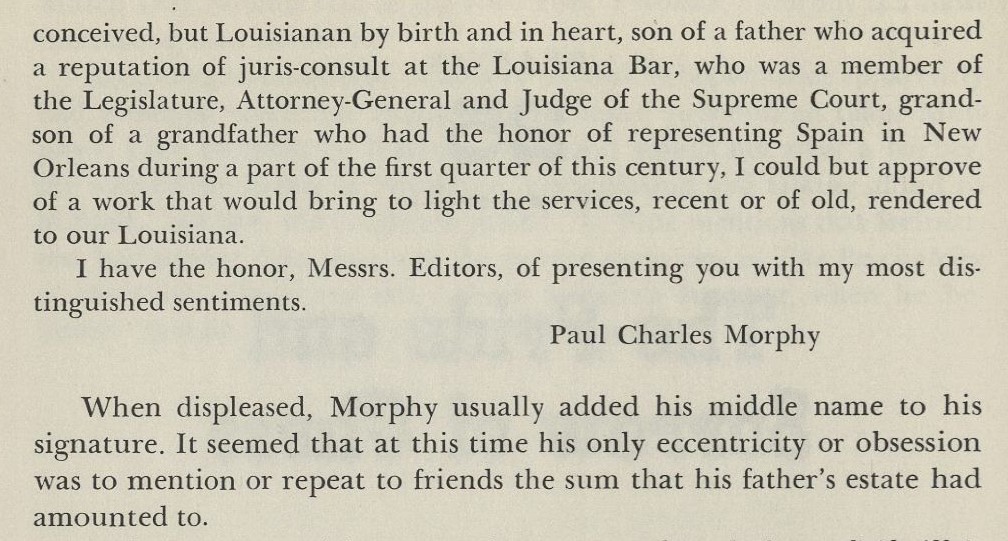
Acknowledgement for the scans from Lawson’s book: Cleveland Public Library
Morphy’s letter was prompted by this item on page 1 of L’Abeille de la Nouvelle-Orléans, 30 July 1882:
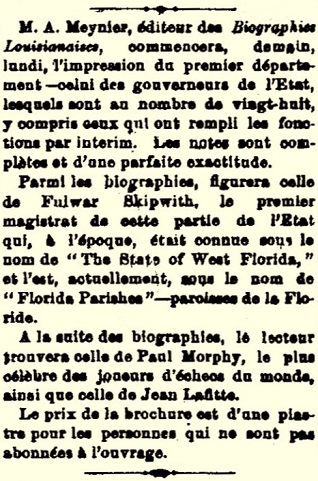
Page 1 of the 1 August 1882 edition gave Morphy’s response:
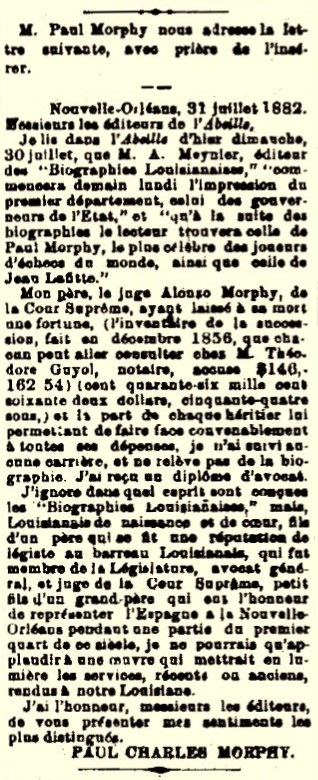
As shown above, Lawson introduced the letter by stating:
‘In July 1882, the New Orleans French newspaper l’Abeille announced plans for a biographical work on famous Louisianans and proposed to include Paul Morphy as “the most celebrated chess-player in the World”.’
However, as also shown above, there was no suggestion in the French-language newspaper that it had any involvement in the ‘Biographies Louisianaises’ project. It was merely announcing an initiative by Meynier (self-published and in English, it will be made clear).
It was rare for Lawson to misspell a name, but in the first line of the letter ‘Meyiner’ should be Meynier. Lawson’s bibliographical section made no mention of anything on Morphy by Meynier.
The publication details of Arthur Meynier’s Louisiana Biographies are complex. Volume one number one can be viewed online. The masthead stated that it was to be ‘published every Saturday by A. Meynier, Jr., 133 Decatur Street’ in New Orleans. That first number is dated 11 February 1882, nearly six months before Morphy’s letter. It consists of eight pages, of which only four had biographies (of Samuel D. McEnery, Randall Lee Gibson and George W. Cable).
In the interests of further confusion, there follows a selection of press notices, in chronological order:
‘We have received the second number of Louisiana Biographies, a weekly magazine, published by A. Meynier, Jr. The number contains well written sketches of the lives of W.C.C. Claiborne, J.J. Audubon, G.T. Beauregard, M.F. Bonzano and E.B.A. Viel, and other interesting articles.’
‘The third number of Meynier’s Louisiana Biographies, published yesterday, contains sketches of James Philip Villere, Benj. F. Jonas, Francis Xavier Martin, Aubert Dubayet, Thos. Treard and Geo. L. Walton.’
‘The fourth number of the weekly magazine of Louisiana Biographies, edited by Mr A. Meynier, Jr, is quite interesting. It contains biographical sketches of John W. Cannon, Edward Bermudez, Charles Gayarre, J.H. Acklen, and other interesting matter. The work, when complete, will be of great value for reference.’
‘The fifth number of Mr A. Meynier, Jr’s weekly magazine of Louisiana biographies is quite interesting and valuable as matter for reference. It contains the biographies of Louis Alfred Wiltz, Pierre Soule, John Lawson Lewis, Adrien Rouquette and J.H. Keller.’
‘The weekly magazine “Louisiana Biographies” has been discontinued. The sketches of prominent citizens which appeared in that publication, with many others, will appear shortly in book forms, and Mr Meynier promises the public a valuable work for reference.’
‘Mr A. Meynier, Jr, the author, compiler and publisher of “Louisiana Biographies”, informs us that the first portion of the work will go to press today. This first part comprises the biographies of all the Governors of the State of Louisiana, comprising that of Fowler [Fulwar] Skipwith, Governor of West Florida, the part of Louisiana now known as the Florida parishes. The volume will also contain an interesting biographical sketch of Paul Morphy, the celebrated chessplayer. Every pains has been taken to make these biographies correct in every particular, the information having been gathered with great care at the most authentic sources. The book will be ready in 10 or 12 days, and will be valuable not only as a source of information and reference, but interesting as reading matter.’
‘We are indebted to the publisher, Mr A. Meynier, Jr., for a copy of Meynier’s Louisiana Biographies, part first. This interesting work will be complete in four parts. The one just out gives sketches of Governors of Louisiana, from William C. Claiborne to Sam McEnery; also of Paul Morphy and Lafitte the pirate.’
‘“Louisiana Biographies – Part I”
A. Meynier, Jr, Publisher
This is the first number of a series of four, which, when bound together, will make a valuable volume for reference. The first part contains the biographies of Governors of Louisiana in chronological order, of Paul Morphy, the chessplayer, and of Lafitte, the pirate. If the remaining numbers present such diversified subjects, this whole gamuet of human interest will be sounded before the series is finished. The biographies of the Governors are necessarily short, on account of their number; but they are written in a concise style, and seem to be historically accurate. This is an age of biographical writings, and the public craves any work that shows the inner life of a great man. From this point of view these sketches are meagre; but their purpose is rather to draw the historical outlines than to fill in the shadings and colorings of the social or domestic life. The biographies of Morphy and Lafitte are on the same order, though the bare history of the latter has a large sensational element in it.
The typographical features of the book are excellent, the paper being strong and thick, and the type large and clear. The Four Parts, bound in cloth, will be $4; in paper, $3.’
‘We have had a call from Mr A. Meynier, Jr, publisher of Louisiana Biographies, New Orleans, La. We have examined part 1 of this new journalistic venture, containing interesting and succinct sketches of all the Governors of Louisiana, Paul Morphy (the chessplayer) and of Lafitte, the pirate. Those biographies are well written, and embrace all the salient features in each public personage forming the subject matter of their contents; they are printed in large, clear type, on excellent white paper, and present a very handsome typographical appearance. Mr Meynier will make Opelousas his headquarters for several days to come, canvassing in the interest of his valuable publication. Complete in four parts, the work will contain 300 pages. Every intelligent Louisianian who desires to be familiar with a history of the prominent men of his State should subscribe to the “Louisiana Biographies”. Prices $3, $4 and $5, according to the binding.’
Google Books records a 71-page work Louisiana Biographies by Arthur Meynier (1882), but we have yet to trace a copy.
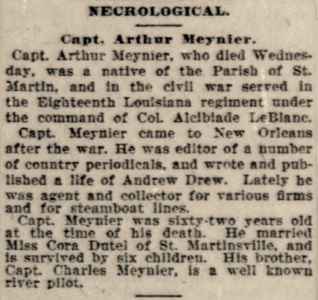
New Orleans Times-Democrat, 26 December 1902, page 12
(12204)
See also The Chess Masters of To-day by Leopold Hoffer.
To the Chess Notes main page.
To the Archives for other feature articles.
Copyright: Edward Winter. All rights reserved.